Millenial Rambles About Supersonic Hogs And Doodles Sometimes (Mostly Sonic Prime and Sonic Games)
Don't wanna be here? Send us removal request.
Text
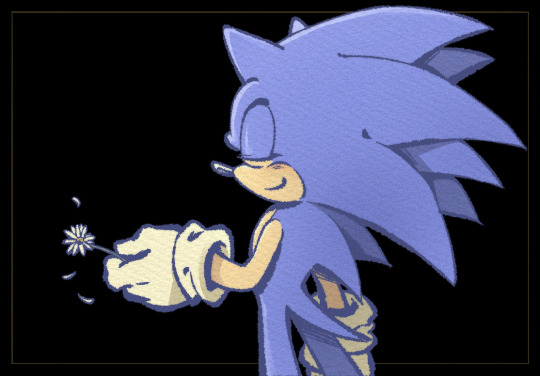
happy birthday to the guy who got me through high school and also changed my life
#It was middle school for me but yeah - thanks Sonic#I didn't have the words for it back then but turns out a blue hedgehog was my aroace awakening#And one of the first neurodivergent-coded characters I saw who wasn't written as a joke#This series in general is good at reminding people that there is nothing wrong with being different#Our differences make us cool actually#sonic the hedgehog#sth#art reblog#fanart
1K notes
·
View notes
Text
Glad to hear that my analysis made you feel validated! ^^
And yeah, I didn't say much about what the Shatterspaces' residents themselves are likely to symbolize (it would have taken way too long in an already lengthy essay), but the idea that they reflect aspects of the Green Hill residents is an interesting one.
Not necessarily the only way to interpret it, mind you: for instance, it could be argued that Dread is the 'trickster' side of Knuckles (which mostly appears in the Sonic & Knuckles game, where Knuckles mocks Sonic and uses traps to keep him off his island - but that game does get referenced in a Sonic Prime flashback, so the writers clearly took inspiration from it), I have also seen some people describe Dread as the mirror opposite of Knuckles, and I think it's a really good take as well. Especially if you go with the theory that the Paradox Prism is partly sentient and creates trials for Sonic until it can be rebuilt: Dread is a fitting obstacle because he represents something Sonic wants (a more carefree Knuckles) but also a threat Sonic doesn't expect (a version of Knuckles who can be deceitful and manipulative).
Either way, it's fitting that those characters come from a 'Prism,' which can reflect light or separate it into different colours, and metaphorically alters your perception ('to see through the prism of' something - like memory or time). Some of the imagery is very evocative too:
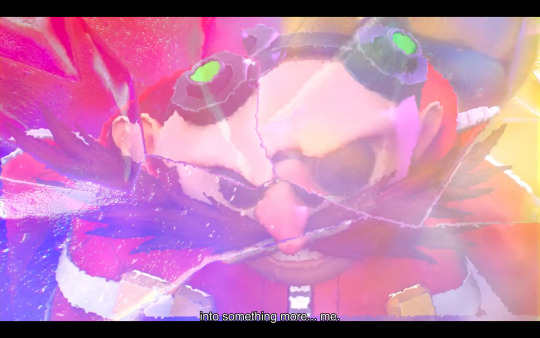
Ironic that Eggman is talking about making Green Hill more like himself here, and he reached that goal by creating New Yolk, but literally tore himself to pieces in the process - even the city got divided into districts because of this, one for each member of the Chaos Council. (Speaking of which, I absolutely love the line: "Conquer, then divide." It's such a ridiculously funny reversal of the 'Divide and conquer' invasion strategy, and surprisingly fitting in context.)
Anyhow - the fun thing about symbolism and storytelling is that they can be interpreted in many ways, and different interpretations can be equally interesting, as long as they fit with the message of the story.
The Shatterverse: Storytelling Through Symbolism
It seems like a lot of people watched Sonic Prime expecting something like Across the Spiderverse: an exploration of canon lore through alternate realities where their favorite characters might have ended up differently (especially dead characters), and the moral dilemma of choosing between saving Sonic’s original friends by sacrificing their Shatterverse alternate versions, or letting them live and losing his original home forever. Alternatively, people just wanted to see their favorite secondary characters again, and a plot centered around the multiverse sounded like a good opportunity to bring back characters like Blaze (who comes from another dimension), or Silver (who is a time-traveller).
But none of that is what Sonic Prime is about. What we got instead was an emotional journey centered on Sonic and his relationships. To fans of the franchise expecting something epic or dark, or as many character cameos as possible, of course this would feel like a letdown. But that doesn’t mean the story is wasting potential: the potential of alternate realities is simply used in a different way, which relies heavily on symbolism for storytelling. And the ending may be controversial (especially the parts that are left ambiguous), but it also serves the message of the story. First and foremost, Sonic Prime is a story about friendship, communication and healing: however you interpret the ending, all the events that took place mattered because the main characters grew from them.
I will elaborate under the cut, but be warned that this essay will be spoiler heavy for the entirety of the Sonic Prime series: I would advise watching it before reading if you haven’t yet. In part 3, I will also be spoiling three stories that I am using for comparison, specifically their endings, because the way they get their messages across is very similar to Sonic Prime. Namely: the movie Jumanji (the 1995 version) by Joe Johnston, the animated movie Spirited Away by Hayao Miyazaki, and Neverending Story by Michael Ende (the novel, not the movie: their endings are very different). Unfortunately, Tumblr doesn’t have a ‘hide spoilers’ feature, so instead, I will use emojis as brackets for these parts: 🎲 for Jumanji, 📖 for Neverending Story and 👻 for Spirited Away, so you can skip those parts if you only want my analysis of Sonic Prime. This post is also very long and image heavy; over 9K words of analysis. I hope that’s fine with you! Here are the three parts’ titles to sum up my main points:
1) The Shatterverse Symbolism: Unstable or Damaged Relationships in Need of Healing
2) Dehumanization and Projection: Who Is ‘Real?’
3) A Defense of Ambiguous Endings: What’s a Paradox?
1) The Shatterverse Symbolism: Unstable or Damaged Relationships in Need of Healing
From the get go, Sonic Prime heavily relies on metaphors and symbolism for storytelling. Sometimes explicitly (like the palm tree being a symbol of connection), other times more subtly: the very landscapes where the action takes place are more conceptual than concrete, and that’s before reality gets broken. (Although, as it will become apparent in part 3 of this essay, time itself is relative in Sonic Prime.)
To understand this point, you have to look no further than the way Sonic talks about Green Hill at the start of the very first episode: "Home is where your friends are, as they say; and that’s Green Hill."
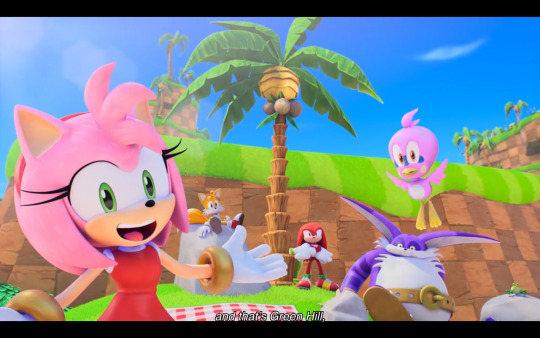
Green Hill is not described as ‘the place where everyone lives together’ or ‘where Sonic’s house is’ (the closest thing to a conventional house we see is Tails’ workshop, and in the games, he has several of those in different places): instead, Green Hill is a symbolic place that represents the entirety of Sonic’s world, emotionally and literally. We can infer that his world is not that small (he does add that Green Hill has "the best beaches, palm trees and chili dogs," so there must be other places to compare them to), but it’s all we need for the purpose of the story, which is why we never get to see what’s past Green Hill’s borders, and no other place within Sonic’s universe is ever mentioned in-story.
Once in the Shatterverse, ‘Green Hill’ becomes synonymous with ‘Sonic’s home world,’ in the same way the dystopian world New Yolk is reduced to a single city. ‘Green Hill’ encompasses everything Sonic lost by shattering his reality: his home, everybody he knows, and his relationships. Green Hill and Sonic’s friends are undistinguishable from each other: home is not a single physical place, it’s the people you want to go back to. And Sonic, being a free spirit who can go wherever he wants, fails to see the fragility of a home, even if he treasures it - because he can’t imagine losing it. Until he does.
The symbolism goes further to serve the story’s message. There is a reason it is called the ‘Shatterverse’ and not the Multiverse: those are not just parallel worlds, they are all ‘broken’ worlds in some capacity, and their inhabitants are as well. Notably, reality ‘shatters’ in ways that reflect the central characters’ issues:
Eggman’s greed and megalomania make him hold on to the Paradox Prism as it breaks: consequently, he gets shattered into five different versions of himself (as many as there are Prism Shards) of varying ages (because the Prism affects space and time), who all end up trapped in the same world, fated to always argue with each other over who is really in charge. The Chaos Council is the perfect foil for Sonic: they don’t love anyone, not even themselves, will use any means necessary to get what they want regardless of who gets hurt in the process, and are never satisfied. But they are also similar to Sonic in ways that cement their status as foils: they are all reckless, tend to act before thinking (especially when provoked), and they never give up. This is what leads them to make a similar mistake to the one Sonic made by breaking the Prism in spite of Tails’ warnings: in their case, they disregard Nine’s warnings about leaving interdimensional portals open for too long, and their negligence causes the entire Shatterverse to start decaying.
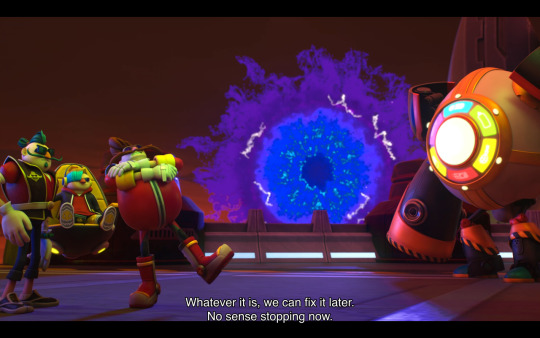
Symbolically, it’s an effective parallel to the cataclysm Sonic caused: his was made with the intent to prevent disaster using the wrong method, it was brief and highly destructive, but entire worlds were born from it (even if all of them were unstable in their own way) - it was akin to a Big Bang, and Sonic makes it his goal to fix what he broke. The Chaos Council on the other hand polluted the Shatterverse for purely selfish reasons, condemning the Shatterspaces and all their residents to a slow death. And unlike Sonic, even if they can learn from their mistakes and accept a truce long enough to save their own skin from the danger they caused, the members of the Chaos Council are incapable of true emotional growth or meaningful connection with others: which is why, in the end, infighting causes their downfall.
Sonic on the other hand breaks reality due to his overconfidence and disregard for the danger the Paradox Prism represents, and the fact that he was relying on his friends without actually listening to them (taking their unconditional support for granted): consequently, Sonic ends up alone in a hostile universe, and gets burdened with the energy of the Paradox Prism - a power he never wanted and can’t properly wield or control on his own. The Prism energy in his body is unstable, upsets his speed, and makes Sonic a living target for anyone who wants his power. Upon realizing his predicament, Sonic immediately goes looking for his friends, only to realize none of the familiar faces he finds remember him, and that all the Shatterspaces (as Nine calls them) are deformed versions of Green Hill where none of the friendships are stable:
New Yolk is a dystopia where Eggman won and built a tyrannical city. Sonic’s friends either got enslaved (Rusty Rose and Citizen 1998), isolated themselves completely (Nine), or are too busy resisting the oppressive power to form any connections outside of the Resistance (Renegade Knux and Rebel Rouge - who have the closest thing to a stable, mutually trusting relationship, but in a context where they constantly fear for each other’s lives and are solely focused on defeating the Chaos Council)
Boscage Maze is an overgrown jungle where nature became unbalanced over time: Thorn Rose is so determined to protect the environment that she is willing to sacrifice her former friends for it by banishing them, and the rest of her former group is reduced to a life of constant paranoia where they scavenge what they can to survive, always on the lookout for the ‘monster’’s next attack
No Place is a flooded world where everybody is a pirate: they seem laid-back and friendly at first, but it quickly becomes apparent that reputation is everything in their world, and Captain Dread’s new crew has been wandering aimlessly since his fall from grace (which is a taboo subject on their ship), and gets regularly picked on by his former crew: under their merry façade, they are adrift in every sense of the word
The Grim is an empty wasteland - nobody lives there
the original Green Hill has been reduced to a colorless ghost of its former self, where echoes of Sonic’s friends repeat a single line over and over: Ghost Hill
These worlds are all ‘shattered’ in a physical and sociological sense, which illustrates the many ways in which what Sonic took for granted can go wrong. It’s a classic case of "you never appreciate what you have until it’s gone," which serves as Sonic’s first wake-up call and starts his character arc.
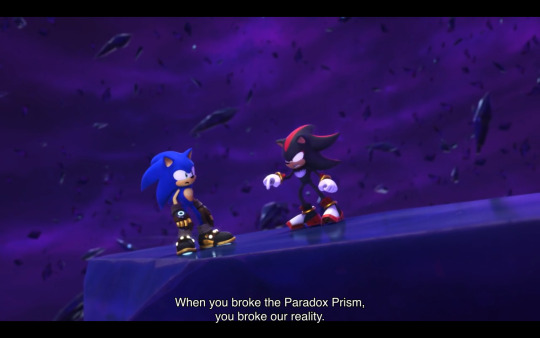
The only relationship Sonic gets to keep in the Shatterverse is the one he can’t define: his rivalry with Shadow. In his introductory speech, after stating that ‘home is where your friends are,’ Sonic divides his acquaintances into friends (Tails, Amy, Knuckles, Rouge, Big and Froggy - not necessarily his only friends, but in Sonic Prime, those six represent his friendships in general), enemy (Eggman) - "and then there is Shadow. It’s… complicated." Shadow is immediately introduced as the odd one out, not quite fitting in Sonic’s definition of ‘home’ even if this world is Shadow’s as much as it is Sonic’s. This is due to the fact that we are mainly experiencing the story from Sonic’s perspective as the focus character, and Sonic doesn’t know where he stands with Shadow.
Symbolically, it’s very meaningful that Shadow is the only Green Hill survivor: he didn’t quite fit in Sonic’s friend group, which is why he is the first to realize that Sonic is upsetting the balance. Unlike the others, he doesn’t trust Sonic enough to simply warn him: as soon as he sees that Sonic poses a threat to the world (intentionally or not), Shadow immediately attacks him. It establishes his character as someone who takes action without relying on anyone else, willing to take down anyone standing in his way for the sake of protecting his world, but terrible at communication. (He never properly explained to Sonic why he suddenly attacked him beyond "You just shook the world!") Later on, Sonic boils it down to Shadow having trouble trusting anyone - he would rather rely on his own power.
Which is why Shadow ends up trapped in an empty Void between worlds, only able to access the ghost version of his former home, essentially powerless. Naturally, Shadow’s first reflex is to take back control of the situation and claim back his autonomy by stealing Sonic’s ability to travel between Shatterspaces, with the intent to fix reality himself. (As Shadow points out, he has no reason to trust Sonic after seeing him literally break reality - even Sonic can’t deny that much.) However, Shadow is forced to realize that this power is not something he can take, because Sonic himself is the key, not the tech he uses.
Emotionally, this scene is pivotal for Shadow in more ways than one: not only did he fail to forcefully trade places with Sonic and take control, Sonic saved his life after the failed attempt nearly got Shadow killed. It naturally leads to his realization that Sonic carries the power to travel between Shatterspaces in his own body (symbolically, Sonic is the glue that brings the Shatterspaces and their residents together), and him acknowledging that he and Sonic need to work together to fix reality.
That makes Shadow a missing piece: even back when Green Hill was whole, his relationship with Sonic was strained. Ironically, their reality shattering becomes an opportunity for them to build something new by learning to trust and rely on each other.
What’s especially interesting is the way their perception of the Shatterspaces and their residents evolves over time, along with their understanding of relationships - what they define as ‘real.’
2) Dehumanization and Projection: Who Is ‘Real?’
This is a question for us viewers as well: what exactly are the Shatterspaces and their residents?
Instead of a detailed exposition or definite answers, Sonic Prime gives us food for thought: across the series, different characters theorize about what the Paradox Prism does and what the Shatterspaces are, but they all draw different conclusions depending on their perspective and the limited information they have at any given time. It’s up to us to decide which theory is the most likely to be correct, or if the answers lie elsewhere.
When Sonic first lands in New Yolk and sees remnants of a destroyed Green Hill underneath the city, he initially assumes that he just ended up in a future of his world where Eggman won. Later on, when Sonic finds a single Prism Shard in New Yolk instead of the whole Paradox Prism, he realizes that New Yolk is a different world entirely: he finally recovers the rest of his missing memories, and concludes that he created this dystopian world by shattering the Prism.
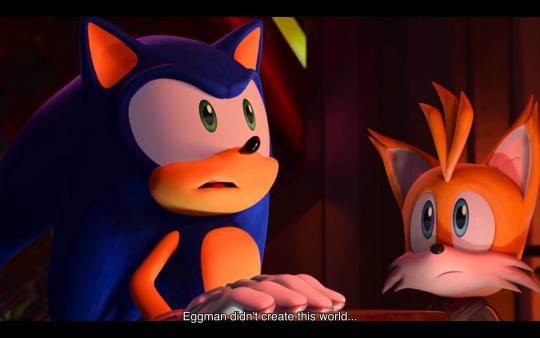
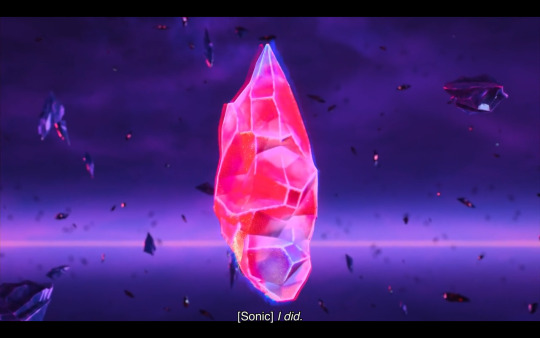
Until this moment, Sonic was clinging to the belief that the familiar people he met were simply future versions of his friends who had forgotten him: he keeps calling them by the wrong names, introducing them to each other based on what they were like in his world, and repeatedly says things like "when you get your memories back."
At this point, Sonic was still confused by his missing recent memories, but even when he does remember and lands in Boscage Maze after getting absorbed by New Yolk’s Prism Shard, Sonic still clings to denial and the hope that the familiar faces he meets there will finally recognize him. He gets more and more distressed when people he sees as friends keep attacking him, and can’t help but try to bring back memories they don’t have, because he has gotten that desperate for connection - which is why Prim is able to manipulate him so easily, and why he doesn’t see Thorn’s backstabbing coming, even if they both have been hostile to him from the start. In short: in these two first worlds, Sonic is constantly projecting his Green Hill friends onto the Shatterspaces’ residents.
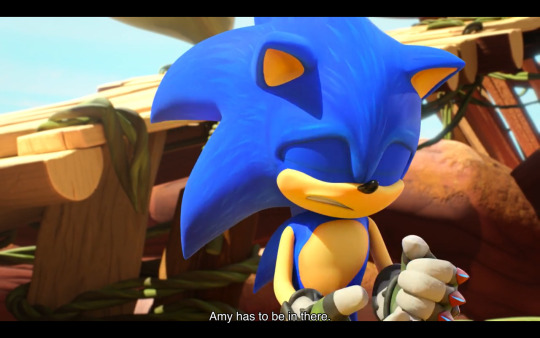
Interestingly, this tendency proves useful in Boscage Maze: because Sonic can’t help but see Amy in Thorn, he can’t dehumanize her the way Prim and her group do by calling Thorn a ‘monster.’ And Sonic can’t agree with Thorn either when she dehumanizes her former friends by calling them ‘scavengers;’ which, in her mind, justifies her banishing them and letting them waste away above the jungle canopy: her goal of protecting the forest blinds her to everything else. In the end, Sonic is able to use his memories of what Amy tried to teach him about communication, connection and balance to bring Thorn to her senses. In a way, he is still projecting, but in the sense that Sonic knows who Amy is at her core, and her potential: to reflect this, he starts to say ‘you’ and ‘her’ interchangeably for Thorn and Amy as two variations of the same person:
Sonic: Well, my friend Amy would say: "Talk about your feelings." But she’s a little corny. Thorn: I don’t know - she sounds pretty great. Sonic: Yeah. You are.
In a sense, Amy is the one saving Thorn from herself through Sonic, who finally understands the value of connection his friends were trying to express by gifting him the palm tree, back in Green Hill. Finding alternate versions of the palm tree in both New Yolk (as the last remnant of their home that the Resistance is trying to protect in the hopes of bringing nature back one day) and Boscage Maze (as the ‘Great Green’ that Thorn worships, not realizing that the palm tree is dying due to the lack of sunlight ever since she shut her friends out, figuratively and literally, and the power of the Prism Shard made the jungle overgrow) reinforces the idea that “everything is connected.” Sonic also realizes that the Shards are a source of discord, and tells Thorn as much, making the metaphor explicit:

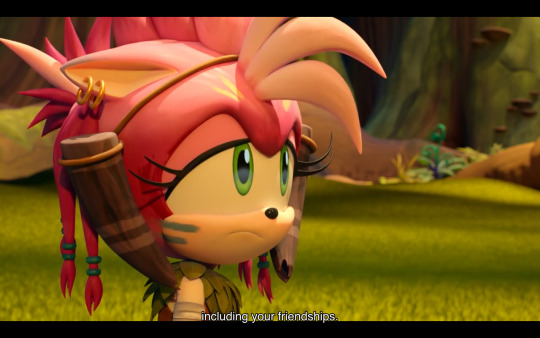
All this leads Sonic to think of the Shatterverse residents as versions of his friends in different circumstances, who never got to meet him and whose realities got corrupted by each Prism Shard. From then on, Sonic actively tries to acknowledge the Shatterspaces as alternate realities: when he gets to No Place, he chastises himself for the parallels he can’t help but draw between Dread and Knuckles, and acts a lot more distrustful towards the pirates after getting attacked so many times in the previous worlds.
Sonic: But no - you’re pirate Knuckles! I’m not taking any chances!
Ironically, Dread is very welcoming initially. His friendly attitude strengthens Sonic’s impression that deep down, they are just like their Green Hill counterparts, and he finally gets an opportunity to take a break and just enjoy time with familiar faces who are actually nice to him for once. Moreover, Sonic is delighted to meet someone he sees as a fun-loving version of Knuckles, and actually calls Dread his "favorite version of Knuckles" to his face.
Only to later realize that the pirates have their own issues centered around another Prism Shard, aptly named ‘The Devil’s Lighthouse,’ a fabled gem with unfathomable power that every pirate covets: going after it, ignoring his former crew’s warnings and sinking his former ship is what ruined Captain Dread’s reputation years ago. Dread tells Sonic to forget about the Shard, because the pirate is well aware that he is likely to relapse and get blinded by greed again if they go after it. (In the same way that Thorn "lost herself in the darkness" of the overgrown jungle after abusing the power of the Shard she calls ‘the Heart of the Forest.’) Which seems to support Sonic’s theory that the Shards bring unbalance to their respective Shatterspaces.
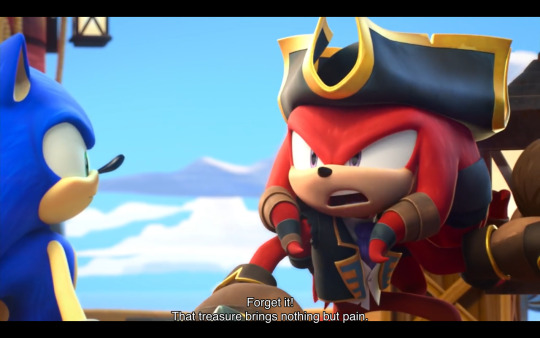
Sonic inevitably gets dragged into the mess regardless, which makes him miss his home even more.
Parallel to all this, while travelling through the Shatterspaces, Sonic gets visions of Shadow urging him to keep going, and trying to tell him that he is trapped in the Void. Sonic is very confused by this, and assumes he is hallucinating - yet when Shadow tells him to keep running without stopping, Sonic listens, even as he is running straight towards a wall.
It does pay off, because going fast is the key to activate Sonic’s ability to teleport from one Shatterspace to another, but Sonic didn’t know it for sure at the time. Despite this, and his doubts that this Shadow he keeps glimpsing is even real, just from the urgency in his voice, Sonic chooses to trust him.
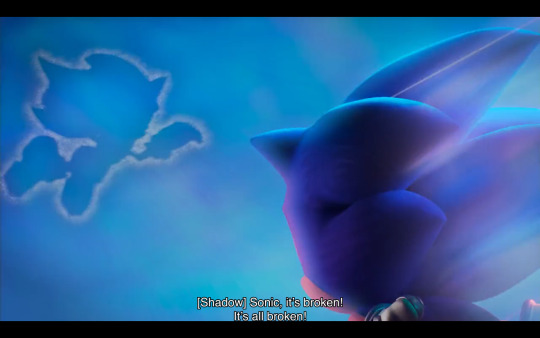
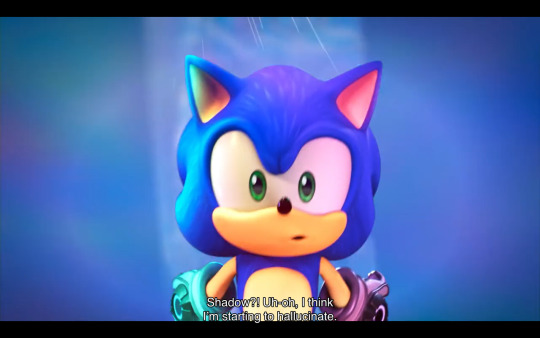
It all comes to a head when Shadow finally manages to intercept Sonic in the Void between Shatterspaces. Initially, Sonic assumes he just landed in a new world with a different version of Shadow. Only this time, Sonic is out of patience:
Sonic: Look, I have no time to deal with whoever you are. I just wanna go home.
Which naturally sets Shadow off because Sonic is the one who destroyed their home in the first place. It takes Shadow saying his name for Sonic to finally realize that the Shadow in front of him is the one he knows from Green Hill; and the way Sonic reacts is very telling:
Sonic: Shadow! You’re… you! The real you! Shadow: The only me!
This outburst shows that, deep down, Sonic still sees the people of Green Hill as the ‘real’ ones, even if he doesn’t fully realize it. He is so relieved to finally find someone he actually knows, then so upset by Shadow’s reveals about Green Hill’s fate, that Sonic has no time to stop and consider the implications of what he said here - but to the viewer, it’s important foreshadowing.
In that same episode, we also get to see Shadow’s perspective, and that the way he views the Shatterspaces is much more radical than Sonic’s. The fact that he calls himself ‘the only me’ has sinister implications: on the one hand, it is true that there are no alternate versions of Shadow in the worlds Sonic has visited (because Shadow teleported out of the way before the Paradox Prism’s blast could shatter him). But more importantly, Shadow is rejecting the very idea that there could ever be other ‘Shadows,’ or any other version of the Green Hill residents. Because, unlike Sonic, Shadow does not see the Shatterspaces as alternate realities: Shadow thinks the Shatterspaces are nothing but "cruel versions to make [them] suffer."
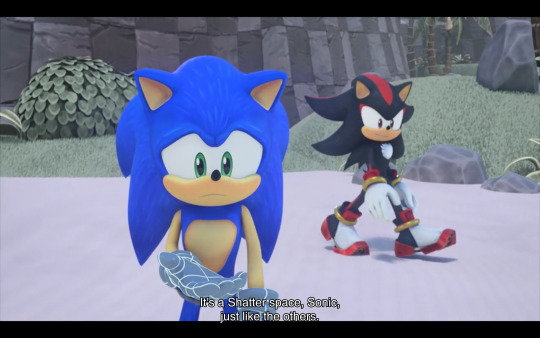
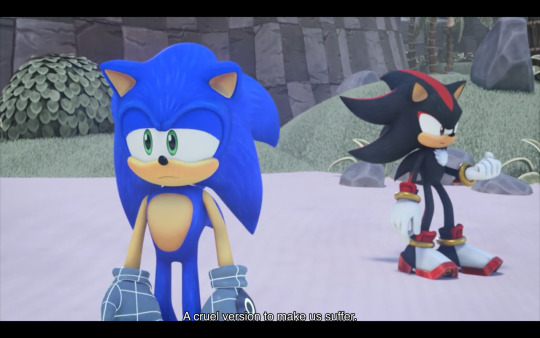
This impression partly comes from the fact that the only Shatterspace Shadow can enter is Ghost Hill, which is incomplete: Shadow himself admits that he can’t figure out whether it’s because this world "is decaying" or "not fully formed." He doesn’t understand why this Gateway is letting him in, either, but to him, it feels "like a ghost." Yet he calls the Shard in the Ghost Hill mountain the "real one," unlike the rest of Ghost Hill and the other Shards, which, according to his theory, create "distorted versions of [their] reality." In short, Shadow doesn’t see Ghost Hill as what remains of his home, but he does see its Shard as a possible chance to get his home back. In Shadow’s eyes, aside from the Shards they need to gather, everything in the Shatterverse is nothing but an illusory obstacle.
Which is why, when Sonic wants to tell Nine about Shadow’s plan to rebuild the Paradox Prism around the Shard in Ghost Hill, Shadow insists that Nine can’t be trusted:
Sonic: What are you talking about? Of course he can! He’s just like Tails! He’s just a little… angsty, that’s all. Shadow: No. He is not Tails, he is Nine. And they are not your real friends!
When Shadow says this, he is not just warning Sonic about the fact that he is clearly projecting, he is saying that none of the Shatterspace residents are actual living people - only illusions. In doing so, Shadow is dehumanizing the Shatterverse residents and making Sonic rightfully fear what Shadow might do to them for the sake of bringing Green Hill (the only ‘real’ world in Shadow’s eyes) back. Hence why Sonic answers by reaffirming that Nine and the Shatterspaces are just as real as they are:
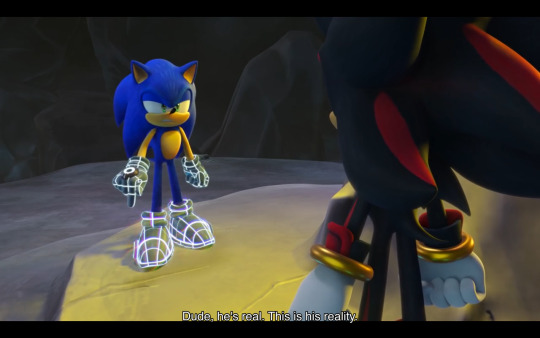
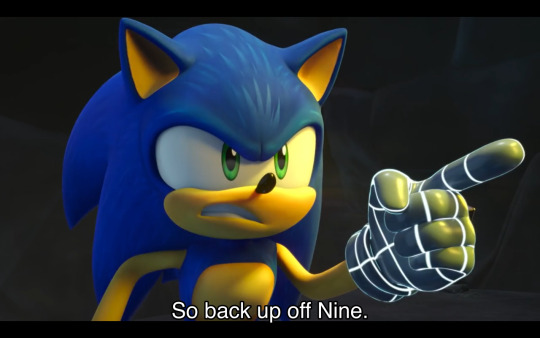
These conflicting views are the reason they fight: Shadow thinks Sonic is deluding himself by thinking of the Shatterverse residents as people, and Sonic wants to protect them from Shadow, whom he knows can be ruthless, especially if he thinks the people in his way aren’t real.
Later on, when the two of them have to work together, Shadow is left with no other choice but to rely on Nine to rebuild the Prism. Shadow is still openly distrustful of Nine, but no longer outright denying that he is ‘real.’ (Possibly because watching Sonic interact with the Shatterverse residents all this time and then meeting Nine face to face made it gradually more difficult for Shadow to deny their personhood.) Instead of telling Sonic off again or confronting Nine directly, Shadow is gentler when he voices his doubts, going as far as to wait until Nine is out of earshot for this exchange with Sonic:
Shadow: How do you know you can trust him? Sonic: Trust is an issue for you, Shadow. That’s why you don’t have any friends. Shadow: I don’t think your ‘friend’ wants the same thing we do.
Even if you can hear obvious sarcasm when Shadow says ‘friend,’ the mere fact that he mentions Nine wanting something different shows that Shadow truly sees Nine as his own person: his distrust no longer comes from the fact that he doesn’t see Nine as real - on the contrary, Shadow sees him as a stranger with his own goals. Unlike Sonic, he sees Nine and Tails as completely separate people; he simply fears that Sonic might be placing his trust in the wrong person. Sonic (rather rudely) dismisses his worries by saying: "Trust is an issue for you Shadow. That’s why you don’t have any friends." The latter may or may not be true (there are subtle hints that Shadow and Rouge are friends in Sonic Prime, but Sonic doesn’t seem to know this, and the series is mainly from his point of view, so there is no way for the viewer to know for sure either), but the former definitely is: Shadow’s trust issues and difficulties to communicate properly are part of the reason he attacked Sonic instead of talking things out at the beginning of the series, and thus failed to prevent the destruction of reality. It is also the reason why they fought when Shadow cornered Sonic in the Void, then fought again over Sonic’s tech in Ghost Hill.
However, things have changed between them since then, especially with them being forced to work together, even from a distance: at this point, Sonic trusts Shadow enough to leave him alone with Nine. Therefore, when the Chaos Council attacks, Sonic leaves the choice up to Shadow: he can stay and keep an eye on Nine while he repairs the Prism if he wants, but Sonic is off to fight the Chaos Council. In the end, even though Shadow still looks conflicted, it doesn’t take five seconds for him to make his choice: he goes after Sonic. Even if Shadow claims that he is just making sure that Sonic won’t mess up again, it is still a leap of faith on Shadow’s part to leave Nine on his own. In spite of his lingering doubts, Shadow is choosing to trust Sonic’s judgement of Nine’s character and their friendship: in and of itself, it’s a show of character growth. (And Sonic is aware of this, which is why he is so happy to see Shadow join him for battle - and also because he is excited about teaming up with him in general.)
Another reason for Shadow’s choice is the fact that Nine has proven his knowledge and ability to handle the Shards: as Sonic reminds Shadow, Nine is the only one capable of restoring the Paradox Prism. Shadow even heard Nine back up his theory that Ghost Hill is "like an embryonic Shatterspace," "like it got stuck in the blueprint stage while forming;" a theory that’s further supported by Sonic’s shoes and gloves looking like blueprints with no special ability in Ghost Hill (even though all the other Shatterspaces give his clothes new abilities thanks to Nine’s tech regulating the Prism energy in Sonic’s body). When Sonic and Shadow take him to the Paradox Prism, Nine warns them both that if they try to restore the Paradox Prism, "the slightest variation can have massive repercussions:"
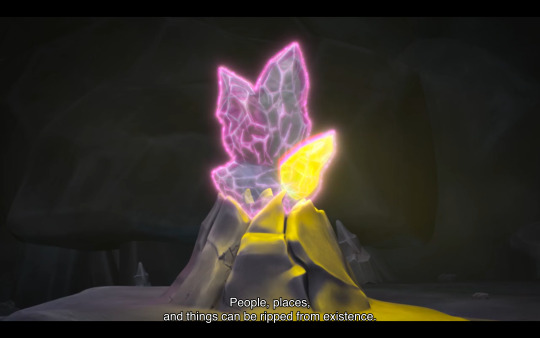
Nine: One small mistake, and poof! Reality is changed forever.
This choice of words has important implications: it suggests that the changes Sonic already caused by shattering the Prism are irreversible. In other words, all the Shatterspaces became real because of Sonic, and they will remain as they are unless Nine makes a mistake while repairing the Prism. Therefore, Nine has much more to lose than Sonic or Shadow if he messes up, which is why Shadow lets him handle it, even if he suspects that Nine has a different motive to restore the Prism.
Unfortunately for Shadow and Sonic, Nine does. In fact, Nine has his own issues with his perception of reality: he grew up in a dystopian world with no one to love him and nobody to love, living underground "to avoid everyone." Before the series even started, Nine’s goal has always been to escape his reality. Initially, he took refuge in solitude, until Sonic’s arrival shook his world literally and figuratively: Sonic is the first person to show him genuine kindness and affection, and speaks of a world where they are best friends and do everything together - a world he lost. Not only that, but Sonic is the one who leads Nine to discover the Prism energy, and through that, a way to travel between worlds by opening portals: as soon as he gets the opportunity, Nine immediately takes the New Yolk Shard for himself and leaves his world behind to explore the Void, without a second thought for the Resistance members he left for dead. Once there, Nine is elated to discover an empty world, which he names ‘the Grim,’ immediately decides to make it his and Sonic’s new home, and persuades himself that Sonic will love this place. Together, they can transform the Grim into a Paradise - everything they ever wanted!
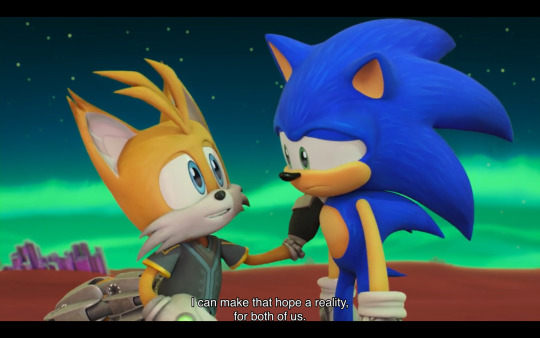
In other words, Nine and Sonic are projecting on each other. Sonic wants to fix his shattered reality, and thinks he can just bring Nine back to Green Hill with him so Nine can have a new home where he can be happy. Meanwhile, Nine wants to create a brand new reality with the only person he trusts, and no one else. The tragedy of their friendship is that, no matter how much they genuinely care about each other, their end goals are irreconcilable.
What’s worse: because they are both constantly under pressure from outside threats, the two of them never get an opportunity to talk things out properly. (When Nine first brings Sonic to the Grim, Sonic can’t give a proper response to Nine’s proposition to live there together because he has to go back to New Yolk to help the Resistance. Then, in Ghost Hill, when Sonic tries to tell Nine that he saw Green Hill briefly pop back into existence while Nine was repairing the Prism, Nine is too focused on his task to listen, and has to send Sonic away to keep the Chaos Council at bay.)
Inevitably, miscommunication leads to disaster when Sonic realizes that Nine never intended to restore Green Hill (Nine doesn’t even believe it’s possible to bring it back), and Nine insists that they have to build a new world because Green Hill “was never (Nine’s) home.”
Nine: Did you even think about what I wanted?! Sonic: I just assumed that after everything we’ve been through, you would see things the way I do. Just like the real Tails would.
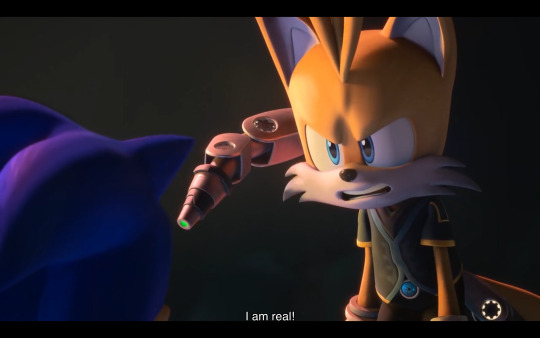
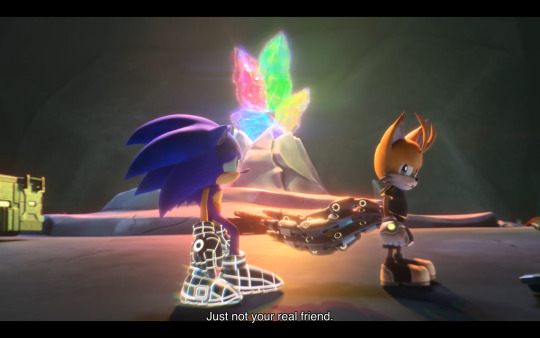
This dialogue sums up everything Sonic Prime is about through the double meaning of ‘real’ in this context. What Sonic blurts out here can be interpreted as a denial of Nine’s personhood: just a replacement for the ‘real’ Tails, whom Sonic never saw as his own person. Of course Nine would be enraged at hearing something like this, and Sonic’s wide-eyed expression and stunned silence at Nine’s outburst speak volumes about how horrified Sonic is at what he just implied with his poor choice of word.
Especially because, as we know, Sonic does see Nine as a real person: he told Shadow as much the first time they went to Ghost Hill. The entire reason they fought was because Sonic wanted to protect Nine from Shadow, who didn’t see Nine as real at the time.
But Nine doesn’t know this, and even if he did, it wouldn’t change the root of the problem: when Sonic brings up ‘the real Tails,’ Nine is forced to realize that Sonic has been projecting Tails onto him all this time, and that Nine can’t compete with Sonic’s ‘real’ best friend from his home world, destroyed or not. In Nine’s eyes, it means that his friendship with Sonic was never real, because Sonic never really saw Nine - only Tails.
And Sonic never considered that Nine could ever see things that way: after all, seeing Amy in Thorn was a good thing. It’s what helped her regain some self-love when she was at her worst, and she certainly didn’t mind the comparison. Similarly, knowing Tails’ abilities allowed Sonic to teach Mangey how to fly. And telling Nine about his past with Tails is the way their own friendship started (symbolized by Nine building the tech that stabilizes the Prism energy in Sonic’s body and allows Sonic to control its powers). Nine was even the one who asked Sonic: "So… So what else did we do?" - expressing a wish to be the fox in Sonic’s stories.
In Sonic’s mind, comparing one friend to another isn’t an issue, because he loves all his friends equally. When Sonic says "the real Tails," or the ‘real’ Shadow, it actually means ‘the one I know’ - as demonstrated by the way Sonic tells Dread: “The Knuckles I know is not a coward.”
But Nine has no frame of reference for friendship. It’s completely new to him, and Sonic is the only friend he ever had. To Nine, love is finite: if there is anyone else in Sonic’s life, that someone can take Nine’s place and "take Sonic away." (Hence his outrage over Shadow helping Sonic escape the Grim in season 3 episode 1: "What?! Shadow thinks he can take Sonic away from me?! Not a chance!") Especially if that someone else is another version of himself: not only are they rivals for Sonic’s affection, they are a threat to Nine’s sense of self. These are the reasons he eventually targets Sails and Mangey: as Tails-lookalikes, not only does he perceive them as a threat to his sense of personhood ("There is only one of me," he says before sending his robots after them. In other words, the other versions of him are not ‘real,’ so it’s justifiable to attack them.) but also as the greatest threats to the reality he wants: a world for him and Sonic only.
And this is yet another form of dehumanization: Nine becomes unhealthily possessive of Sonic, and starts to objectify him. When he realizes that he needs the Prism energy inside Sonic’s body to complete the Prism, he goes after Sonic like a commodity that he is owed, no longer a person he wants by his side. Shadow and the Shatterverse residents all realize that Nine is objectifying Sonic, and all of them are rightfully afraid of what Nine might do to Sonic if he gets his hands on him - which is why they all fight to protect Sonic the same way he has been fighting for them all this time, even with the entire Shatterverse decaying around them all.
Shadow in particular is a great foil for Nine in this instance, because his development and relationship with Sonic, along with the way he views the Shatterspaces and their residents, went in the opposite direction. When Nine steals the Paradox Prism and abandons Sonic and Shadow in the decaying Ghost Hill, we get another pivotal scene that shows how much Shadow has changed since his last fight with Sonic: instead of chastising Sonic for trusting Nine despite his warnings, Shadow’s priority is to escape Ghost Hill with Sonic, who is understandably upset and reluctant to leave the Ghost versions of the Green Hill residents behind - and Shadow has to insist that they aren’t real and can’t be saved. And when that’s not enough to persuade Sonic, Shadow finally recognizes that the other versions of their friends in the Shatterverse are the ‘real’ ones: "the ones who still have a chance."
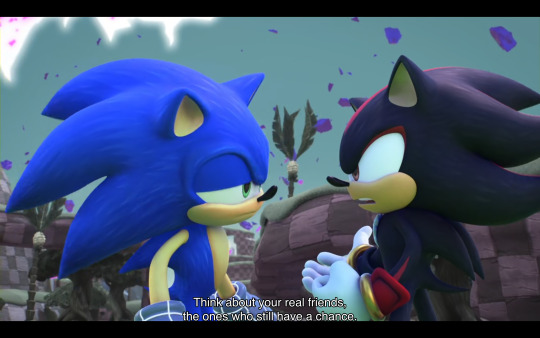
At this point, it could be argued that Shadow is mainly saying this as a way to persuade Sonic to leave, rather than telling him to save himself (because Shadow knows that Sonic always prioritizes saving people over his own safety). But it still reflects the fact that Shadow is finally starting to view the residents of the Shatterverse as their own people, and Sonic’s friendship with them as genuine: a clear contrast to his previous allegation that "they are not your real friends!"
On the other hand, Shadow still views the Green Hill ghosts as ‘not real’ - something Shadow, Nine and Sonic all thought initially. Only for the ghosts to briefly pop back into existence while Nine was repairing the Prism - which proves that their true selves are in there somewhere. Sonic is the only one who witnesses it, which is why he is so reluctant to leave the ghosts behind: unlike Shadow and Nine, Sonic knows they can be saved. Furthermore, them reappearing did not affect Nine or the Chaos Council, which also disproves the common fan theory that none of the alternate versions can exist at the same time as the Green Hill characters, or that they would just fuse back together if the Prism got restored. This scene proves to Sonic and the viewers that all of the characters we met are real.

Symbolically, it also deconstructs the notion that love and friendship are finite: that you can’t love someone ‘as much’ as someone else. (Nine definitely believes this, which is why his immediate assumption is that he was a replacement for Tails all along, and that there can be only one of him). In actuality, Sonic cares about everyone equally; he loves them differently, yes, but equally, which is why he refuses to leave anyone behind when the Shatterverse collapses and Nine targets the stranded pirates in No Place to lure Sonic into a trap. Others (in and out of the show) criticize Sonic for walking into this trap knowingly, but the narrative doesn’t, in this instance: prioritizing his friends was the lesson he had to learn in the first place, rather than ‘solving the situation;’ and then, learning to listen to them.
Nine in particular is the main reason Sonic has come this far, either directly or thanks to the regulators he built so Sonic could control the Prism energy in his body and travel from world to world - and making new connections there. Therefore, it only makes sense symbolically that Nine and Sonic’s fallout would bring the end of the world.
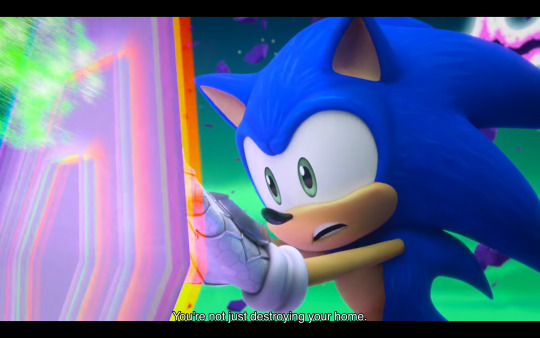
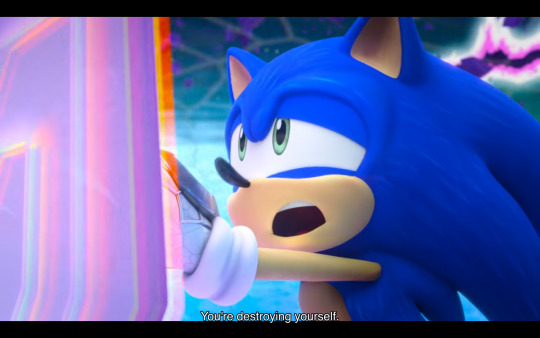
Season 3 focuses on the toll that using the Prism’s power is taking on Nine and the entire Shatterverse: it follows the pattern of the Shards bringing discord and unbalance. The more power he uses, the more self-destructive Nine becomes (attacking his two alternate selves is yet another symbol of his self-destructive behavior), until he purposefully accelerates the Decay to draw Sonic into a corner, which makes Sonic’s friends (and the Chaos Council) all the more determined to take Nine down, leading to more destruction. And as Nine’s only friend, Sonic is the only one who can stop it by interposing himself, finally calming Nine down. (On that note, as far as symbolism goes, it is very fitting that the last use Sonic makes of his Prism energy is to use Nine’s tech to protect them both from everyone else with a summoned shield.)
In fact, Sonic has been consistently prioritizing saving people over gathering the Shards in the series, and always refused to lose faith in his friends, even after getting betrayed and becoming more cautious - because he believes in their potential to be better. So, when left with no other option, it’s only natural for Sonic to sacrifice the Prism energy in his body to save everyone else. And when Nine expresses astonishment that Sonic would do this even after everything he did, Sonic simply answers: "What are friends for?"
The Shatterverse getting restored at the end is symbolic of Sonic’s relationships (and all the others’) being mended. It’s especially important that Nine is the one to do it, because everything started due to a misunderstanding between Sonic and Tails (when Eggman tricked Sonic into unearthing the Paradox Prism despite Tails’ warnings), and escalated with a much bigger misunderstanding between Sonic and Nine: their reconciliation and restored mutual trust is what saves the universe. Not only does Sonic decide to protect Nine despite his betrayal, he has to persuade the others to also put their trust in Nine and let him extract Sonic's Prism energy to restore the Paradox Prism and fix reality, even if it puts his own life at risk. They reluctantly agree, because they all realize that there is no other option if they want to live. Symbolically, choosing to trust someone who can help while knowing the risks is necessary to start healing and move on.
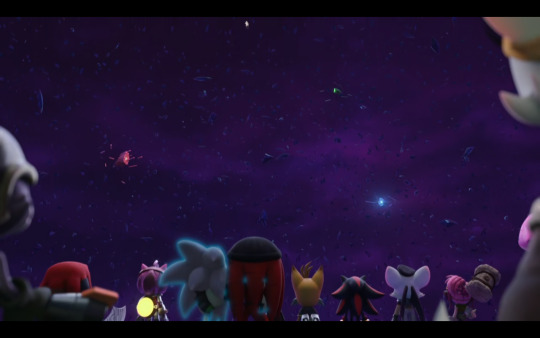
Afterwards, every character working together to bring home a dying Sonic reinforces this symbolism: for once, Sonic is the one reduced to complete powerlessness, being rescued by his friends, coming home literally and figuratively. After all: "Home is where your friends are."
As for what happens to the rest of the Shatterverse and its residents after Sonic and Shadow get home to Green Hill, or to the Paradox Prism after Shadow teleports it away…
We don’t get to find out.
And maybe that’s the point.
3) A Defense of Ambiguous Endings: What’s a Paradox?
This is where I bring up Jumanji, Spirited Away and the Neverending Story novel for comparison. Why those three stories? Well, I can think of a few similarities between them and Sonic Prime: all of them center on characters who leave their world behind and have to find their way home without losing themselves or their loved ones. Jumanji in particular neatly sums up the stakes in the very rules of the titular magical board game:
"Jumanji: a game for those who seek to find a way to leave their world behind. Adventurers beware: do not begin unless you intend to finish. The exciting consequences of the game will vanish only when a player has reached Jumanji and called out its name."
Thanks to these rules, we know the destination from the get-go, and that reaching it will erase the entire adventure - the only question is if and how the characters can make it to the goal.
But if they do reach their goal and erase everything, does it render the adventure pointless? Or does something remain, in the end?
What about a story that ends with unanswered questions? 📖👻🎲Just like Sonic and Shadow or Alan and Sarah, both Bastian (the ordinary child who reads the titular Neverending Story and gets absorbed into the written world of Fantasia) and Chihiro (a young girl who gets trapped in the Spirit World after going through a mysterious tunnel with her parents in the beginning of Spirited Away) make it home at the end of their respective stories. But the book Bastian fell into disappears, and Chihiro’s parents don’t remember anything from the Spirit World. There is no way to confirm what becomes of their respective guides Atreyu and Haku, or any of the other people from Fantasia or the Spirit World.📖👻🎲
Does that make those stories ‘unfinished?’ Or is the lack of answer part of the point those stories are trying to make?
In Sonic Prime’s case, the very fact that the cataclysmic object that starts the plot is called the Paradox Prism has me fully convinced that the ambiguity is entirely intentional and part of the plot.
A paradox is contradictory by design: it invites critical thinking and encourages you to think outside the box. And just like the Shatterspaces, there is a reason why the Paradox Prism is called the way it is: its very name hints at its powers in more ways than one.
In this case, the events of Sonic Prime rely on a time paradox: Sonic fell into the Shatterverse because the Prism got broken, and yet, before this, Shadow saw a vision of himself in the Void, trying to reach Sonic through the New Yolk Gateway.
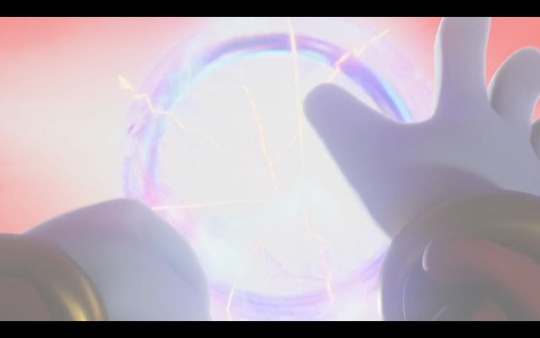
Shadow got this vision as soon as the Prism got unearthed, when Eggman tricked Sonic into powering the blast that fractured the mountain - before the Prism got broken. This vision is what drew Shadow to attack Sonic, because it forewarned him that Sonic was about to shake reality. (Shadow couldn’t tell how exactly, which is why he demanded answers while attacking Sonic - but unfortunately, Sonic had no idea what Shadow was talking about because he didn’t realize that the blast did anything more than damage the mountain.) In other words, Shadow saw Sonic in New Yolk and himself in the Void before the Shatterverse was even created.
It is a paradox, yes, but a paradox that makes sense in the context of Sonic Prime. Because, as it turns out, time flows differently in each Shatterspace: a day in Boscage Maze equals several weeks in New Yolk - in other words, time flows faster in New Yolk, which explains why chronologically, Sonic would already be there before the Prism got broken in Green Hill: what Shadow saw wasn’t a vision from the future, it was a vision of what was already happening in New Yolk. Shadow wasn’t shocked by this, because he is already used to time and space manipulation (that’s what Chaos Control is): he immediately understood that the space-time continuum got damaged, and that Sonic was the cause, because Shadow made the connection between the blast and the Sonic he saw in the Void. This knowledge is what allows Shadow to save himself from shattering: he uses Chaos Control to avoid the blast when Sonic shatters the Prism, and lands in the Void instead.
The resolution of the series follows a similar logic: when Green Hill gets restored, Sonic is brought back to a frozen moment right before the Prism gets shattered (the point in time where the Shatterverse was created), but still has memories of the Shatterverse, because Shadow brought him back through the Gateway before he could disappear - symbolically making their world whole: after Green Hill got restored along with the rest of the Shatterverse and Gateways, Sonic and Shadow were all that was still missing.
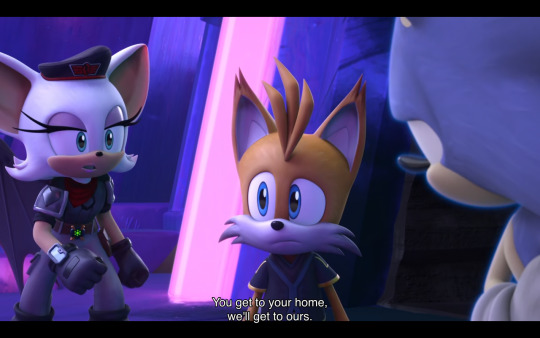
Since it has already been demonstrated that Nine and the Chaos Council could still exist even when the Ghost Hill characters got briefly restored to their former selves, it stands to reason that the rest of the Shatterverse works the same way: this is why the alternate versions of his friends tell Sonic to go back to his world while they go back to theirs. Later on, Sonic ends the time paradox by letting Shadow teleport the Paradox Prism away before it can get broken again, but the fact that it already got broken once in a different reality might be enough for the Shatterverse to keep existing (it is certainly implied by Shadow’s vision of himself in the Void before the Prism got broken).
But if that’s the case, why don’t we get confirmation with a scene showing what has become of the Shatterspaces after Sonic and Shadow got home?
Because the ambiguity is part of the point Sonic Prime is trying to make: the series is focused on Sonic, his point of view, and what he learnt from the journey, so the end of his journey is the only one we get to see. Part of saying goodbye to your friends is not being sure what becomes of them - but trusting that they are going to be okay after they sent you back home.
The same goes for the Shatterverse residents: Nine in particular has to let go of his possessiveness of Sonic and give him a way home to save his life - a fitting illustration of the saying: "If you love someone, set them free." And just like Nine, the other residents of the Shatterverse each do their part to get Sonic home, even if none of them can confirm that he and Shadow made it back safely; all they can do is trust that they both did. Hence Dread’s words of farewell to Sonic: "And know we’ll be rooting for ya!" Even if they never see each other again, the support is still there.
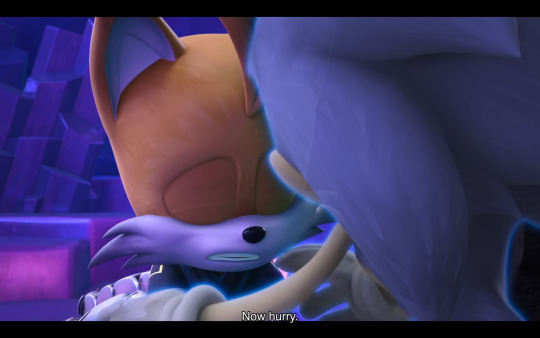
📖👻It is similar to the way Bastian and Atreyu have to part ways in Neverending Story (Atreyu promises to finish the stories that Bastian couldn’t complete in Fantasia, which allows Bastian to escape the book and get his memories back), as well as Chihiro and Haku in Spirited Away (Haku brings Chihiro back to the tunnel leading to the human world, but he has to stay behind in the Spirit World - he still promises to see her again one day).📖👻
🎲 And to a lesser extent, it is also similar to the way Alan and Sarah get separated from Judy and Peter in Jumanji: the game of Jumanji that Alan and Sarah started in 1969 lasted 26 years, and they could only finish it with the help of Judy and Peter, two children they meet in 1995; therefore, when they finish the game, Alan and Sarah are brought back to their original time, where Judy and Peter don’t exist - and Sarah feels that she is starting to forget what being an adult feels like.
"It’s okay," Alan tells her. "As long as we don’t forget each other." "Or Judy and Peter," Sarah adds: Judy and Peter might not exist yet, but Alan and Sarah know enough to save their parents when the time is right - just like Sonic and Shadow know enough to trust each other and resolve to protect the Prism so their reality doesn’t shatter again. 🎲
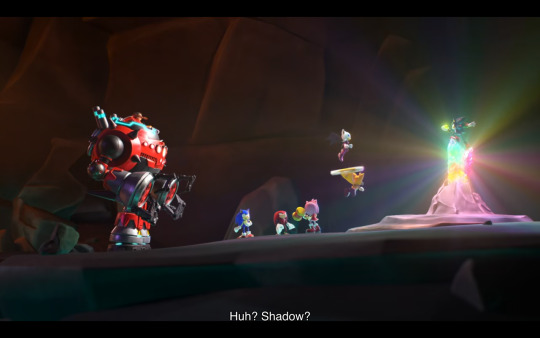
But more importantly, they all came home changed. Sonic is more openly caring, going as far as hugging Eggman when he gets home. 🎲 Similarly, Alan hugs his estranged father at the end of Jumanji (after being chased for 26 years by a hunter conjured from the Jumanji game, played by the same actor as his father), and 🎲 👻 Chihiro thanks the witch Yubaba after the latter is forced to set Chihiro and her parents free - Chihiro even calls the witch ‘granny.’👻
It carries a message about appreciating what you have, even what you perceive as your greatest fear or your worst enemy (because your world isn’t complete if any of them is missing), but especially your closest friends, and trust them to make a brighter future, with or without you.
But you have to do your part. And one day, you might get to see the people you loved and lost again. 🎲 In Alan and Sarah’s case, they do get to see Judy and Peter again, and the latter two sadly don’t remember them: from their perspective, their adventure never happened - yet it makes all the difference, because Alan and Sarah can dissuade their parents from going to the trip that would have gotten them killed. As for whether or not Judy and Peter will ever remember, or become as close to Alan and Sarah as they used to be - we don’t know, but we trust that they will be fine.
On the other hand, we do know that the Jumanji couldn’t be destroyed, and is still out there targeting children for another deadly game - an open ending that is typical of horror movies: the main characters’ story might be over, but the monster remains undefeated. Jumanji might not be advertised as a horror movie, but it uses the trope in a similar way, because this movie is about fighting your fears: Alan and Sarah successfully conquered their fears, but the viewer knows the threat is still out there, and that someone else will inevitably fall into the trap. The message is that fear will always exist, but it can always be conquered. 🎲
📖👻 Neverending Story and Spirited Away take the ambiguity further: the question of whether or not they will see their friends again is left unanswered for both Bastian and Chihiro. The never-ending book is gone from the library when Bastian comes back to his reality: the librarian Mister Correander only gives Bastian the hope that he might get to see the Little Empress of Fantasia again someday, then sends him home to his father (but we don’t actually see Bastian reunite with his father): the ending is open because Neverending Story is all about the power of imagination, and urges the reader to come up with new stories so ‘Fantasia’ can live on. And in Spirited Away, when she gets back to the human world, all Chihiro has left from the Spirit World is the hairband the witch Zeniba gave her for protection, and Haku’s promise to see her again one day. And more importantly, Zeniba’s reassurance that "Once you've met someone, you never really forget them. It just takes a while for your memories to return." 📖👻
Similarly, in Sonic Prime, Sonic is left with a threat from the Chaos Council when they get banished: "You haven’t heard the last of us!" It may well be an empty threat. However, after Sonic goes back to Green Hill and defeats Eggman, a familiar explosion interrupts Sonic’s celebratory picnic with his friends at the end: an explosion that looks just like the blasts the Paradox Prism causes every time someone uses its power on a large scale.
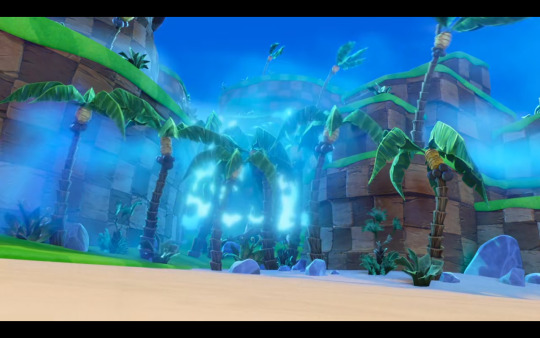
We don’t actually get to see the threat aside from an ominous shadow looming over Sonic and his friends, and Sonic’s exasperated reaction: "You have got to be kidding me." However, whatever the threat is, Sonic doesn’t let it phase him for long: he knows he can face whatever comes at him, because he’s not facing it alone.
We also know that Sonic was about to tell his friends in Green Hill about the Shatterverse before he got interrupted by said explosion, so at the very least, the memories of what happened will be preserved.
And as for us, well; we already know we’ll get to see at least three familiar faces again in Sonic Racing: CrossWorlds. Who knows what might come next?
It’s ultimately up to the viewers to decide how they interpret an ambiguous ending: are the Shatterverse residents only facets of the Green Hill characters, who are the ‘real’ ones? Or are they all their own people, ‘real’ in their own right?
And after the ending, did the Shatterspaces and their residents disappear along with the unbroken Paradox Prism (or ‘fused back’ into their respective Green Hill selves), or are they still living their own lives? If they are, do they remember what happened?
Does the explosion at the end mean that interdimensional travel is still possible? Nine and the Chaos Council did use residual Prism energy to open portals without a Shard in the past, so it might still be possible after the end.
Speaking of Nine, people’s frustration at the ending mostly comes from the uncertainty of his fate: is he fated to stay alone in the Grim in a "be careful what you wish for" type of ending as a narrative punishment for the destruction he caused? Can he actually be happy alone in the Grim, as he claims? Or did his saving the Shatterverse and letting Sonic go set him free, able to use a portal with residual energy to go wherever he wants? After Nine teamed up with them to banish the Chaos Council, would the Resistance forgive him his past betrayal, welcome him back to their home world, and encourage Nine to bring nature back to New Yolk, so they can have the better life they all wanted? Or would Nine change his mind and join Sonic in Green Hill after all?
We don’t know, but the important thing is that the choice is up to Nine: just like Nine had to let Sonic go, Sonic had to stop assuming that he knew what Nine wanted better than Nine did. Both of them stopped trying to project their own wishes onto the other: when Sonic is ready to sacrifice himself, first, he makes everyone "promise to leave Nine alone" and "let him live peacefully in his new home in the Grim," then makes Nine promise he won’t cause any more trouble in the other Shatterspaces either. By doing this, Sonic is respecting Nine’s wishes and letting him have agency: if Nine truly thinks he would rather stay in the Grim, Sonic will let him. And when all is said and done, Nine hugging Sonic goodbye (initiating it for the first time) shows that he has grown enough to be more honest about his own emotions, and let himself be vulnerable, even in front of people he used to see as enemies.
But the more important part is Sonic’s parting words to all of the Shatterverse residents before he has to leave them for good. All Sonic can really ask of them at the end is:
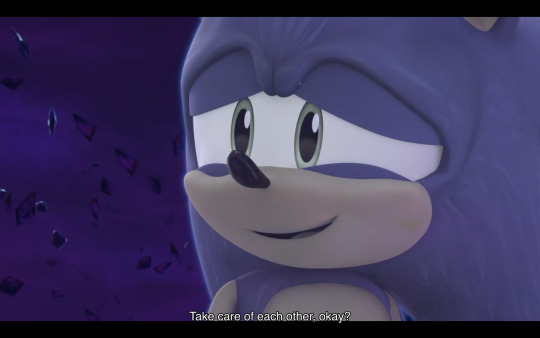
This is directed at all of them, including Nine - and if they all take it to heart and do decide to help each other out, then Nine should be fine.
That being said, the ending is still up to interpretation. Personally, I think the evidence points to all the characters being real and able to exist in their separate worlds even after the ending; it would be a fitting symbol of friendship transcending time and space, even if it is wrapped in uncertainty.
However you interpret them, there is something poetic about ambiguous endings for stories like Sonic Prime’s: they illustrate that relationships are always fragile and full of uncertainties; just like the Paradox Prism. And that’s all the more reason to treasure them.
#Thank you for all of your kind notes in the reblogs‚ everyone‚ I really appreciate them! <3#Speaking of Dread‚ I do want to write more about what he may symbolize in relation to Knuckles‚ Renegade Knucks‚ and how Sonic views them#And it IS Pride Month sooo#First post about shipping next time? It could be fun!#Guess I'll see if I can write a shipping analysis before the end of the month#Quill answers#self reblog#sonic prime#knuckles the echidna#knuckles the dread#sonic the hedgehog#eggman#chaos council#symbolism#character analysis#paradox prism
45 notes
·
View notes
Note
Wouldn't it be funny if we were all wrong and Metal Sonic teams up with Batman instead of fighting him because Eggman's truce with the Justice League is still in effect?
IDW Sonic X DC Comics Issue 4 has Metal Sonic fighting Batman. Do you expect Metal Sonic to hold his own against the Justice League? Or do you expect the Justice League will victory stomp Metal Sonic in this comic?

Thanks for the poll! Polls for the Sonic fandom on just about anything. Share polls you like to get more data. Asks and submissions always open.
#The crossover has been surprisingly good so far!#I really love the artstyle in particular#But all the character interactions are fun too - the authors are clearly having a blast writing and drawing this comic#It's almost a shame we will only get five issues but given the format the result is impressive#sonic x dc#sonic x dc spoilers#metal sonic#batman#eggman#justice league#Sth#Dc comics#I have no genuine interest in powerscaling but I do love Sonic and The Flash's friendly banter over who is faster#I hope The Flash tries the same thing with Metal Sonic only to be met with angry silence it would be hilarious
43 notes
·
View notes
Text
The Shatterverse: Storytelling Through Symbolism
It seems like a lot of people watched Sonic Prime expecting something like Across the Spiderverse: an exploration of canon lore through alternate realities where their favorite characters might have ended up differently (especially dead characters), and the moral dilemma of choosing between saving Sonic’s original friends by sacrificing their Shatterverse alternate versions, or letting them live and losing his original home forever. Alternatively, people just wanted to see their favorite secondary characters again, and a plot centered around the multiverse sounded like a good opportunity to bring back characters like Blaze (who comes from another dimension), or Silver (who is a time-traveller).
But none of that is what Sonic Prime is about. What we got instead was an emotional journey centered on Sonic and his relationships. To fans of the franchise expecting something epic or dark, or as many character cameos as possible, of course this would feel like a letdown. But that doesn’t mean the story is wasting potential: the potential of alternate realities is simply used in a different way, which relies heavily on symbolism for storytelling. And the ending may be controversial (especially the parts that are left ambiguous), but it also serves the message of the story. First and foremost, Sonic Prime is a story about friendship, communication and healing: however you interpret the ending, all the events that took place mattered because the main characters grew from them.
I will elaborate under the cut, but be warned that this essay will be spoiler heavy for the entirety of the Sonic Prime series: I would advise watching it before reading if you haven’t yet. In part 3, I will also be spoiling three stories that I am using for comparison, specifically their endings, because the way they get their messages across is very similar to Sonic Prime. Namely: the movie Jumanji (the 1995 version) by Joe Johnston, the animated movie Spirited Away by Hayao Miyazaki, and Neverending Story by Michael Ende (the novel, not the movie: their endings are very different). Unfortunately, Tumblr doesn’t have a ‘hide spoilers’ feature, so instead, I will use emojis as brackets for these parts: 🎲 for Jumanji, 📖 for Neverending Story and 👻 for Spirited Away, so you can skip those parts if you only want my analysis of Sonic Prime. This post is also very long and image heavy; over 9K words of analysis. I hope that’s fine with you! Here are the three parts’ titles to sum up my main points:
1) The Shatterverse Symbolism: Unstable or Damaged Relationships in Need of Healing
2) Dehumanization and Projection: Who Is ‘Real?’
3) A Defense of Ambiguous Endings: What’s a Paradox?
1) The Shatterverse Symbolism: Unstable or Damaged Relationships in Need of Healing
From the get go, Sonic Prime heavily relies on metaphors and symbolism for storytelling. Sometimes explicitly (like the palm tree being a symbol of connection), other times more subtly: the very landscapes where the action takes place are more conceptual than concrete, and that’s before reality gets broken. (Although, as it will become apparent in part 3 of this essay, time itself is relative in Sonic Prime.)
To understand this point, you have to look no further than the way Sonic talks about Green Hill at the start of the very first episode: "Home is where your friends are, as they say; and that’s Green Hill."

Green Hill is not described as ‘the place where everyone lives together’ or ‘where Sonic’s house is’ (the closest thing to a conventional house we see is Tails’ workshop, and in the games, he has several of those in different places): instead, Green Hill is a symbolic place that represents the entirety of Sonic’s world, emotionally and literally. We can infer that his world is not that small (he does add that Green Hill has "the best beaches, palm trees and chili dogs," so there must be other places to compare them to), but it’s all we need for the purpose of the story, which is why we never get to see what’s past Green Hill’s borders, and no other place within Sonic’s universe is ever mentioned in-story.
Once in the Shatterverse, ‘Green Hill’ becomes synonymous with ‘Sonic’s home world,’ in the same way the dystopian world New Yolk is reduced to a single city. ‘Green Hill’ encompasses everything Sonic lost by shattering his reality: his home, everybody he knows, and his relationships. Green Hill and Sonic’s friends are undistinguishable from each other: home is not a single physical place, it’s the people you want to go back to. And Sonic, being a free spirit who can go wherever he wants, fails to see the fragility of a home, even if he treasures it - because he can’t imagine losing it. Until he does.
The symbolism goes further to serve the story’s message. There is a reason it is called the ‘Shatterverse’ and not the Multiverse: those are not just parallel worlds, they are all ‘broken’ worlds in some capacity, and their inhabitants are as well. Notably, reality ‘shatters’ in ways that reflect the central characters’ issues:
Eggman’s greed and megalomania make him hold on to the Paradox Prism as it breaks: consequently, he gets shattered into five different versions of himself (as many as there are Prism Shards) of varying ages (because the Prism affects space and time), who all end up trapped in the same world, fated to always argue with each other over who is really in charge. The Chaos Council is the perfect foil for Sonic: they don’t love anyone, not even themselves, will use any means necessary to get what they want regardless of who gets hurt in the process, and are never satisfied. But they are also similar to Sonic in ways that cement their status as foils: they are all reckless, tend to act before thinking (especially when provoked), and they never give up. This is what leads them to make a similar mistake to the one Sonic made by breaking the Prism in spite of Tails’ warnings: in their case, they disregard Nine’s warnings about leaving interdimensional portals open for too long, and their negligence causes the entire Shatterverse to start decaying.

Symbolically, it’s an effective parallel to the cataclysm Sonic caused: his was made with the intent to prevent disaster using the wrong method, it was brief and highly destructive, but entire worlds were born from it (even if all of them were unstable in their own way) - it was akin to a Big Bang, and Sonic makes it his goal to fix what he broke. The Chaos Council on the other hand polluted the Shatterverse for purely selfish reasons, condemning the Shatterspaces and all their residents to a slow death. And unlike Sonic, even if they can learn from their mistakes and accept a truce long enough to save their own skin from the danger they caused, the members of the Chaos Council are incapable of true emotional growth or meaningful connection with others: which is why, in the end, infighting causes their downfall.
Sonic on the other hand breaks reality due to his overconfidence and disregard for the danger the Paradox Prism represents, and the fact that he was relying on his friends without actually listening to them (taking their unconditional support for granted): consequently, Sonic ends up alone in a hostile universe, and gets burdened with the energy of the Paradox Prism - a power he never wanted and can’t properly wield or control on his own. The Prism energy in his body is unstable, upsets his speed, and makes Sonic a living target for anyone who wants his power. Upon realizing his predicament, Sonic immediately goes looking for his friends, only to realize none of the familiar faces he finds remember him, and that all the Shatterspaces (as Nine calls them) are deformed versions of Green Hill where none of the friendships are stable:
New Yolk is a dystopia where Eggman won and built a tyrannical city. Sonic’s friends either got enslaved (Rusty Rose and Citizen 1998), isolated themselves completely (Nine), or are too busy resisting the oppressive power to form any connections outside of the Resistance (Renegade Knux and Rebel Rouge - who have the closest thing to a stable, mutually trusting relationship, but in a context where they constantly fear for each other’s lives and are solely focused on defeating the Chaos Council)
Boscage Maze is an overgrown jungle where nature became unbalanced over time: Thorn Rose is so determined to protect the environment that she is willing to sacrifice her former friends for it by banishing them, and the rest of her former group is reduced to a life of constant paranoia where they scavenge what they can to survive, always on the lookout for the ‘monster’’s next attack
No Place is a flooded world where everybody is a pirate: they seem laid-back and friendly at first, but it quickly becomes apparent that reputation is everything in their world, and Captain Dread’s new crew has been wandering aimlessly since his fall from grace (which is a taboo subject on their ship), and gets regularly picked on by his former crew: under their merry façade, they are adrift in every sense of the word
The Grim is an empty wasteland - nobody lives there
the original Green Hill has been reduced to a colorless ghost of its former self, where echoes of Sonic’s friends repeat a single line over and over: Ghost Hill
These worlds are all ‘shattered’ in a physical and sociological sense, which illustrates the many ways in which what Sonic took for granted can go wrong. It’s a classic case of "you never appreciate what you have until it’s gone," which serves as Sonic’s first wake-up call and starts his character arc.

The only relationship Sonic gets to keep in the Shatterverse is the one he can’t define: his rivalry with Shadow. In his introductory speech, after stating that ‘home is where your friends are,’ Sonic divides his acquaintances into friends (Tails, Amy, Knuckles, Rouge, Big and Froggy - not necessarily his only friends, but in Sonic Prime, those six represent his friendships in general), enemy (Eggman) - "and then there is Shadow. It’s… complicated." Shadow is immediately introduced as the odd one out, not quite fitting in Sonic’s definition of ‘home’ even if this world is Shadow’s as much as it is Sonic’s. This is due to the fact that we are mainly experiencing the story from Sonic’s perspective as the focus character, and Sonic doesn’t know where he stands with Shadow.
Symbolically, it’s very meaningful that Shadow is the only Green Hill survivor: he didn’t quite fit in Sonic’s friend group, which is why he is the first to realize that Sonic is upsetting the balance. Unlike the others, he doesn’t trust Sonic enough to simply warn him: as soon as he sees that Sonic poses a threat to the world (intentionally or not), Shadow immediately attacks him. It establishes his character as someone who takes action without relying on anyone else, willing to take down anyone standing in his way for the sake of protecting his world, but terrible at communication. (He never properly explained to Sonic why he suddenly attacked him beyond "You just shook the world!") Later on, Sonic boils it down to Shadow having trouble trusting anyone - he would rather rely on his own power.
Which is why Shadow ends up trapped in an empty Void between worlds, only able to access the ghost version of his former home, essentially powerless. Naturally, Shadow’s first reflex is to take back control of the situation and claim back his autonomy by stealing Sonic’s ability to travel between Shatterspaces, with the intent to fix reality himself. (As Shadow points out, he has no reason to trust Sonic after seeing him literally break reality - even Sonic can’t deny that much.) However, Shadow is forced to realize that this power is not something he can take, because Sonic himself is the key, not the tech he uses.
Emotionally, this scene is pivotal for Shadow in more ways than one: not only did he fail to forcefully trade places with Sonic and take control, Sonic saved his life after the failed attempt nearly got Shadow killed. It naturally leads to his realization that Sonic carries the power to travel between Shatterspaces in his own body (symbolically, Sonic is the glue that brings the Shatterspaces and their residents together), and him acknowledging that he and Sonic need to work together to fix reality.
That makes Shadow a missing piece: even back when Green Hill was whole, his relationship with Sonic was strained. Ironically, their reality shattering becomes an opportunity for them to build something new by learning to trust and rely on each other.
What’s especially interesting is the way their perception of the Shatterspaces and their residents evolves over time, along with their understanding of relationships - what they define as ‘real.’
2) Dehumanization and Projection: Who Is ‘Real?’
This is a question for us viewers as well: what exactly are the Shatterspaces and their residents?
Instead of a detailed exposition or definite answers, Sonic Prime gives us food for thought: across the series, different characters theorize about what the Paradox Prism does and what the Shatterspaces are, but they all draw different conclusions depending on their perspective and the limited information they have at any given time. It’s up to us to decide which theory is the most likely to be correct, or if the answers lie elsewhere.
When Sonic first lands in New Yolk and sees remnants of a destroyed Green Hill underneath the city, he initially assumes that he just ended up in a future of his world where Eggman won. Later on, when Sonic finds a single Prism Shard in New Yolk instead of the whole Paradox Prism, he realizes that New Yolk is a different world entirely: he finally recovers the rest of his missing memories, and concludes that he created this dystopian world by shattering the Prism.


Until this moment, Sonic was clinging to the belief that the familiar people he met were simply future versions of his friends who had forgotten him: he keeps calling them by the wrong names, introducing them to each other based on what they were like in his world, and repeatedly says things like "when you get your memories back."
At this point, Sonic was still confused by his missing recent memories, but even when he does remember and lands in Boscage Maze after getting absorbed by New Yolk’s Prism Shard, Sonic still clings to denial and the hope that the familiar faces he meets there will finally recognize him. He gets more and more distressed when people he sees as friends keep attacking him, and can’t help but try to bring back memories they don’t have, because he has gotten that desperate for connection - which is why Prim is able to manipulate him so easily, and why he doesn’t see Thorn’s backstabbing coming, even if they both have been hostile to him from the start. In short: in these two first worlds, Sonic is constantly projecting his Green Hill friends onto the Shatterspaces’ residents.

Interestingly, this tendency proves useful in Boscage Maze: because Sonic can’t help but see Amy in Thorn, he can’t dehumanize her the way Prim and her group do by calling Thorn a ‘monster.’ And Sonic can’t agree with Thorn either when she dehumanizes her former friends by calling them ‘scavengers;’ which, in her mind, justifies her banishing them and letting them waste away above the jungle canopy: her goal of protecting the forest blinds her to everything else. In the end, Sonic is able to use his memories of what Amy tried to teach him about communication, connection and balance to bring Thorn to her senses. In a way, he is still projecting, but in the sense that Sonic knows who Amy is at her core, and her potential: to reflect this, he starts to say ‘you’ and ‘her’ interchangeably for Thorn and Amy as two variations of the same person:
Sonic: Well, my friend Amy would say: "Talk about your feelings." But she’s a little corny. Thorn: I don’t know - she sounds pretty great. Sonic: Yeah. You are.
In a sense, Amy is the one saving Thorn from herself through Sonic, who finally understands the value of connection his friends were trying to express by gifting him the palm tree, back in Green Hill. Finding alternate versions of the palm tree in both New Yolk (as the last remnant of their home that the Resistance is trying to protect in the hopes of bringing nature back one day) and Boscage Maze (as the ‘Great Green’ that Thorn worships, not realizing that the palm tree is dying due to the lack of sunlight ever since she shut her friends out, figuratively and literally, and the power of the Prism Shard made the jungle overgrow) reinforces the idea that “everything is connected.” Sonic also realizes that the Shards are a source of discord, and tells Thorn as much, making the metaphor explicit:


All this leads Sonic to think of the Shatterverse residents as versions of his friends in different circumstances, who never got to meet him and whose realities got corrupted by each Prism Shard. From then on, Sonic actively tries to acknowledge the Shatterspaces as alternate realities: when he gets to No Place, he chastises himself for the parallels he can’t help but draw between Dread and Knuckles, and acts a lot more distrustful towards the pirates after getting attacked so many times in the previous worlds.
Sonic: But no - you’re pirate Knuckles! I’m not taking any chances!
Ironically, Dread is very welcoming initially. His friendly attitude strengthens Sonic’s impression that deep down, they are just like their Green Hill counterparts, and he finally gets an opportunity to take a break and just enjoy time with familiar faces who are actually nice to him for once. Moreover, Sonic is delighted to meet someone he sees as a fun-loving version of Knuckles, and actually calls Dread his "favorite version of Knuckles" to his face.
Only to later realize that the pirates have their own issues centered around another Prism Shard, aptly named ‘The Devil’s Lighthouse,’ a fabled gem with unfathomable power that every pirate covets: going after it, ignoring his former crew’s warnings and sinking his former ship is what ruined Captain Dread’s reputation years ago. Dread tells Sonic to forget about the Shard, because the pirate is well aware that he is likely to relapse and get blinded by greed again if they go after it. (In the same way that Thorn "lost herself in the darkness" of the overgrown jungle after abusing the power of the Shard she calls ‘the Heart of the Forest.’) Which seems to support Sonic’s theory that the Shards bring unbalance to their respective Shatterspaces.

Sonic inevitably gets dragged into the mess regardless, which makes him miss his home even more.
Parallel to all this, while travelling through the Shatterspaces, Sonic gets visions of Shadow urging him to keep going, and trying to tell him that he is trapped in the Void. Sonic is very confused by this, and assumes he is hallucinating - yet when Shadow tells him to keep running without stopping, Sonic listens, even as he is running straight towards a wall.
It does pay off, because going fast is the key to activate Sonic’s ability to teleport from one Shatterspace to another, but Sonic didn’t know it for sure at the time. Despite this, and his doubts that this Shadow he keeps glimpsing is even real, just from the urgency in his voice, Sonic chooses to trust him.


It all comes to a head when Shadow finally manages to intercept Sonic in the Void between Shatterspaces. Initially, Sonic assumes he just landed in a new world with a different version of Shadow. Only this time, Sonic is out of patience:
Sonic: Look, I have no time to deal with whoever you are. I just wanna go home.
Which naturally sets Shadow off because Sonic is the one who destroyed their home in the first place. It takes Shadow saying his name for Sonic to finally realize that the Shadow in front of him is the one he knows from Green Hill; and the way Sonic reacts is very telling:
Sonic: Shadow! You’re… you! The real you! Shadow: The only me!
This outburst shows that, deep down, Sonic still sees the people of Green Hill as the ‘real’ ones, even if he doesn’t fully realize it. He is so relieved to finally find someone he actually knows, then so upset by Shadow’s reveals about Green Hill’s fate, that Sonic has no time to stop and consider the implications of what he said here - but to the viewer, it’s important foreshadowing.
In that same episode, we also get to see Shadow’s perspective, and that the way he views the Shatterspaces is much more radical than Sonic’s. The fact that he calls himself ‘the only me’ has sinister implications: on the one hand, it is true that there are no alternate versions of Shadow in the worlds Sonic has visited (because Shadow teleported out of the way before the Paradox Prism’s blast could shatter him). But more importantly, Shadow is rejecting the very idea that there could ever be other ‘Shadows,’ or any other version of the Green Hill residents. Because, unlike Sonic, Shadow does not see the Shatterspaces as alternate realities: Shadow thinks the Shatterspaces are nothing but "cruel versions to make [them] suffer."


This impression partly comes from the fact that the only Shatterspace Shadow can enter is Ghost Hill, which is incomplete: Shadow himself admits that he can’t figure out whether it’s because this world "is decaying" or "not fully formed." He doesn’t understand why this Gateway is letting him in, either, but to him, it feels "like a ghost." Yet he calls the Shard in the Ghost Hill mountain the "real one," unlike the rest of Ghost Hill and the other Shards, which, according to his theory, create "distorted versions of [their] reality." In short, Shadow doesn’t see Ghost Hill as what remains of his home, but he does see its Shard as a possible chance to get his home back. In Shadow’s eyes, aside from the Shards they need to gather, everything in the Shatterverse is nothing but an illusory obstacle.
Which is why, when Sonic wants to tell Nine about Shadow’s plan to rebuild the Paradox Prism around the Shard in Ghost Hill, Shadow insists that Nine can’t be trusted:
Sonic: What are you talking about? Of course he can! He’s just like Tails! He’s just a little… angsty, that’s all. Shadow: No. He is not Tails, he is Nine. And they are not your real friends!
When Shadow says this, he is not just warning Sonic about the fact that he is clearly projecting, he is saying that none of the Shatterspace residents are actual living people - only illusions. In doing so, Shadow is dehumanizing the Shatterverse residents and making Sonic rightfully fear what Shadow might do to them for the sake of bringing Green Hill (the only ‘real’ world in Shadow’s eyes) back. Hence why Sonic answers by reaffirming that Nine and the Shatterspaces are just as real as they are:


These conflicting views are the reason they fight: Shadow thinks Sonic is deluding himself by thinking of the Shatterverse residents as people, and Sonic wants to protect them from Shadow, whom he knows can be ruthless, especially if he thinks the people in his way aren’t real.
Later on, when the two of them have to work together, Shadow is left with no other choice but to rely on Nine to rebuild the Prism. Shadow is still openly distrustful of Nine, but no longer outright denying that he is ‘real.’ (Possibly because watching Sonic interact with the Shatterverse residents all this time and then meeting Nine face to face made it gradually more difficult for Shadow to deny their personhood.) Instead of telling Sonic off again or confronting Nine directly, Shadow is gentler when he voices his doubts, going as far as to wait until Nine is out of earshot for this exchange with Sonic:
Shadow: How do you know you can trust him? Sonic: Trust is an issue for you, Shadow. That’s why you don’t have any friends. Shadow: I don’t think your ‘friend’ wants the same thing we do.
Even if you can hear obvious sarcasm when Shadow says ‘friend,’ the mere fact that he mentions Nine wanting something different shows that Shadow truly sees Nine as his own person: his distrust no longer comes from the fact that he doesn’t see Nine as real - on the contrary, Shadow sees him as a stranger with his own goals. Unlike Sonic, he sees Nine and Tails as completely separate people; he simply fears that Sonic might be placing his trust in the wrong person. Sonic (rather rudely) dismisses his worries by saying: "Trust is an issue for you Shadow. That’s why you don’t have any friends." The latter may or may not be true (there are subtle hints that Shadow and Rouge are friends in Sonic Prime, but Sonic doesn’t seem to know this, and the series is mainly from his point of view, so there is no way for the viewer to know for sure either), but the former definitely is: Shadow’s trust issues and difficulties to communicate properly are part of the reason he attacked Sonic instead of talking things out at the beginning of the series, and thus failed to prevent the destruction of reality. It is also the reason why they fought when Shadow cornered Sonic in the Void, then fought again over Sonic’s tech in Ghost Hill.
However, things have changed between them since then, especially with them being forced to work together, even from a distance: at this point, Sonic trusts Shadow enough to leave him alone with Nine. Therefore, when the Chaos Council attacks, Sonic leaves the choice up to Shadow: he can stay and keep an eye on Nine while he repairs the Prism if he wants, but Sonic is off to fight the Chaos Council. In the end, even though Shadow still looks conflicted, it doesn’t take five seconds for him to make his choice: he goes after Sonic. Even if Shadow claims that he is just making sure that Sonic won’t mess up again, it is still a leap of faith on Shadow’s part to leave Nine on his own. In spite of his lingering doubts, Shadow is choosing to trust Sonic’s judgement of Nine’s character and their friendship: in and of itself, it’s a show of character growth. (And Sonic is aware of this, which is why he is so happy to see Shadow join him for battle - and also because he is excited about teaming up with him in general.)
Another reason for Shadow’s choice is the fact that Nine has proven his knowledge and ability to handle the Shards: as Sonic reminds Shadow, Nine is the only one capable of restoring the Paradox Prism. Shadow even heard Nine back up his theory that Ghost Hill is "like an embryonic Shatterspace," "like it got stuck in the blueprint stage while forming;" a theory that’s further supported by Sonic’s shoes and gloves looking like blueprints with no special ability in Ghost Hill (even though all the other Shatterspaces give his clothes new abilities thanks to Nine’s tech regulating the Prism energy in Sonic’s body). When Sonic and Shadow take him to the Paradox Prism, Nine warns them both that if they try to restore the Paradox Prism, "the slightest variation can have massive repercussions:"

Nine: One small mistake, and poof! Reality is changed forever.
This choice of words has important implications: it suggests that the changes Sonic already caused by shattering the Prism are irreversible. In other words, all the Shatterspaces became real because of Sonic, and they will remain as they are unless Nine makes a mistake while repairing the Prism. Therefore, Nine has much more to lose than Sonic or Shadow if he messes up, which is why Shadow lets him handle it, even if he suspects that Nine has a different motive to restore the Prism.
Unfortunately for Shadow and Sonic, Nine does. In fact, Nine has his own issues with his perception of reality: he grew up in a dystopian world with no one to love him and nobody to love, living underground "to avoid everyone." Before the series even started, Nine’s goal has always been to escape his reality. Initially, he took refuge in solitude, until Sonic’s arrival shook his world literally and figuratively: Sonic is the first person to show him genuine kindness and affection, and speaks of a world where they are best friends and do everything together - a world he lost. Not only that, but Sonic is the one who leads Nine to discover the Prism energy, and through that, a way to travel between worlds by opening portals: as soon as he gets the opportunity, Nine immediately takes the New Yolk Shard for himself and leaves his world behind to explore the Void, without a second thought for the Resistance members he left for dead. Once there, Nine is elated to discover an empty world, which he names ‘the Grim,’ immediately decides to make it his and Sonic’s new home, and persuades himself that Sonic will love this place. Together, they can transform the Grim into a Paradise - everything they ever wanted!

In other words, Nine and Sonic are projecting on each other. Sonic wants to fix his shattered reality, and thinks he can just bring Nine back to Green Hill with him so Nine can have a new home where he can be happy. Meanwhile, Nine wants to create a brand new reality with the only person he trusts, and no one else. The tragedy of their friendship is that, no matter how much they genuinely care about each other, their end goals are irreconcilable.
What’s worse: because they are both constantly under pressure from outside threats, the two of them never get an opportunity to talk things out properly. (When Nine first brings Sonic to the Grim, Sonic can’t give a proper response to Nine’s proposition to live there together because he has to go back to New Yolk to help the Resistance. Then, in Ghost Hill, when Sonic tries to tell Nine that he saw Green Hill briefly pop back into existence while Nine was repairing the Prism, Nine is too focused on his task to listen, and has to send Sonic away to keep the Chaos Council at bay.)
Inevitably, miscommunication leads to disaster when Sonic realizes that Nine never intended to restore Green Hill (Nine doesn’t even believe it’s possible to bring it back), and Nine insists that they have to build a new world because Green Hill “was never (Nine’s) home.”
Nine: Did you even think about what I wanted?! Sonic: I just assumed that after everything we’ve been through, you would see things the way I do. Just like the real Tails would.


This dialogue sums up everything Sonic Prime is about through the double meaning of ‘real’ in this context. What Sonic blurts out here can be interpreted as a denial of Nine’s personhood: just a replacement for the ‘real’ Tails, whom Sonic never saw as his own person. Of course Nine would be enraged at hearing something like this, and Sonic’s wide-eyed expression and stunned silence at Nine’s outburst speak volumes about how horrified Sonic is at what he just implied with his poor choice of word.
Especially because, as we know, Sonic does see Nine as a real person: he told Shadow as much the first time they went to Ghost Hill. The entire reason they fought was because Sonic wanted to protect Nine from Shadow, who didn’t see Nine as real at the time.
But Nine doesn’t know this, and even if he did, it wouldn’t change the root of the problem: when Sonic brings up ‘the real Tails,’ Nine is forced to realize that Sonic has been projecting Tails onto him all this time, and that Nine can’t compete with Sonic’s ‘real’ best friend from his home world, destroyed or not. In Nine’s eyes, it means that his friendship with Sonic was never real, because Sonic never really saw Nine - only Tails.
And Sonic never considered that Nine could ever see things that way: after all, seeing Amy in Thorn was a good thing. It’s what helped her regain some self-love when she was at her worst, and she certainly didn’t mind the comparison. Similarly, knowing Tails’ abilities allowed Sonic to teach Mangey how to fly. And telling Nine about his past with Tails is the way their own friendship started (symbolized by Nine building the tech that stabilizes the Prism energy in Sonic’s body and allows Sonic to control its powers). Nine was even the one who asked Sonic: "So… So what else did we do?" - expressing a wish to be the fox in Sonic’s stories.
In Sonic’s mind, comparing one friend to another isn’t an issue, because he loves all his friends equally. When Sonic says "the real Tails," or the ‘real’ Shadow, it actually means ‘the one I know’ - as demonstrated by the way Sonic tells Dread: “The Knuckles I know is not a coward.”
But Nine has no frame of reference for friendship. It’s completely new to him, and Sonic is the only friend he ever had. To Nine, love is finite: if there is anyone else in Sonic’s life, that someone can take Nine’s place and "take Sonic away." (Hence his outrage over Shadow helping Sonic escape the Grim in season 3 episode 1: "What?! Shadow thinks he can take Sonic away from me?! Not a chance!") Especially if that someone else is another version of himself: not only are they rivals for Sonic’s affection, they are a threat to Nine’s sense of self. These are the reasons he eventually targets Sails and Mangey: as Tails-lookalikes, not only does he perceive them as a threat to his sense of personhood ("There is only one of me," he says before sending his robots after them. In other words, the other versions of him are not ‘real,’ so it’s justifiable to attack them.) but also as the greatest threats to the reality he wants: a world for him and Sonic only.
And this is yet another form of dehumanization: Nine becomes unhealthily possessive of Sonic, and starts to objectify him. When he realizes that he needs the Prism energy inside Sonic’s body to complete the Prism, he goes after Sonic like a commodity that he is owed, no longer a person he wants by his side. Shadow and the Shatterverse residents all realize that Nine is objectifying Sonic, and all of them are rightfully afraid of what Nine might do to Sonic if he gets his hands on him - which is why they all fight to protect Sonic the same way he has been fighting for them all this time, even with the entire Shatterverse decaying around them all.
Shadow in particular is a great foil for Nine in this instance, because his development and relationship with Sonic, along with the way he views the Shatterspaces and their residents, went in the opposite direction. When Nine steals the Paradox Prism and abandons Sonic and Shadow in the decaying Ghost Hill, we get another pivotal scene that shows how much Shadow has changed since his last fight with Sonic: instead of chastising Sonic for trusting Nine despite his warnings, Shadow’s priority is to escape Ghost Hill with Sonic, who is understandably upset and reluctant to leave the Ghost versions of the Green Hill residents behind - and Shadow has to insist that they aren’t real and can’t be saved. And when that’s not enough to persuade Sonic, Shadow finally recognizes that the other versions of their friends in the Shatterverse are the ‘real’ ones: "the ones who still have a chance."

At this point, it could be argued that Shadow is mainly saying this as a way to persuade Sonic to leave, rather than telling him to save himself (because Shadow knows that Sonic always prioritizes saving people over his own safety). But it still reflects the fact that Shadow is finally starting to view the residents of the Shatterverse as their own people, and Sonic’s friendship with them as genuine: a clear contrast to his previous allegation that "they are not your real friends!"
On the other hand, Shadow still views the Green Hill ghosts as ‘not real’ - something Shadow, Nine and Sonic all thought initially. Only for the ghosts to briefly pop back into existence while Nine was repairing the Prism - which proves that their true selves are in there somewhere. Sonic is the only one who witnesses it, which is why he is so reluctant to leave the ghosts behind: unlike Shadow and Nine, Sonic knows they can be saved. Furthermore, them reappearing did not affect Nine or the Chaos Council, which also disproves the common fan theory that none of the alternate versions can exist at the same time as the Green Hill characters, or that they would just fuse back together if the Prism got restored. This scene proves to Sonic and the viewers that all of the characters we met are real.

Symbolically, it also deconstructs the notion that love and friendship are finite: that you can’t love someone ‘as much’ as someone else. (Nine definitely believes this, which is why his immediate assumption is that he was a replacement for Tails all along, and that there can be only one of him). In actuality, Sonic cares about everyone equally; he loves them differently, yes, but equally, which is why he refuses to leave anyone behind when the Shatterverse collapses and Nine targets the stranded pirates in No Place to lure Sonic into a trap. Others (in and out of the show) criticize Sonic for walking into this trap knowingly, but the narrative doesn’t, in this instance: prioritizing his friends was the lesson he had to learn in the first place, rather than ‘solving the situation;’ and then, learning to listen to them.
Nine in particular is the main reason Sonic has come this far, either directly or thanks to the regulators he built so Sonic could control the Prism energy in his body and travel from world to world - and making new connections there. Therefore, it only makes sense symbolically that Nine and Sonic’s fallout would bring the end of the world.


Season 3 focuses on the toll that using the Prism’s power is taking on Nine and the entire Shatterverse: it follows the pattern of the Shards bringing discord and unbalance. The more power he uses, the more self-destructive Nine becomes (attacking his two alternate selves is yet another symbol of his self-destructive behavior), until he purposefully accelerates the Decay to draw Sonic into a corner, which makes Sonic’s friends (and the Chaos Council) all the more determined to take Nine down, leading to more destruction. And as Nine’s only friend, Sonic is the only one who can stop it by interposing himself, finally calming Nine down. (On that note, as far as symbolism goes, it is very fitting that the last use Sonic makes of his Prism energy is to use Nine’s tech to protect them both from everyone else with a summoned shield.)
In fact, Sonic has been consistently prioritizing saving people over gathering the Shards in the series, and always refused to lose faith in his friends, even after getting betrayed and becoming more cautious - because he believes in their potential to be better. So, when left with no other option, it’s only natural for Sonic to sacrifice the Prism energy in his body to save everyone else. And when Nine expresses astonishment that Sonic would do this even after everything he did, Sonic simply answers: "What are friends for?"
The Shatterverse getting restored at the end is symbolic of Sonic’s relationships (and all the others’) being mended. It’s especially important that Nine is the one to do it, because everything started due to a misunderstanding between Sonic and Tails (when Eggman tricked Sonic into unearthing the Paradox Prism despite Tails’ warnings), and escalated with a much bigger misunderstanding between Sonic and Nine: their reconciliation and restored mutual trust is what saves the universe. Not only does Sonic decide to protect Nine despite his betrayal, he has to persuade the others to also put their trust in Nine and let him extract Sonic's Prism energy to restore the Paradox Prism and fix reality, even if it puts his own life at risk. They reluctantly agree, because they all realize that there is no other option if they want to live. Symbolically, choosing to trust someone who can help while knowing the risks is necessary to start healing and move on.

Afterwards, every character working together to bring home a dying Sonic reinforces this symbolism: for once, Sonic is the one reduced to complete powerlessness, being rescued by his friends, coming home literally and figuratively. After all: "Home is where your friends are."
As for what happens to the rest of the Shatterverse and its residents after Sonic and Shadow get home to Green Hill, or to the Paradox Prism after Shadow teleports it away…
We don’t get to find out.
And maybe that’s the point.
3) A Defense of Ambiguous Endings: What’s a Paradox?
This is where I bring up Jumanji, Spirited Away and the Neverending Story novel for comparison. Why those three stories? Well, I can think of a few similarities between them and Sonic Prime: all of them center on characters who leave their world behind and have to find their way home without losing themselves or their loved ones. Jumanji in particular neatly sums up the stakes in the very rules of the titular magical board game:
"Jumanji: a game for those who seek to find a way to leave their world behind. Adventurers beware: do not begin unless you intend to finish. The exciting consequences of the game will vanish only when a player has reached Jumanji and called out its name."
Thanks to these rules, we know the destination from the get-go, and that reaching it will erase the entire adventure - the only question is if and how the characters can make it to the goal.
But if they do reach their goal and erase everything, does it render the adventure pointless? Or does something remain, in the end?
What about a story that ends with unanswered questions? 📖👻🎲Just like Sonic and Shadow or Alan and Sarah, both Bastian (the ordinary child who reads the titular Neverending Story and gets absorbed into the written world of Fantasia) and Chihiro (a young girl who gets trapped in the Spirit World after going through a mysterious tunnel with her parents in the beginning of Spirited Away) make it home at the end of their respective stories. But the book Bastian fell into disappears, and Chihiro’s parents don’t remember anything from the Spirit World. There is no way to confirm what becomes of their respective guides Atreyu and Haku, or any of the other people from Fantasia or the Spirit World.📖👻🎲
Does that make those stories ‘unfinished?’ Or is the lack of answer part of the point those stories are trying to make?
In Sonic Prime’s case, the very fact that the cataclysmic object that starts the plot is called the Paradox Prism has me fully convinced that the ambiguity is entirely intentional and part of the plot.
A paradox is contradictory by design: it invites critical thinking and encourages you to think outside the box. And just like the Shatterspaces, there is a reason why the Paradox Prism is called the way it is: its very name hints at its powers in more ways than one.
In this case, the events of Sonic Prime rely on a time paradox: Sonic fell into the Shatterverse because the Prism got broken, and yet, before this, Shadow saw a vision of himself in the Void, trying to reach Sonic through the New Yolk Gateway.

Shadow got this vision as soon as the Prism got unearthed, when Eggman tricked Sonic into powering the blast that fractured the mountain - before the Prism got broken. This vision is what drew Shadow to attack Sonic, because it forewarned him that Sonic was about to shake reality. (Shadow couldn’t tell how exactly, which is why he demanded answers while attacking Sonic - but unfortunately, Sonic had no idea what Shadow was talking about because he didn’t realize that the blast did anything more than damage the mountain.) In other words, Shadow saw Sonic in New Yolk and himself in the Void before the Shatterverse was even created.
It is a paradox, yes, but a paradox that makes sense in the context of Sonic Prime. Because, as it turns out, time flows differently in each Shatterspace: a day in Boscage Maze equals several weeks in New Yolk - in other words, time flows faster in New Yolk, which explains why chronologically, Sonic would already be there before the Prism got broken in Green Hill: what Shadow saw wasn’t a vision from the future, it was a vision of what was already happening in New Yolk. Shadow wasn’t shocked by this, because he is already used to time and space manipulation (that’s what Chaos Control is): he immediately understood that the space-time continuum got damaged, and that Sonic was the cause, because Shadow made the connection between the blast and the Sonic he saw in the Void. This knowledge is what allows Shadow to save himself from shattering: he uses Chaos Control to avoid the blast when Sonic shatters the Prism, and lands in the Void instead.
The resolution of the series follows a similar logic: when Green Hill gets restored, Sonic is brought back to a frozen moment right before the Prism gets shattered (the point in time where the Shatterverse was created), but still has memories of the Shatterverse, because Shadow brought him back through the Gateway before he could disappear - symbolically making their world whole: after Green Hill got restored along with the rest of the Shatterverse and Gateways, Sonic and Shadow were all that was still missing.

Since it has already been demonstrated that Nine and the Chaos Council could still exist even when the Ghost Hill characters got briefly restored to their former selves, it stands to reason that the rest of the Shatterverse works the same way: this is why the alternate versions of his friends tell Sonic to go back to his world while they go back to theirs. Later on, Sonic ends the time paradox by letting Shadow teleport the Paradox Prism away before it can get broken again, but the fact that it already got broken once in a different reality might be enough for the Shatterverse to keep existing (it is certainly implied by Shadow’s vision of himself in the Void before the Prism got broken).
But if that’s the case, why don’t we get confirmation with a scene showing what has become of the Shatterspaces after Sonic and Shadow got home?
Because the ambiguity is part of the point Sonic Prime is trying to make: the series is focused on Sonic, his point of view, and what he learnt from the journey, so the end of his journey is the only one we get to see. Part of saying goodbye to your friends is not being sure what becomes of them - but trusting that they are going to be okay after they sent you back home.
The same goes for the Shatterverse residents: Nine in particular has to let go of his possessiveness of Sonic and give him a way home to save his life - a fitting illustration of the saying: "If you love someone, set them free." And just like Nine, the other residents of the Shatterverse each do their part to get Sonic home, even if none of them can confirm that he and Shadow made it back safely; all they can do is trust that they both did. Hence Dread’s words of farewell to Sonic: "And know we’ll be rooting for ya!" Even if they never see each other again, the support is still there.

📖👻It is similar to the way Bastian and Atreyu have to part ways in Neverending Story (Atreyu promises to finish the stories that Bastian couldn’t complete in Fantasia, which allows Bastian to escape the book and get his memories back), as well as Chihiro and Haku in Spirited Away (Haku brings Chihiro back to the tunnel leading to the human world, but he has to stay behind in the Spirit World - he still promises to see her again one day).📖👻
🎲 And to a lesser extent, it is also similar to the way Alan and Sarah get separated from Judy and Peter in Jumanji: the game of Jumanji that Alan and Sarah started in 1969 lasted 26 years, and they could only finish it with the help of Judy and Peter, two children they meet in 1995; therefore, when they finish the game, Alan and Sarah are brought back to their original time, where Judy and Peter don’t exist - and Sarah feels that she is starting to forget what being an adult feels like.
"It’s okay," Alan tells her. "As long as we don’t forget each other." "Or Judy and Peter," Sarah adds: Judy and Peter might not exist yet, but Alan and Sarah know enough to save their parents when the time is right - just like Sonic and Shadow know enough to trust each other and resolve to protect the Prism so their reality doesn’t shatter again. 🎲

But more importantly, they all came home changed. Sonic is more openly caring, going as far as hugging Eggman when he gets home. 🎲 Similarly, Alan hugs his estranged father at the end of Jumanji (after being chased for 26 years by a hunter conjured from the Jumanji game, played by the same actor as his father), and 🎲 👻 Chihiro thanks the witch Yubaba after the latter is forced to set Chihiro and her parents free - Chihiro even calls the witch ‘granny.’👻
It carries a message about appreciating what you have, even what you perceive as your greatest fear or your worst enemy (because your world isn’t complete if any of them is missing), but especially your closest friends, and trust them to make a brighter future, with or without you.
But you have to do your part. And one day, you might get to see the people you loved and lost again. 🎲 In Alan and Sarah’s case, they do get to see Judy and Peter again, and the latter two sadly don’t remember them: from their perspective, their adventure never happened - yet it makes all the difference, because Alan and Sarah can dissuade their parents from going to the trip that would have gotten them killed. As for whether or not Judy and Peter will ever remember, or become as close to Alan and Sarah as they used to be - we don’t know, but we trust that they will be fine.
On the other hand, we do know that the Jumanji couldn’t be destroyed, and is still out there targeting children for another deadly game - an open ending that is typical of horror movies: the main characters’ story might be over, but the monster remains undefeated. Jumanji might not be advertised as a horror movie, but it uses the trope in a similar way, because this movie is about fighting your fears: Alan and Sarah successfully conquered their fears, but the viewer knows the threat is still out there, and that someone else will inevitably fall into the trap. The message is that fear will always exist, but it can always be conquered. 🎲
📖👻 Neverending Story and Spirited Away take the ambiguity further: the question of whether or not they will see their friends again is left unanswered for both Bastian and Chihiro. The never-ending book is gone from the library when Bastian comes back to his reality: the librarian Mister Correander only gives Bastian the hope that he might get to see the Little Empress of Fantasia again someday, then sends him home to his father (but we don’t actually see Bastian reunite with his father): the ending is open because Neverending Story is all about the power of imagination, and urges the reader to come up with new stories so ‘Fantasia’ can live on. And in Spirited Away, when she gets back to the human world, all Chihiro has left from the Spirit World is the hairband the witch Zeniba gave her for protection, and Haku’s promise to see her again one day. And more importantly, Zeniba’s reassurance that "Once you've met someone, you never really forget them. It just takes a while for your memories to return." 📖👻
Similarly, in Sonic Prime, Sonic is left with a threat from the Chaos Council when they get banished: "You haven’t heard the last of us!" It may well be an empty threat. However, after Sonic goes back to Green Hill and defeats Eggman, a familiar explosion interrupts Sonic’s celebratory picnic with his friends at the end: an explosion that looks just like the blasts the Paradox Prism causes every time someone uses its power on a large scale.

We don’t actually get to see the threat aside from an ominous shadow looming over Sonic and his friends, and Sonic’s exasperated reaction: "You have got to be kidding me." However, whatever the threat is, Sonic doesn’t let it phase him for long: he knows he can face whatever comes at him, because he’s not facing it alone.
We also know that Sonic was about to tell his friends in Green Hill about the Shatterverse before he got interrupted by said explosion, so at the very least, the memories of what happened will be preserved.
And as for us, well; we already know we’ll get to see at least three familiar faces again in Sonic Racing: CrossWorlds. Who knows what might come next?
It’s ultimately up to the viewers to decide how they interpret an ambiguous ending: are the Shatterverse residents only facets of the Green Hill characters, who are the ‘real’ ones? Or are they all their own people, ‘real’ in their own right?
And after the ending, did the Shatterspaces and their residents disappear along with the unbroken Paradox Prism (or ‘fused back’ into their respective Green Hill selves), or are they still living their own lives? If they are, do they remember what happened?
Does the explosion at the end mean that interdimensional travel is still possible? Nine and the Chaos Council did use residual Prism energy to open portals without a Shard in the past, so it might still be possible after the end.
Speaking of Nine, people’s frustration at the ending mostly comes from the uncertainty of his fate: is he fated to stay alone in the Grim in a "be careful what you wish for" type of ending as a narrative punishment for the destruction he caused? Can he actually be happy alone in the Grim, as he claims? Or did his saving the Shatterverse and letting Sonic go set him free, able to use a portal with residual energy to go wherever he wants? After Nine teamed up with them to banish the Chaos Council, would the Resistance forgive him his past betrayal, welcome him back to their home world, and encourage Nine to bring nature back to New Yolk, so they can have the better life they all wanted? Or would Nine change his mind and join Sonic in Green Hill after all?
We don’t know, but the important thing is that the choice is up to Nine: just like Nine had to let Sonic go, Sonic had to stop assuming that he knew what Nine wanted better than Nine did. Both of them stopped trying to project their own wishes onto the other: when Sonic is ready to sacrifice himself, first, he makes everyone "promise to leave Nine alone" and "let him live peacefully in his new home in the Grim," then makes Nine promise he won’t cause any more trouble in the other Shatterspaces either. By doing this, Sonic is respecting Nine’s wishes and letting him have agency: if Nine truly thinks he would rather stay in the Grim, Sonic will let him. And when all is said and done, Nine hugging Sonic goodbye (initiating it for the first time) shows that he has grown enough to be more honest about his own emotions, and let himself be vulnerable, even in front of people he used to see as enemies.
But the more important part is Sonic’s parting words to all of the Shatterverse residents before he has to leave them for good. All Sonic can really ask of them at the end is:

This is directed at all of them, including Nine - and if they all take it to heart and do decide to help each other out, then Nine should be fine.
That being said, the ending is still up to interpretation. Personally, I think the evidence points to all the characters being real and able to exist in their separate worlds even after the ending; it would be a fitting symbol of friendship transcending time and space, even if it is wrapped in uncertainty.
However you interpret them, there is something poetic about ambiguous endings for stories like Sonic Prime’s: they illustrate that relationships are always fragile and full of uncertainties; just like the Paradox Prism. And that’s all the more reason to treasure them.
#Here is my second overly long analysis of Sonic Prime - let's talk plot and symbolism this time!#Also I am switching to the 'New Yolk' spelling because I love puns#sonic prime#story analysis#symbolism#meta analysis#character analysis#sonic the hedgehog#eggman#chaos council#shadow the hedgehog#nine the fox#miles tails prower#amy rose#thorn rose#knuckles the dread#shatterverse#paradox prism#green hill zone#new yoke city#new yolk city#boscage maze#no place#sonic fandom#sth#long post#sonic prime spoilers
45 notes
·
View notes
Text
Thanks, I'm glad you loved the analysis! ^^
It seems like a lot of people feel similarly to you about Sonic Prime and the way it supposedly wasted its multiverse concept; and I get where you're all coming from, but I respectfully disagree. I think the writers simply chose to focus on the Shatterverse as a metaphor, which is why they named it that way instead of 'the Multiverse.' I would elaborate on what I mean by this and the ways this approach serves Sonic Prime as a story, but it would take a while.
Which is why my next essay will be about the Shatterverse and Storytelling Through Symbolism! I am almost done writing it (and getting close to 8K words with that one, because I am incorrigible), I just need some time to add image descriptions (because of course it will also be image heavy), but I should be able to post it sometime next week. In the meantime, here are the titles of my three parts (because of course I had to divide this one into three parts as well) if you're curious:
1) The Shatterverse Symbolism: Unstable or Damaged Relationships in Need of Healing
2) Dehumanization and Projection: Who Is ‘Real?’
3) A Defense of Ambiguous Endings: What’s a Paradox?
Speaking of which, I will also be mentioning the following stories and their endings in Part 3 for comparison, if any of you would like some recommandations: the movie Jumanji (1995 version), the animated movie Spirited Away, and the novel Neverending Story (not the movie - their respective endings are very different).
See you all soon!
What Inspired Prime Sonic’s Characterization
From what I’ve seen, Sonic’s characterization in the Sonic Prime series is pretty divisive in the fandom. Some people love it, others think Sonic’s ‘original’ character was done dirty as a hero in this series. According to the latter, Sonic should be a source of inspiration rather than someone who needs a character arc.
And you know, everyone is free to interpret a character or a show in different ways, and to prefer one version over the other. I don’t intend to change or discredit anyone’s opinion on the matter.
What I would like to point out is that the Sonic Prime writers clearly did take inspiration from the games for Sonic’s characterization, and it shows. You just have to look at the earlier games rather than the latest. But since most of those games are not so easily accessible these days, as someone who grew up playing them, I would be happy to show you why, to me and other fans, watching Sonic Prime felt so nostalgic.
If you don’t feel like reading over 7K words of early Sonic games’ recap and analysis, in short: I believe Prime Sonic is intended to be a mix of his characterization in the Classic games (starting with Sonic the Hedgehog, 1991) and the Modern games from the early 2000s (up to and including Sonic Advance 3, 2004 - but mostly Sonic Heroes, 2003). To make this essay easier to read, I’ve divided it into three parts:
Part 1: Introduction, and Sonic Games on the Mega Drive
Part 2: Dreamcast Games: Sonic Adventure 1 and 2
Part 3: Sonic Heroes, the Main Inspiration for Prime Sonic
Before I begin, I would like to reiterate that Prime Sonic’s characterization is great representation for neurodivergent people, especially as the lovable hero of a kids’ show. I won’t go into more detail about it in this essay because I’ll be focusing on the game adaptation aspect, but it’s rare enough that it bears repeating, and if you’d like to read more about that, you can check out descendant-of-truth’s excellent post about it.
Forewarning: I will try to keep this essay as accessible as possible to anyone unfamiliar with Sonic lore without spoiling major plot points (there will be some important spoilers for Sonic Adventure, Sonic Adventure 2 and Sonic Battle, though, careful with that!), but this is going to be long and image-heavy, so strap in, folks!
Part 1 - Introduction, and Sonic Games on the Mega Drive
First off, we should keep in mind that Sonic the Hedgehog has existed for over 30 years, and has been written in different ways by different people on different mediums. On top of that, there have been a lot of mistranslations and artistic liberties taken between the Japanese and English versions of Sonic games, leading to notable changes in character design, dialogue, and plot points - sometimes minor, sometimes major. More rarely, other mediums have influenced the games: some details from early Sonic cartoons were included in the games later on, like Sonic’s obsession with chili dogs, which first appeared in the Adventures of Sonic the Hedgehog cartoon in 1993, and was only added to the game canon from 2008 onward, starting with Sonic and the Black Knight. Sonic’s constant craving for chili dogs is also there in Sonic Prime.
That being said, one of Sonic Prime’s writers, Duncan Rouleau, has tweeted that they were "only adding to (the video game universe created by the Sonic Team)." This could either mean that Sonic Prime is set in the video game universe, or that it is simply based on it. (I know it’s a point of contention in the fandom, but I won’t be touching that particular debate here - I think you should feel free to interpret it however you want.) Either way, those tweets confirm that the games were the main source of inspiration for Sonic Prime. Therefore, I will be focusing on Sonic’s characterization in the games for this analysis, and mention the differences between Japanese and English dubs whenever it becomes relevant.
While I do admire the fans’ efforts to make sense of Sonic lore and establish a coherent continuity (and I do think those efforts are worthwhile when writing fanfiction or fancomics; some truly great stories have been and continue to be written for this fandom), the fact remains that continuity between the Sonic games is a mess.
It may be tempting to think that the games are linear and that ‘time of release’ = ‘place in the timeline,’ but that logic doesn’t always work. As an example: Shadow has amnesia in Sonic Heroes (December 2003), he remembers everything in Sonic Battle (also December 2003), but the entire plot of Shadow the Hedgehog (2005) revolves around him trying to get his memories back - so Sonic Battle should take place after Shadow the Hedgehog, even if the former got released first.
On top of that, several of the games’ plot lines and characterization directly contradict each other, and there have been a lot of retcons over the decades. To give a visual example: half of the moon gets blown up in Sonic Adventure 2 (2001). The moon is whole again in the opening cinematic of Shadow the Hedgehog (2005), which explicitly takes place after Sonic Adventure 2. And finally, in the prologue animation for Sonic X Shadow Generations titled Dark Beginnings (2024), which explicitly takes place after Shadow the Hedgehog, the moon is shown to be partly destroyed again. So unless the moon got repaired and then broken again offscreen, that’s a double retcon. (Also, the Eclipse Cannon, the weapon that blew up part of the moon, is fully operational in Shadow the Hedgehog, even though it got destroyed by the end of Sonic Adventure 2. In fact, getting rid of that weapon was Sonic’s main objective at the end of the Hero Story in Sonic Adventure 2, making this particular retcon especially jarring.)
And for one last example regarding Sonic’s character specifically: Classic Sonic (Sonic’s design for the earliest 2D games) got re-introduced in Sonic Generations (2011) as Modern Sonic’s past self, and is considered a child in the fandom nowadays. However, in his Sonic Jam (1997) game profile, Classic Sonic is stated to be 16, while in the manual of Sonic Heroes (2003), Modern Sonic’s age is stated to be 15. So Sonic technically got de-aged twice. (In light of this, it might be for the best that Sega ultimately decided to make all the cast’s ages ambiguous.)


My point is, the Sonic games can be inconsistent with each other, and that goes for characterization as well. Knuckles is one of the most obvious examples of varied characterization from game to game, and not in any linear way that could be explained by character growth: he is much stupider and spontaneously agressive in Sonic Battle (which explicitly takes place after Sonic Adventure 2) than in the Adventure games, but Sonic Frontiers (2022) and its animated prologue Divergence restored Knuckles’ personality to the Adventure version, where he is quiet and contemplative unless provoked, and his gullibility is a consequence of his social isolation rather than a lack of intelligence.
Game Sonic himself has been written differently over time as well. Therefore, before we can judge whether or not Prime Sonic is OOC, we need to establish which version (or versions) of Sonic the writers took inspiration from.
Thankfully, Iann Flynn, who was hired as a consultant for the show, gave an element of answer in a tweet: "Sonic Prime takes place sometime after Sonic Advance 3."
Taken as is, as Iann Flynn clarified himself in another tweet, this is very broad and intentionally vague: by that metric, Sonic Prime could take place anywhere from right after Sonic Advance 3 (2004) to post Sonic games from the 2020s. And honestly, it doesn’t really matter, because Sonic Prime can exist as its own thing, and you don’t need to know much about game lore to enjoy it - knowing the lore is just a bonus. (And to be clear: I’m not trying to establish where Sonic Prime fits in the games’ chronology, or whether or not the show should be considered canon to the games at all; I am only trying to pinpoint what aspects of the games inspired Prime Sonic’s personality.)
What this tweet does imply is that Sonic Prime mostly took inspiration from the games that came before Sonic Advance 3. As in, the Classic games on the Mega Drive (also known as Sega Genesis) and other Sega consoles, both Sonic Adventure games, Sonic Heroes, Sonic Battle, and all three Sonic Advance games - from the 1990s to 2004.
This seems to be confirmed by the choice of our main cast, the callbacks to game release dates in Sonic Prime, and the way distant flashbacks are animated: Big the Cat first appeared in Sonic Adventure (in 1998; hence his New Yoke alternate self’s name: ‘Citizen 1998’). Rouge and Shadow both made their debut in Sonic Adventure 2 (2001), the last Sonic game to come out on a Sega console - namely, the Dreamcast. (Team Chaotix was also introduced on a Sega console in Knuckles Chaotix (1995), but that game is a lot more obscure, which is probably the reason why their team wasn’t included in Sonic Prime - plus, the cast would have been too large with those three.)
To make the references to the 1990s games clear, the Sonic Prime flashbacks to Sonic’s first interactions with Tails and Knuckles are animated in a pixelated 2D style that’s reminiscent of the Mega Drive games’ aesthetic. Furthermore, the password to Tails and Nine’s respective labs in Sonic Prime - ‘1992’ - is a reference to Sonic the Hedgehog 2 (Tails’ debut game, which came out in 1992) and the flashback scene in Sonic Prime season 1, episode 7 is based on Knuckles’ debut game, Sonic 3 & Knuckles (1994). Therefore, it stands to reason that part of the characterization would also be inspired by early games. Even the Sunset Hill Boss Battle from Sonic Advance 3 (2004), when it gets referenced in Sonic Prime Season 3, Episode 3’s introductory flashback (complete with a remix of the original boss music), gets redrawn in the Mega Drive games’ art style; except for Eggman, who keeps his character design from Sonic Advance 3. (Likely to avoid confusion for the viewers: in context, the Mega Drive art style is indicative of flashbacks set before Sonic Prime, but it would feel unnatural if Eggman's design changed too drastically from those flashbacks to the present.) This is why Iann Flynn quoted that specific game in his tweet about a plausible timeline for Sonic Prime in relation to the Sonic games: Sonic Advance 3 is the latest released game that gets a visual callback in Sonic Prime.
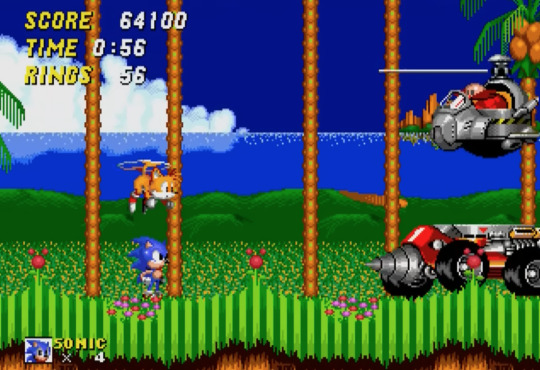
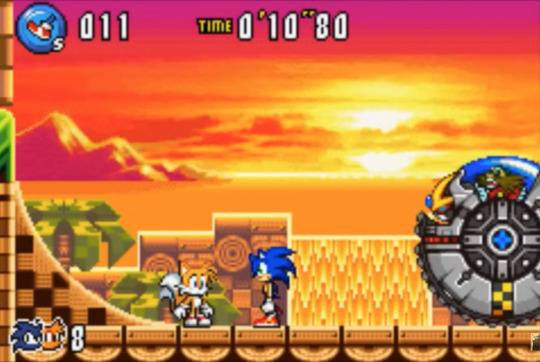
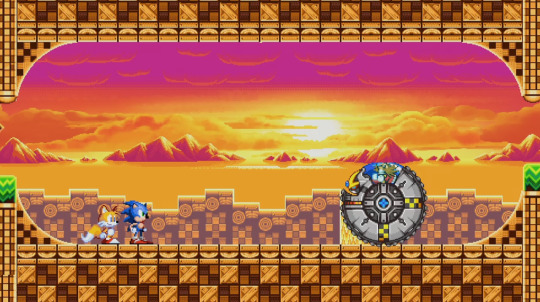
So what was Sonic like in the Mega Drive era?
Originally, Sonic was created to be a cool rebellious mascot for Sega, in contrast to their main rival company Nintendo’s more conventionally affable mascot Mario. That aspect was exaggerated in Western adaptations of early games: Sonic is drawn more cocky-looking on official Western game art, which started the infamous "mascot with attitude" trend in video games. However, in the Classic Sonic games, none of the characters talked, so their personalities were shown through body language: for instance, if the player keeps him motionless for too long, Sonic will get restless and tap his foot in annoyance while looking straight at the player, silently demanding to move things along already. (Unlike Tails, who just yawns in his idle animation.)

The opening and ending 2D animations for Sonic CD (1993) emulate Sonic’s sprites and add some quirks. They show that Sonic can be quietly confident, but also mischievous: a favorite tactic of his is to taunt robots until they rush into each other and break themselves. He uses it a lot in Sonic Prime as well, and it’s just as effective.
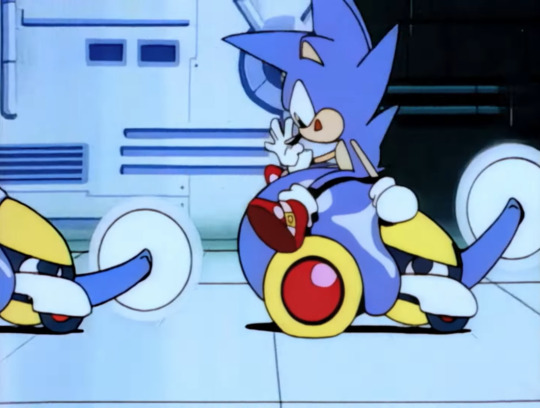

In general, Sonic’s sprites on the Mega Drive are very expressive and goofy-looking, especially when he’s about to lose his balance on the edge of a cliff. The Sonic CD ending animation and Sonic Prime both use these sprites as references for Sonic’s poses and expressions whenever he is in a pinch: he can get overwhelmed, but he is good at bouncing back.
In the first Classic games, the main story was fairly simple: Doctor Eggman is trying to build a robot empire and captures small animals or magical flower seeds so he can use them to power his machines, Sonic the Hedgehog destroys his robots to save the animals and let the flowers bloom. Pretty straightforward tale about environmentalism and fighting back against oppression.
It wasn’t anti-technology, though: as shown in the Sonic the Hedgehog 2 screenshot above, Sonic and Tails own a biplane, the Tornado, which they use to travel across seas or catch up with Eggman’s flying bases. Essentially, it’s the Studio Ghibli approach to environmentalism: humans and technology are not portrayed as innately evil, it is only nature exploitation and the dangers of upsetting the balance of an ecosystem that are condemned by the narrative - cautionary tales about the excessive use of technology, and a condemnation of weapons and war.
This underlying message was especially present in the first Sonic games, which were created in a time when Studio Ghibli films were highly successful and influential. At the very least, Knuckles’ homeland Angel Island (which first appeared in Sonic 3 & Knuckles, 1994), an island with overgrown ancient ruins that flies in the sky thanks to the power of a magical gemstone, is a clear hommage to Hayao Miyazaki’s Laputa, the Castle in the Sky (1986), and Sonic and Tails’s red biplane (which first appeared in Sonic the Hedgehog 2, November 1992) might be a reference to Porco Rosso (July 1992).
However, this environmental theme has become less prominent in later Sonic games, rarely brought up in the text since Sonic Adventure; and even then, it was mostly Amy talking to and saving Flickies (non-talking little birds) in the cutscenes. Sonic Prime brings back this core aspect of Sonic’s character from the Classic games by frequently showing him talking to Flickies and worrying about the state of nature, especially in New Yoke and Boscage Maze:
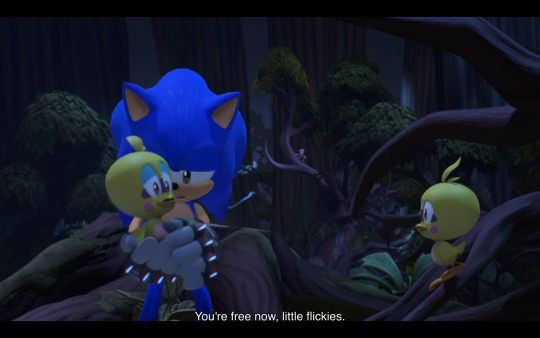
To this day, a lot of people are really nostalgic of the Classic games and their simpler approach to storytelling compared to the 3D games that came later, which is why Sonic Mania (2017) brought back that aesthetic. However, since Sonic Prime uses 3D animation for present and recent events (in contrast to the distant 2D flashbacks), the writers made the choice to base the character designs on modern games from the early 2000s, and their personalities along with them.
After the transition to 3D, in both Sonic Adventure games, Doctor Eggman was no longer the only human character: more realistic-looking cities and human characters started to coexist with the original cast of bipedal cartoon animals. Those games also added some complexity to the original cast of colorful characters by allowing them to talk and giving them character songs, Sonic included.
And what was Sonic like then?
Part 2 - Dreamcast Games: Sonic Adventure 1 and 2
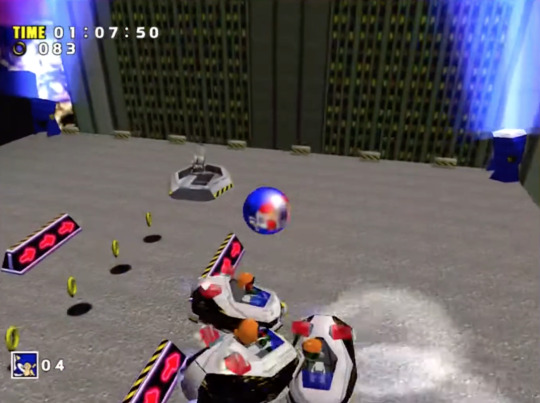
Like in the Classic games, Modern Sonic shows a clear disregard for any form of authority, and not just towards Eggman: in Sonic Adventure, all through the level Speed Highway, Sonic can take down police vehicles along with Eggman robots. In Sonic Adventure 2, the first thing he does is escape from the military helicopter that arrested him on a false charge - then Sonic snidely complains about ‘low-budget flights’ with ‘no food or movies’ before jumping off. (Yes, that’s the line the third Live Action Sonic movie was referencing.) The lyrics to the first stage song, ‘Escape From The City,’ also hint at Sonic’s life philosophy of always moving forward regardless of the obstacles in his way, and making sure everyone has as much freedom as he does.
On the other hand, in contrast to the Mega Drive games, now that he has a voice, Sonic has become very chatty. It might not always show when you’re playing him due to Silent Protagonist Syndrome (in most of the early games, all of the playable characters are silent when you play as them), but becomes very obvious in cutscenes and whenever he shows up while you’re playing as someone else. For instance, when you play as Tails in Sonic Adventure, your usual goal is to beat Sonic to the end of the stage. Much like in Sonic Prime, in those stages, Sonic never stops talking in the English and Japanese dubs. (Alternatively to egg Tails on or compliment him when he catches up; it’s especially noticeable in the Icecap Stage, where the two of them are neck and neck for most of the race.) Sonic is just as much of a chatterbox in Sonic Heroes, where you play as him, Tails and Knuckles at the same time. And of course, Sonic loves to taunt his adversaries, especially Eggman (and to a lesser extent, Knuckles) every chance he gets.
It is worth noting that Sonic’s lines and tone became a lot more snarky in Sonic Adventure’s English translation compared to the Japanese version, where he is less provocative and boastful. Instead, in the Japanese dub, Sonic tends to randomly drop lines in English, which is a more indirect way to make himself sound cool. This trend continues in the Japanese dub of Sonic Prime, where he also has plenty of English lines.
Play-flirting is an extension of his usual playful banter, which was added in Sonic Battle (2003). Interestingly, Sonic only seems comfortable doing this to people who are not pursuing him romantically: in this game, he only play-flirts with Rouge (who teases him back but doesn’t reciprocate the flirting) and keeps avoiding Amy, who is constantly chasing him in the hopes that he will agree to marry her.

Sonic Prime cranks this up to eleven: Sonic flirts with several characters regardless of gender, including Amy, who is not actively pursuing him in Sonic Prime - whether she lost interest and moved on, or just toned down her pursuit of Sonic is left ambiguous. It is left just as ambiguous whether or not Sonic is genuinely interested in any of the characters he flirts with in Sonic Prime, or if his flirting is just another aspect of his tendency to tease his friends for fun.
As for his more defining personality traits, the lyrics of Sonic’s theme song 'It Doesn’t Matter' by Crush 40 sum it up pretty well: Sonic is a free spirit who just does things his own way, refuses compromise, and generally doesn’t think it matters ‘who is wrong or who is right,’ he just follows his ‘steadfast heart of gold’ and never gives up. It also fits with the description of Sonic in the Sonic Heroes manual (see the second image of this post).
In this character profile, I find the line "Saving the world is a nice distraction, but Sonic is soon off to find his next adventure." especially interesting: there is no sense of urgency in a 'distraction,' because Sonic is not saving the world solely for justice’s sake, or out of a sense of duty, but because it’s fun to him. When he receives what appears to be a threatening letter from Eggman at the start of Sonic Heroes, Sonic jokingly describes it as 'an invitation to a party' - fighting Eggman is a game to Sonic as much as it is a necessity. As he puts it himself in Sonic Adventure 2, Sonic is "just a guy who loves adventure."
Now, notice how neither this song nor character profile say anything about friends or friendship. (Unlike Tails’ character song 'Believe in Myself.') You know why? Because, (and I say this with all the love in my heart) as much as he cares about nature, helping others, justice, and freedom in general, Sonic from the early 2000s is also a brat.
Amy’s words, not mine:
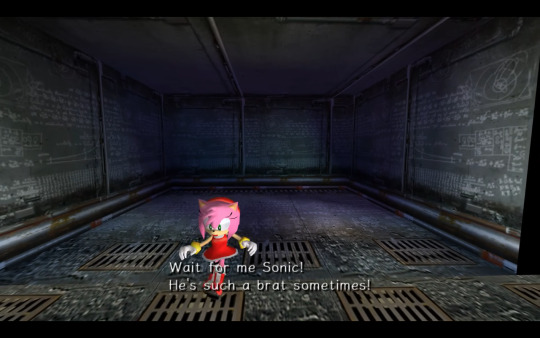
In the English version, that is. In Japanese, she is just asking him to wait for her. Because he just left her on her own in the cell she broke him out of. Inside an active military base. On an island.
It’s not an isolated incident, either: Amy gets left behind in hostile territory very often in this game, by Tails and Sonic both. So it’s not a Sonic-specific problem, but since Tails, to his own admission, is always trying to be more like Sonic in the Adventure games because he admires him, it makes sense that he would accidentally emulate Sonic’s flaws along with his qualities.
Here is a particularly memorable example of Sonic (and Tails) not thinking ahead and neglecting their friend with disastrous consequences in Sonic Adventure 2: once inside Eggman’s base of operation, they come up with a plan to thwart the doctor’s scheme, and then just… leave Amy all by herself in enemy territory. It’s the third time in this game for both Sonic and Tails: twice before this, each or both of them left Amy behind to do their own thing; once inside the above mentioned military base, then on a street full of police officers trying to capture the three of them. Those previous times, Amy managed to catch up with Sonic and Tails. The third time, Eggman takes her hostage, and all three of them almost get killed as a result. Shocker.
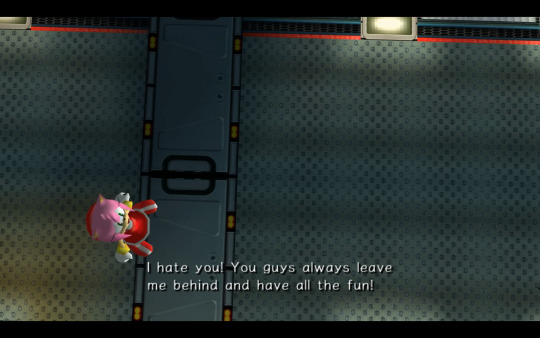
(Side Note: Amy doesn’t say "I hate you" in the Japanese dub. What she says is more along the lines of: "Come on! Why do you always leave a cute girl like me alone?!" In both versions, she definitely has the right to be mad at them.)
Of course, that doesn’t mean they don’t care about Amy: the first thing Tails does in Sonic Adventure 2 is save Amy from Eggman. Similarly, as soon as Sonic finds out that the island they’re on is about to explode, his first reflex is to go get Tails and Amy so they can escape together. Likewise, when Amy gets taken hostage later on, both Tails and Sonic put their plan to thwart Eggman on hold because helping her is their priority. The problem is, they don’t take her into account unless she is actively being threatened: most of the time, they just leave her be and assume she will be fine on her own; up to the very end of the game, when they leave her behind again while (almost) everyone else teams up to save the world. (Sonic and Tails never learn their lesson about this in that game.)
It’s not just about Amy, either: Sonic acts like this towards his three closest friends, Amy, Tails and Knuckles. For instance, right before the very first stage of Sonic Adventure, how does Sonic react after seeing Tails crash his plane? His first reaction, naturally, is concern, with his quills spreading out and Sonic calling out Tails’ name; but in the next frame, we get this:
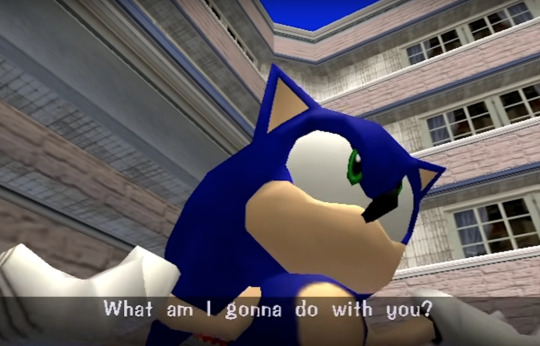
Sonic, buddy, Tails might be tough, but he just crashed his plane. Maybe act exasperated after you’ve made sure he’s okay? (And in case you were wondering: yes, Sonic’s reaction is the same in the Japanese and English dubs.)
This is not a critique, mind you: on the contrary, those flaws make Sonic more interesting as a nuanced character. In fact, this behavior of his is the negative side of one of Sonic’s core character traits: relentless optimism. He trusts that Tails will be okay, so he doesn’t dwell on worry: he just scoffs and then runs to the rescue.
None of that means that Sonic doesn’t care about his friends or won't listen to them. But it is demonstrably hard for his friends to get him to listen, because, due to the whole ‘I'm just livin' by my own feelings’ shtick, most of the time, Sonic is the ‘act first, think later’ type: in Sonic Adventure, during Sonic’s fight against Eggman’s robot E-102 Gamma (who defected after Amy befriended him, but none of her friends saw it happen), Amy first tries to scream at Sonic to stop attacking, but has to interpose herself between the two of them to get him to listen. (Although, to be fair, the same thing happens if Tails is the one fighting Gamma. But as stated above: Tails is just emulating Sonic in the first half of this game.) When she insists, Sonic (or Tails) does step back, even if he doesn’t understand her reasoning. Instead of demanding an explanation from Amy, he simply tells her: "Alright, you must have your reasons." A sign of unconditional trust, which is the generally more positive aspect of Sonic’s optimism.
This optimism extends to people in general, not just Sonic’s close friends: near the end of Sonic Adventure, he refuses to seal Chaos (an ancient deity who became destructive after his temple and the creatures under his care were attacked) inside the Master Emerald as Tikal suggests, because Sonic doesn’t just want to save the world from Chaos, he also wants both Chaos and Tikal to be free. Similarly, near the end of Sonic Adventure 2, when Eggman appears to explain the truth behind their current crisis, Knuckles is (justifiably) ready to blame Eggman and throw hands, but Sonic is willing to hear Eggman out - despite the fact that Eggman almost succeeded in murdering him an hour earlier. This shows that Sonic always tries to see the best in people, even his enemies, and is always willing to give someone a second chance: another positive aspect of his optimism that becomes a key plot point in Sonic Prime, especially near the end.
Basically, Sonic cares about everyone (strangers and enemies included) and is willing to listen to them, trusts his friends unconditionally (especially Tails, who has been with him the longest and a constant support), but his natural optimism, lack of tact, and tendency to act without thinking things through mean that he can also neglect his friends or dismiss their feelings. And sometimes, that makes him screw up spectacularly.
One of the most egregious examples of this takes place in Sonic Adventure 2, and is not too different from what triggers the plot of Sonic Prime: Sonic and friends are aboard a space shuttle to reach the Space Colony Ark and thwart Eggman’s evil scheme du jour. The shuttle hits a meteorite, which causes the back hatch to open and the Master Emerald shards to fall out. In case you didn't know, the Master Emerald (in the games) is an ancient and extremely powerful gemstone: not only is it capable of neutralizing the Chaos Emeralds or sealing away vengeful deities, its powers also allow Knuckles’ natal island to fly in the sky. As its guardian, it is Knuckles’ duty to protect it - his entire goal in Sonic Adventure 2 is to gather all the shards to repair the Master Emerald and bring it back safely to his island. Sonic knows all this. But how does Sonic react when the shards get scattered in space?
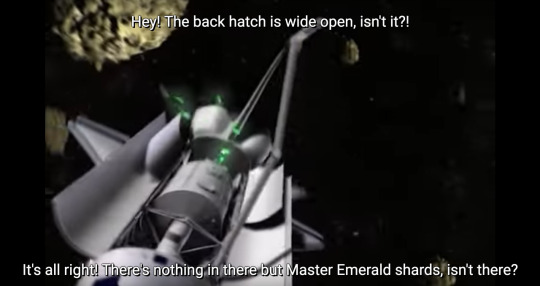
Yeah, no wonder Knuckles freaked out, took over the controls and almost crashed the shuttle trying to get to the shards. Yet Sonic was genuinely shocked that Knuckles would prioritize some mythical rock over all their lives. (Sonic even brings up the incident again near the end of the game, telling Eggman that Knuckles piloting the shuttle was way scarier than anything Eggman could pull off.)
So not only is it established that Sonic doesn’t understand the depth of Knuckles’ feelings when it comes to the Master Emerald (which makes sense, because a free spirit like Sonic would struggle to understand the very concept of a life-long duty - I would even go as far as suspect that Sonic resents the Master Emerald for keeping Knuckles trapped on a remote island), he doesn’t fully grasp how important it is to protect magical rocks in his universe, either. Sure, Sonic will track down and use the Chaos Emeralds to turn into Super Sonic because it’s useful and oftentimes lifesaving, and he knows that Eggman definitely shouldn’t be allowed to use powerful magical gems for his schemes - but if one such powerful gem gets lost in space, no one is using it for evil, so who cares?
This mindset is perfectly reflected in the first episode of Sonic Prime: Sonic’s priority is not to protect the Paradox Prism, it’s to get it away from Eggman. If he breaks the shiny rock, nobody can use it for evil, right? Isn’t that what Knuckles did in Sonic Adventure 2 to protect the Master Emerald from Eggman, too?
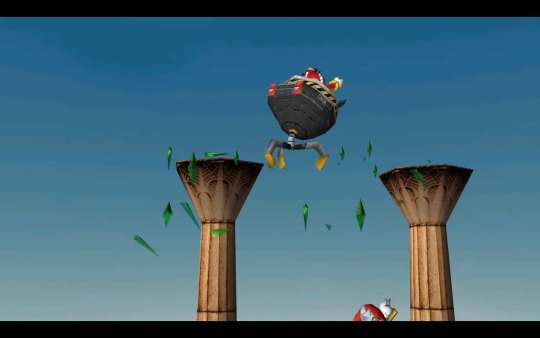
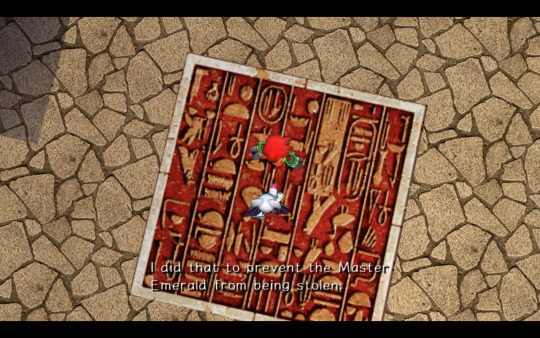
Except, you know, Knuckles is the guardian of the Master Emerald: he already knows that shattering the Master Emerald doesn’t make its powers run amok, and he knows that he can repair it. Sonic, on the other hand, has no idea how any of these rocks work; he just does whatever solves the problem faster, doesn’t think of the consequences, and trusts that everything will turn out okay. This is why, in Sonic Prime, in the heat of the moment, Sonic didn’t listen to anyone’s warnings, and impulsively broke the Prism to stop Eggman from taking it.
All this to say, Sonic can be a good hero, but he tends to act recklessly, and is not always a good team player. Even in Sonic Heroes, where the entire gameplay is built around teamwork (you play three characters at once and can switch up who leads the team at any time), the dialogue establishes that, even if Sonic enjoys working with Tails and Knuckles as a team, he is not very used to it, nor always good at it.
Part 3 - Sonic Heroes, the main inspiration for Prime Sonic
In Sonic Heroes, Sonic’s team is the most chaotic of the four combinations you can play as:
For Team Dark, Rouge immediately takes the role of leader by convincing Shadow and Omega that teaming up is the most effective way to reach their respective goals, and they rely on her for guidance. Similarly, Cream and Big trust Amy to help them find their missing friends, and follow her lead. Lastly, Team Chaotix is composed of three colleagues, already used to working together on a case, and the younger two answer to Vector, the lead detective of their agency. Meanwhile, in Team Heroes’ case, what the in-game dialogues show is that Sonic is almost always rushing ahead, with Tails and Knuckles struggling to keep up or expressing wariness, which Sonic dismisses - like these recurring lines:
Knuckles: We’re not going that way, are we? Sonic: Yes we are!
In addition to that, Sonic gets distracted very easily by anything fun-looking, and drags the other two along, regardless of their reluctance. The intro cutscene to the Casino Stage is the most blatant example of this: Sonic gets excited as soon as he sees the stage, and insists that they’ve still got time to play some games. Tails tries to stop Sonic by reminding him of Eggman’s time limit, but Sonic only takes it as an incentive to play games faster.
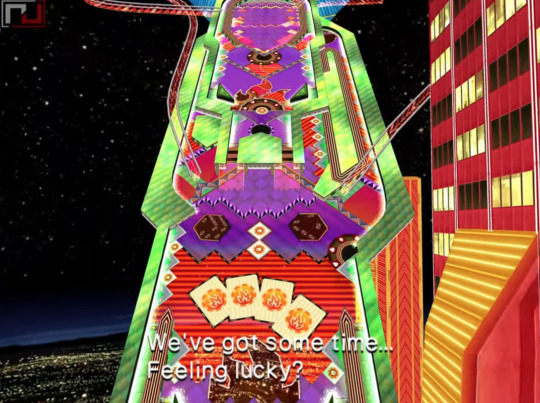


And here is another game special that Sonic Prime took direct inspiration from: Sonic’s eagerness to blow himself out of cannons, heedless of Knuckles’ attempts to dissuade him, and without checking where the cannon is aiming first.

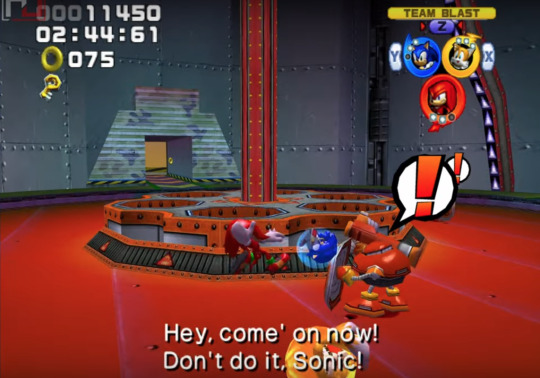
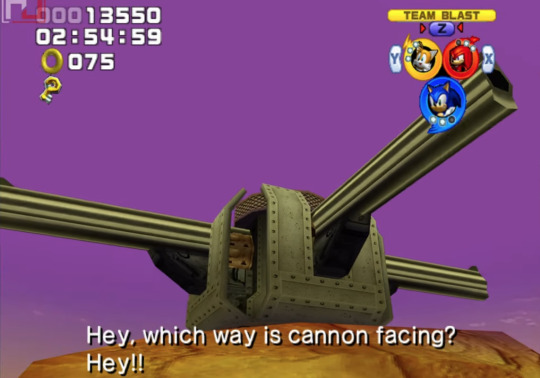
It takes the entire game for Sonic to acknowledge the value of relying on others, and only because Knuckles calls out his bluff at the end of their story in the following dialogue:
Knuckles: Boy, talk about cutting it close.
Sonic: Eeh, not really.
Knuckles: Come on, tell me you weren’t scared?
Knuckles: If it wasn’t for us, you wouldn’t have had a chance.
Sonic: Well, maybe you’re right. Thanks Knuckles.
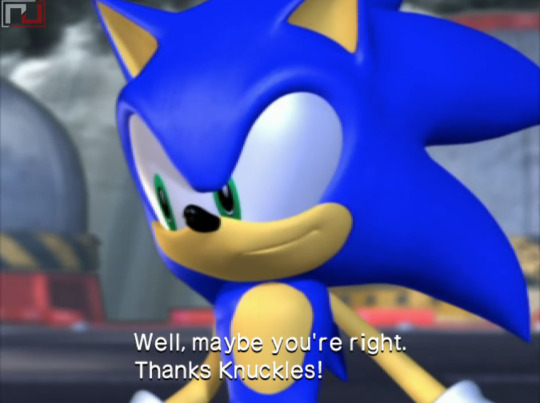
The English translation is fairly faithful to the Japanese version here. In both dubs, Sonic looks pretty sheepish about admitting it, and Knuckles is shocked that Sonic recognized his point and thanked him. Even Tails gets flustered and laughs nervously when Sonic thanks him immediately after, implying that it’s not very common for Sonic to thank Tails directly or be this open about his feelings - a possible sign that Sonic doesn’t like to show vulnerability.
Sonic’s sheepishness while thanking Knuckles in that scene might be partly due to the fact that, out of all his friends, Sonic is particularly reluctant to ask Knuckles for help. (Which is also the case in Sonic Prime, as evidenced by the way he calls out to his missing friends in the first episode: "Tails? Amy? Heck, I’ll even take Knuckles at this point…") Possibly because neither Sonic nor Knuckles has fully gotten over their initial rivalry, and they still tend to butt heads on occasion due to different values (the above-mentioned example of the lost Master Emerald shards in Sonic Adventure 2 is an extreme case, but illustrates the underlying tension between them pretty well). Even in Sonic Advance 3, another game centered on teamwork where you can pair up any of the five playable characters in a duo, Sonic refuses Knuckles’ help when the latter joins the party, and rushes ahead without waiting for him (Side note: it’s not obvious on the following picture, but Knuckles’ piece of dialogue appears first in that scene):
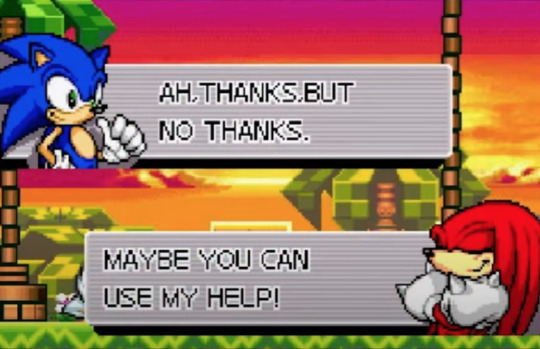
Considering that Sonic Advance 3 explicitly takes place after Sonic Heroes and Sonic Battle, this goes to show that Sonic still has some trouble with teamwork, even when his friends offer their help, because he does things at his own pace - which is too fast for most people. This behavior is pretty consistent with the way Sonic is described by his Green Hill friends in Sonic Prime: usually reliable in battle, but very reckless, and not always the best at teamwork, even if he has learnt to value it by the end of Sonic Heroes.
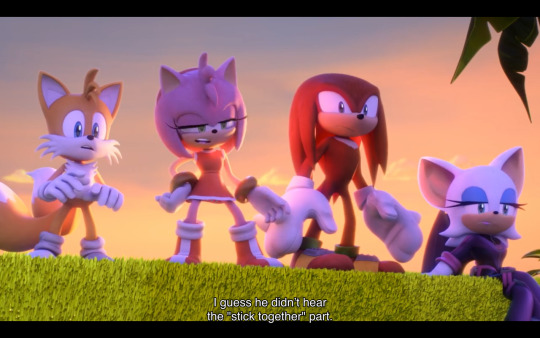
Amy: I guess he didn’t hear the "stick together" part. Knuckles: Does he ever? Tails: No. But he also hasn’t let us down when it really counts.
It’s especially fitting that Amy is the one complaining about Sonic leaving them behind (as demonstrated above, she is the one Sonic leaves behind most often), Knuckles is the one who backs her up (he is the one Sonic listens to the least), and Tails agrees with them, but still takes Sonic’s defense, assuring them that Sonic "will catch up eventually." Even though Tails is well aware of Sonic’s flaws, Sonic’s complete faith in Tails is still mutual thanks to their long history together - which is why, when their reality gets shattered in Sonic Prime, this history getting erased is especially painful for Sonic. It’s not that he never saw the value of his friendships: on the contrary, he put so much value into them that he never realized how fragile they could be. In Sonic Heroes, he went as far as to describe teamwork as a super power:
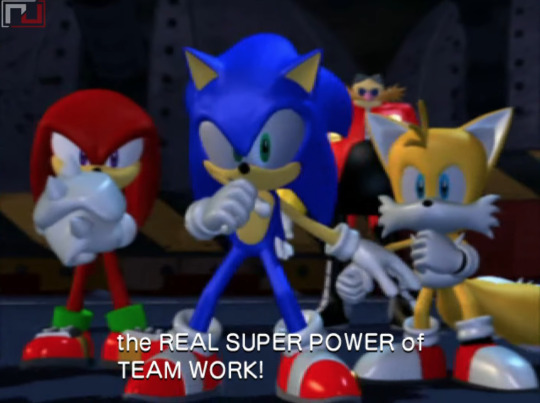
It’s not an English dub special, either. In the Japanese version, Sonic says: "Alright then, let’s use our teamwork to show him miraculous super power!" Which implies that teamwork is what allows Sonic to share the power of the seven Chaos Emeralds with Tails and Knuckles to bring them along for the final fight as Super Sonic. Essentially, ‘friendship is magic.’ (Speaking of which: as you can see, Sonic Prime’s occasionally corny dialogue doesn’t exist solely "because it’s a kids’ show." It’s because the games that inspired it already had corny dialogue.)
Corniness aside, the fact that Sonic puts friendship on a pedestal is a pretty interesting mindset for him to have in the context of Sonic Prime, where his reliance on his friends is constantly challenged. You could even say that after Sonic Heroes, Sonic might value friendship a little too much, without realizing that maintaining his friendships takes effort, and that unconditional trust in his friends and an eventual positive outcome to every battle is a double-edged sword.
In fact, valuing the Power of Friendship as a constant, reliable source of power similar to the miracles granted by the Chaos Emeralds can be equally dangerous. If you believe in your friends unconditionally, you might start to take them, and your relationships with them, for granted.
Because this kind of bond is unbreakable, right? And as long as you have a team you can rely on, everything will turn out okay… right?
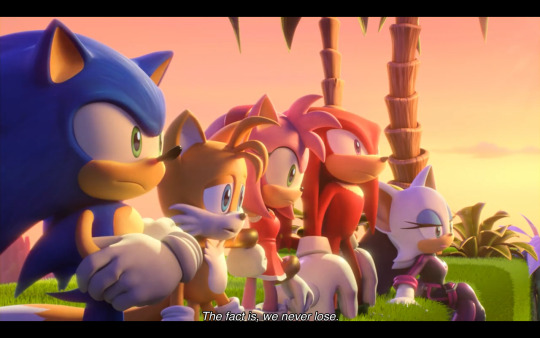
It is definitely the case in Sonic Heroes, but in Sonic Prime?
In truth, things are not so simple: miscommunication can lead to rash decisions, and mistakes you can’t take back. It can lead to misunderstandings. There might be conflicting goals, even among friends. And those can lead to betrayals.
Those are harsh lessons to learn, but it makes sense that Sonic would need them. You could even argue that Game Sonic’s relentless optimism and unconditional trust in his friends can be challenged in a similar way if you (as Shadow) choose to betray him in Shadow the Hedgehog, where Sonic’s characterization is similar to Sonic Heroes' - but these ‘dark routes’ get retconned by Shadow the Hedgehog’s ‘true ending,’ so Sonic doesn’t actually get to live that betrayal in the main storyline. A game might not be the ideal medium to teach those lessons anyway (especially a game like Shadow the Hedgehog, which isn’t focused on Sonic), but a cartoon series works nicely: you get more time to focus on your main character and his emotions rather than the action, which gives him more room to grow.
So, if a show wants to focus on this characterization of Sonic and write a self-contained, compelling story centered on him, doesn’t it make sense to take all those elements from the early games and give him a character arc about not taking his friends for granted, and learning how to communicate better?
In addition to what Sonic Adventure 2 and Sonic Battle already taught him about the real possibility of losing people for good (both of these games had tragic endings, and one person Sonic failed to save; a bitter truth that Sonic does not like to acknowledge: he either hides his grief from his friends and pretends to be okay - Sonic Adventure 2 - or struggles to stay positive and move on by comforting his friends - Sonic Battle), Sonic Prime tackles another issue: the way Sonic’s overconfidence can play against him and his friends, and lead to disaster. The threats Sonic usually faces in the games are caused by elements beyond his control, but this time, the premise of the show is built on Sonic making a mistake due to recklessness, literally shattering his entire world in the process, being forced to face the consequences, and to realize that he can’t salvage the situation on his own. Not only that, but he has to rebuild all his friendships from the ground up. Those are odds he never had to face before, and fertile ground for growth.
Personally, I think Sonic Prime did an amazing job bringing back the spirit of those early games, especially Sonic Heroes, which it ressembles most aesthetically (no realistic human characters or cities, but plenty of bright colors and bouncy animation, a lot of shameless fun even in the face of a cataclysmic threat - and cheesy dialogue about the power of friendship) and making Sonic shine as a main character by pointing out his flaws and hitting him where it hurts: more obstacles for him to overcome and learn from.
Sonic Prime might not fit neatly anywhere in the games’ timeline (although, as I mentioned in Part 1, a lot of the games don’t fit together either, even when they reference each other directly), but it does work as an hommage to how Sonic was characterized in the early 2000s (especially in Sonic Heroes), and it can arguably work as a transition towards later games or other continuities where Sonic becomes better at communicating with his friends, learns some sense of responsibility, and relies more on his emotional intelligence to help people. He already cared about his friends, helping others, and was compassionate when it counted, but his recklessness and overconfidence could still be a danger to himself and others. As Shadow puts it: "You need to stop and listen for once!" (And in turn, Shadow needs to learn to communicate better.)
I understand if you prefer Sonic as a paragon of freedom and justice that inspires others rather than a character that can be fallible and may need to learn life lessons sometimes. But those two things are not mutually exclusive: Prime Sonic still becomes an inspiration to the characters he befriends, enough for them to protect him to the bitter end, and they inspire him in return.
Honestly, I am truly grateful to and impressed by the Sonic Prime writers: they didn’t just slap Sonic’s name on a brand new character for the kids to identify with, they clearly care a lot about the early Sonic games, and made sure to stay faithful to them, while still writing a cohesive story that can be followed by newcomers of all ages.
And as someone who grew up playing those games, this show felt like a love-letter to old fans of Sonic the Hedgehog. Watching Prime Sonic felt like reuniting with the character I grew up with: heroic, but still flawed and vulnerable in ways that got me invested in his adventures - the fact that he can make mistakes is good for suspense, and watching him learn from them is inspiring.
However you may feel about Prime Sonic, a lot of thought clearly went into writing his character based on early games; and I, for one, am really happy to have my reckless, overconfident bratty goofball back.
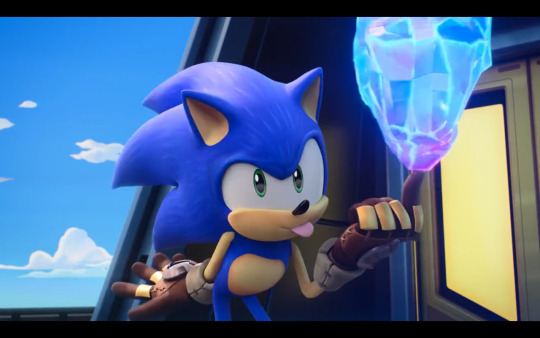
#Quill answers#self reblog#sonic prime#meta analysis#story analysis#symbolism#shatterverse#I am physically incapable of keeping my essays short and concise it seems#I am having fun writing them though
48 notes
·
View notes
Text
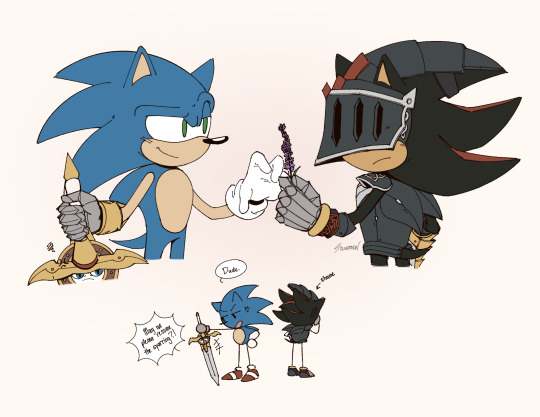
another small bday celebration with them :)
#It's pride month Caliburn let them have this#Look - I am an aroace Sonic and aroace Shadow truther#Lancelot though? Lancelot falls hard and fast; that's just the rule#And Sonic is like “I maaay have accidentally wooed a knight from a storybook who looks just like my rival back home”#“What the heck am I supposed to do about THAT?”#Love this dynamic and how it strikes the perfect balance between hilariously absurd and ridiculously tragic#Lansoni rules#Also love that Caliburn has no patience for their shenanigans#Sonic and the Black Knight had no business being as good as it is but I'm not complaining#art reblog#sonic fancomic#lansoni#sonic the hedgehog#satbk sir lancelot#caliburn#satbk#sonadow#pride month 2025
612 notes
·
View notes
Text

I really enjoyed 'Chao Tales' but my brain automatically turns wholesome cute short stories into angst. It's a curse.
#Why do I do this to myself#I already drew a 10 page storyboard for a fancomic about that headcanon#The Chao Garden nostalgia was too powerful I'm afraid#tumblr memes#sth#chao tales#sonic the hedgehog#shadow the hedgehog#shadow chao#sonic adventure 2#sonic heroes#sonic games#sonadow#arguably?#chao tales is heavily sonadow coded already - the angst just adds to it
280 notes
·
View notes
Text

After this previous post I made, I feel obligated to add the lesbians for continuity's sake.
Sometimes it's two gals leaning on each other at the end of the world, and sometimes the subtext is text.
this shot has always bothered me because it definitely reminded me of something but i could never figure out what. it finally hit me.


nothing says homoerotic subtext like two dudes at the end of the world leaning on each other metaphorically and literally
#Another great trope#Best ship dynamic goes from “Anything you can do I can do BETTER” to “You're going to sacrifice yourself for the universe? NOT ON MY WATCH”#Still doesn't have to be romantic but again - at least one of these very much is#sonic prime#sonic the hedgehog#shadow the hedgehog#sonadow#sth#sonic prime spoilers#kingdom hearts ii#kh sora#kh riku#soriku#she ra and the princesses of power#she ra season 5#spop#spop adora#spop catra#Honestly kudos to all of them for learning to rely on each other physically and emotionally after Everything
187 notes
·
View notes
Text


Uh
Baby (pickled)
#They are so frickin' cute HELP#Pickled baby Shadow is such a great concept#I know 'Sonic X Shadow Generations' heavily implies that Shadow already looked like a teen hedgehog when he was woken up for the first time#But I will always be weak to Maria and baby Shadow shenanigans#Let them have SOME childhood joy please#ark siblings#shadow the hedgehog#maria robotnik#gerald robotnik#art reblog#sonic fancomic
37K notes
·
View notes
Text




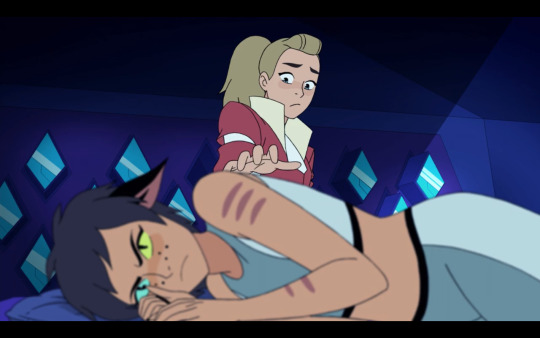

Shout-out to all the pining losers who reach out to comfort their suffering rival/friend/??? but chicken out at the last moment.
#I really like this trope#The YEARNING#Doesn’t have to be romantic but at least one of these definitely is so I’m tagging the ships anyway#sonic prime#sonic the hedgehog#shadow the hedgehog#sth#sonadow#sonic prime spoilers#kingdom hearts iii#kh sora#kh riku#soriku#she ra and the princesses of power#spop#spop adora#spop catra#catradora#she ra season 5#Comfort them you fools!
168 notes
·
View notes
Text
What Inspired Prime Sonic’s Characterization
From what I’ve seen, Sonic’s characterization in the Sonic Prime series is pretty divisive in the fandom. Some people love it, others think Sonic’s ‘original’ character was done dirty as a hero in this series. According to the latter, Sonic should be a source of inspiration rather than someone who needs a character arc.
And you know, everyone is free to interpret a character or a show in different ways, and to prefer one version over the other. I don’t intend to change or discredit anyone’s opinion on the matter.
What I would like to point out is that the Sonic Prime writers clearly did take inspiration from the games for Sonic’s characterization, and it shows. You just have to look at the earlier games rather than the latest. But since most of those games are not so easily accessible these days, as someone who grew up playing them, I would be happy to show you why, to me and other fans, watching Sonic Prime felt so nostalgic.
If you don’t feel like reading over 7K words of early Sonic games’ recap and analysis, in short: I believe Prime Sonic is intended to be a mix of his characterization in the Classic games (starting with Sonic the Hedgehog, 1991) and the Modern games from the early 2000s (up to and including Sonic Advance 3, 2004 - but mostly Sonic Heroes, 2003). To make this essay easier to read, I’ve divided it into three parts:
Part 1: Introduction, and Sonic Games on the Mega Drive
Part 2: Dreamcast Games: Sonic Adventure 1 and 2
Part 3: Sonic Heroes, the Main Inspiration for Prime Sonic
Before I begin, I would like to reiterate that Prime Sonic’s characterization is great representation for neurodivergent people, especially as the lovable hero of a kids’ show. I won’t go into more detail about it in this essay because I’ll be focusing on the game adaptation aspect, but it’s rare enough that it bears repeating, and if you’d like to read more about that, you can check out descendant-of-truth’s excellent post about it.
Forewarning: I will try to keep this essay as accessible as possible to anyone unfamiliar with Sonic lore without spoiling major plot points (there will be some important spoilers for Sonic Adventure, Sonic Adventure 2 and Sonic Battle, though, careful with that!), but this is going to be long and image-heavy, so strap in, folks!
Part 1 - Introduction, and Sonic Games on the Mega Drive
First off, we should keep in mind that Sonic the Hedgehog has existed for over 30 years, and has been written in different ways by different people on different mediums. On top of that, there have been a lot of mistranslations and artistic liberties taken between the Japanese and English versions of Sonic games, leading to notable changes in character design, dialogue, and plot points - sometimes minor, sometimes major. More rarely, other mediums have influenced the games: some details from early Sonic cartoons were included in the games later on, like Sonic’s obsession with chili dogs, which first appeared in the Adventures of Sonic the Hedgehog cartoon in 1993, and was only added to the game canon from 2008 onward, starting with Sonic and the Black Knight. Sonic’s constant craving for chili dogs is also there in Sonic Prime.
That being said, one of Sonic Prime’s writers, Duncan Rouleau, has tweeted that they were "only adding to (the video game universe created by the Sonic Team)." This could either mean that Sonic Prime is set in the video game universe, or that it is simply based on it. (I know it’s a point of contention in the fandom, but I won’t be touching that particular debate here - I think you should feel free to interpret it however you want.) Either way, those tweets confirm that the games were the main source of inspiration for Sonic Prime. Therefore, I will be focusing on Sonic’s characterization in the games for this analysis, and mention the differences between Japanese and English dubs whenever it becomes relevant.
While I do admire the fans’ efforts to make sense of Sonic lore and establish a coherent continuity (and I do think those efforts are worthwhile when writing fanfiction or fancomics; some truly great stories have been and continue to be written for this fandom), the fact remains that continuity between the Sonic games is a mess.
It may be tempting to think that the games are linear and that ‘time of release’ = ‘place in the timeline,’ but that logic doesn’t always work. As an example: Shadow has amnesia in Sonic Heroes (December 2003), he remembers everything in Sonic Battle (also December 2003), but the entire plot of Shadow the Hedgehog (2005) revolves around him trying to get his memories back - so Sonic Battle should take place after Shadow the Hedgehog, even if the former got released first.
On top of that, several of the games’ plot lines and characterization directly contradict each other, and there have been a lot of retcons over the decades. To give a visual example: half of the moon gets blown up in Sonic Adventure 2 (2001). The moon is whole again in the opening cinematic of Shadow the Hedgehog (2005), which explicitly takes place after Sonic Adventure 2. And finally, in the prologue animation for Sonic X Shadow Generations titled Dark Beginnings (2024), which explicitly takes place after Shadow the Hedgehog, the moon is shown to be partly destroyed again. So unless the moon got repaired and then broken again offscreen, that’s a double retcon. (Also, the Eclipse Cannon, the weapon that blew up part of the moon, is fully operational in Shadow the Hedgehog, even though it got destroyed by the end of Sonic Adventure 2. In fact, getting rid of that weapon was Sonic’s main objective at the end of the Hero Story in Sonic Adventure 2, making this particular retcon especially jarring.)
And for one last example regarding Sonic’s character specifically: Classic Sonic (Sonic’s design for the earliest 2D games) got re-introduced in Sonic Generations (2011) as Modern Sonic’s past self, and is considered a child in the fandom nowadays. However, in his Sonic Jam (1997) game profile, Classic Sonic is stated to be 16, while in the manual of Sonic Heroes (2003), Modern Sonic’s age is stated to be 15. So Sonic technically got de-aged twice. (In light of this, it might be for the best that Sega ultimately decided to make all the cast’s ages ambiguous.)


My point is, the Sonic games can be inconsistent with each other, and that goes for characterization as well. Knuckles is one of the most obvious examples of varied characterization from game to game, and not in any linear way that could be explained by character growth: he is much stupider and spontaneously agressive in Sonic Battle (which explicitly takes place after Sonic Adventure 2) than in the Adventure games, but Sonic Frontiers (2022) and its animated prologue Divergence restored Knuckles’ personality to the Adventure version, where he is quiet and contemplative unless provoked, and his gullibility is a consequence of his social isolation rather than a lack of intelligence.
Game Sonic himself has been written differently over time as well. Therefore, before we can judge whether or not Prime Sonic is OOC, we need to establish which version (or versions) of Sonic the writers took inspiration from.
Thankfully, Iann Flynn, who was hired as a consultant for the show, gave an element of answer in a tweet: "Sonic Prime takes place sometime after Sonic Advance 3."
Taken as is, as Iann Flynn clarified himself in another tweet, this is very broad and intentionally vague: by that metric, Sonic Prime could take place anywhere from right after Sonic Advance 3 (2004) to post Sonic games from the 2020s. And honestly, it doesn’t really matter, because Sonic Prime can exist as its own thing, and you don’t need to know much about game lore to enjoy it - knowing the lore is just a bonus. (And to be clear: I’m not trying to establish where Sonic Prime fits in the games’ chronology, or whether or not the show should be considered canon to the games at all; I am only trying to pinpoint what aspects of the games inspired Prime Sonic’s personality.)
What this tweet does imply is that Sonic Prime mostly took inspiration from the games that came before Sonic Advance 3. As in, the Classic games on the Mega Drive (also known as Sega Genesis) and other Sega consoles, both Sonic Adventure games, Sonic Heroes, Sonic Battle, and all three Sonic Advance games - from the 1990s to 2004.
This seems to be confirmed by the choice of our main cast, the callbacks to game release dates in Sonic Prime, and the way distant flashbacks are animated: Big the Cat first appeared in Sonic Adventure (in 1998; hence his New Yoke alternate self’s name: ‘Citizen 1998’). Rouge and Shadow both made their debut in Sonic Adventure 2 (2001), the last Sonic game to come out on a Sega console - namely, the Dreamcast. (Team Chaotix was also introduced on a Sega console in Knuckles Chaotix (1995), but that game is a lot more obscure, which is probably the reason why their team wasn’t included in Sonic Prime - plus, the cast would have been too large with those three.)
To make the references to the 1990s games clear, the Sonic Prime flashbacks to Sonic’s first interactions with Tails and Knuckles are animated in a pixelated 2D style that’s reminiscent of the Mega Drive games’ aesthetic. Furthermore, the password to Tails and Nine’s respective labs in Sonic Prime - ‘1992’ - is a reference to Sonic the Hedgehog 2 (Tails’ debut game, which came out in 1992) and the flashback scene in Sonic Prime season 1, episode 7 is based on Knuckles’ debut game, Sonic 3 & Knuckles (1994). Therefore, it stands to reason that part of the characterization would also be inspired by early games. Even the Sunset Hill Boss Battle from Sonic Advance 3 (2004), when it gets referenced in Sonic Prime Season 3, Episode 3’s introductory flashback (complete with a remix of the original boss music), gets redrawn in the Mega Drive games’ art style; except for Eggman, who keeps his character design from Sonic Advance 3. (Likely to avoid confusion for the viewers: in context, the Mega Drive art style is indicative of flashbacks set before Sonic Prime, but it would feel unnatural if Eggman's design changed too drastically from those flashbacks to the present.) This is why Iann Flynn quoted that specific game in his tweet about a plausible timeline for Sonic Prime in relation to the Sonic games: Sonic Advance 3 is the latest released game that gets a visual callback in Sonic Prime.



So what was Sonic like in the Mega Drive era?
Originally, Sonic was created to be a cool rebellious mascot for Sega, in contrast to their main rival company Nintendo’s more conventionally affable mascot Mario. That aspect was exaggerated in Western adaptations of early games: Sonic is drawn more cocky-looking on official Western game art, which started the infamous "mascot with attitude" trend in video games. However, in the Classic Sonic games, none of the characters talked, so their personalities were shown through body language: for instance, if the player keeps him motionless for too long, Sonic will get restless and tap his foot in annoyance while looking straight at the player, silently demanding to move things along already. (Unlike Tails, who just yawns in his idle animation.)

The opening and ending 2D animations for Sonic CD (1993) emulate Sonic’s sprites and add some quirks. They show that Sonic can be quietly confident, but also mischievous: a favorite tactic of his is to taunt robots until they rush into each other and break themselves. He uses it a lot in Sonic Prime as well, and it’s just as effective.


In general, Sonic’s sprites on the Mega Drive are very expressive and goofy-looking, especially when he’s about to lose his balance on the edge of a cliff. The Sonic CD ending animation and Sonic Prime both use these sprites as references for Sonic’s poses and expressions whenever he is in a pinch: he can get overwhelmed, but he is good at bouncing back.
In the first Classic games, the main story was fairly simple: Doctor Eggman is trying to build a robot empire and captures small animals or magical flower seeds so he can use them to power his machines, Sonic the Hedgehog destroys his robots to save the animals and let the flowers bloom. Pretty straightforward tale about environmentalism and fighting back against oppression.
It wasn’t anti-technology, though: as shown in the Sonic the Hedgehog 2 screenshot above, Sonic and Tails own a biplane, the Tornado, which they use to travel across seas or catch up with Eggman’s flying bases. Essentially, it’s the Studio Ghibli approach to environmentalism: humans and technology are not portrayed as innately evil, it is only nature exploitation and the dangers of upsetting the balance of an ecosystem that are condemned by the narrative - cautionary tales about the excessive use of technology, and a condemnation of weapons and war.
This underlying message was especially present in the first Sonic games, which were created in a time when Studio Ghibli films were highly successful and influential. At the very least, Knuckles’ homeland Angel Island (which first appeared in Sonic 3 & Knuckles, 1994), an island with overgrown ancient ruins that flies in the sky thanks to the power of a magical gemstone, is a clear hommage to Hayao Miyazaki’s Laputa, the Castle in the Sky (1986), and Sonic and Tails’s red biplane (which first appeared in Sonic the Hedgehog 2, November 1992) might be a reference to Porco Rosso (July 1992).
However, this environmental theme has become less prominent in later Sonic games, rarely brought up in the text since Sonic Adventure; and even then, it was mostly Amy talking to and saving Flickies (non-talking little birds) in the cutscenes. Sonic Prime brings back this core aspect of Sonic’s character from the Classic games by frequently showing him talking to Flickies and worrying about the state of nature, especially in New Yoke and Boscage Maze:

To this day, a lot of people are really nostalgic of the Classic games and their simpler approach to storytelling compared to the 3D games that came later, which is why Sonic Mania (2017) brought back that aesthetic. However, since Sonic Prime uses 3D animation for present and recent events (in contrast to the distant 2D flashbacks), the writers made the choice to base the character designs on modern games from the early 2000s, and their personalities along with them.
After the transition to 3D, in both Sonic Adventure games, Doctor Eggman was no longer the only human character: more realistic-looking cities and human characters started to coexist with the original cast of bipedal cartoon animals. Those games also added some complexity to the original cast of colorful characters by allowing them to talk and giving them character songs, Sonic included.
And what was Sonic like then?
Part 2 - Dreamcast Games: Sonic Adventure 1 and 2

Like in the Classic games, Modern Sonic shows a clear disregard for any form of authority, and not just towards Eggman: in Sonic Adventure, all through the level Speed Highway, Sonic can take down police vehicles along with Eggman robots. In Sonic Adventure 2, the first thing he does is escape from the military helicopter that arrested him on a false charge - then Sonic snidely complains about ‘low-budget flights’ with ‘no food or movies’ before jumping off. (Yes, that’s the line the third Live Action Sonic movie was referencing.) The lyrics to the first stage song, ‘Escape From The City,’ also hint at Sonic’s life philosophy of always moving forward regardless of the obstacles in his way, and making sure everyone has as much freedom as he does.
On the other hand, in contrast to the Mega Drive games, now that he has a voice, Sonic has become very chatty. It might not always show when you’re playing him due to Silent Protagonist Syndrome (in most of the early games, all of the playable characters are silent when you play as them), but becomes very obvious in cutscenes and whenever he shows up while you’re playing as someone else. For instance, when you play as Tails in Sonic Adventure, your usual goal is to beat Sonic to the end of the stage. Much like in Sonic Prime, in those stages, Sonic never stops talking in the English and Japanese dubs. (Alternatively to egg Tails on or compliment him when he catches up; it’s especially noticeable in the Icecap Stage, where the two of them are neck and neck for most of the race.) Sonic is just as much of a chatterbox in Sonic Heroes, where you play as him, Tails and Knuckles at the same time. And of course, Sonic loves to taunt his adversaries, especially Eggman (and to a lesser extent, Knuckles) every chance he gets.
It is worth noting that Sonic’s lines and tone became a lot more snarky in Sonic Adventure’s English translation compared to the Japanese version, where he is less provocative and boastful. Instead, in the Japanese dub, Sonic tends to randomly drop lines in English, which is a more indirect way to make himself sound cool. This trend continues in the Japanese dub of Sonic Prime, where he also has plenty of English lines.
Play-flirting is an extension of his usual playful banter, which was added in Sonic Battle (2003). Interestingly, Sonic only seems comfortable doing this to people who are not pursuing him romantically: in this game, he only play-flirts with Rouge (who teases him back but doesn’t reciprocate the flirting) and keeps avoiding Amy, who is constantly chasing him in the hopes that he will agree to marry her.

Sonic Prime cranks this up to eleven: Sonic flirts with several characters regardless of gender, including Amy, who is not actively pursuing him in Sonic Prime - whether she lost interest and moved on, or just toned down her pursuit of Sonic is left ambiguous. It is left just as ambiguous whether or not Sonic is genuinely interested in any of the characters he flirts with in Sonic Prime, or if his flirting is just another aspect of his tendency to tease his friends for fun.
As for his more defining personality traits, the lyrics of Sonic’s theme song 'It Doesn’t Matter' by Crush 40 sum it up pretty well: Sonic is a free spirit who just does things his own way, refuses compromise, and generally doesn’t think it matters ‘who is wrong or who is right,’ he just follows his ‘steadfast heart of gold’ and never gives up. It also fits with the description of Sonic in the Sonic Heroes manual (see the second image of this post).
In this character profile, I find the line "Saving the world is a nice distraction, but Sonic is soon off to find his next adventure." especially interesting: there is no sense of urgency in a 'distraction,' because Sonic is not saving the world solely for justice’s sake, or out of a sense of duty, but because it’s fun to him. When he receives what appears to be a threatening letter from Eggman at the start of Sonic Heroes, Sonic jokingly describes it as 'an invitation to a party' - fighting Eggman is a game to Sonic as much as it is a necessity. As he puts it himself in Sonic Adventure 2, Sonic is "just a guy who loves adventure."
Now, notice how neither this song nor character profile say anything about friends or friendship. (Unlike Tails’ character song 'Believe in Myself.') You know why? Because, (and I say this with all the love in my heart) as much as he cares about nature, helping others, justice, and freedom in general, Sonic from the early 2000s is also a brat.
Amy’s words, not mine:

In the English version, that is. In Japanese, she is just asking him to wait for her. Because he just left her on her own in the cell she broke him out of. Inside an active military base. On an island.
It’s not an isolated incident, either: Amy gets left behind in hostile territory very often in this game, by Tails and Sonic both. So it’s not a Sonic-specific problem, but since Tails, to his own admission, is always trying to be more like Sonic in the Adventure games because he admires him, it makes sense that he would accidentally emulate Sonic’s flaws along with his qualities.
Here is a particularly memorable example of Sonic (and Tails) not thinking ahead and neglecting their friend with disastrous consequences in Sonic Adventure 2: once inside Eggman’s base of operation, they come up with a plan to thwart the doctor’s scheme, and then just… leave Amy all by herself in enemy territory. It’s the third time in this game for both Sonic and Tails: twice before this, each or both of them left Amy behind to do their own thing; once inside the above mentioned military base, then on a street full of police officers trying to capture the three of them. Those previous times, Amy managed to catch up with Sonic and Tails. The third time, Eggman takes her hostage, and all three of them almost get killed as a result. Shocker.

(Side Note: Amy doesn’t say "I hate you" in the Japanese dub. What she says is more along the lines of: "Come on! Why do you always leave a cute girl like me alone?!" In both versions, she definitely has the right to be mad at them.)
Of course, that doesn’t mean they don’t care about Amy: the first thing Tails does in Sonic Adventure 2 is save Amy from Eggman. Similarly, as soon as Sonic finds out that the island they’re on is about to explode, his first reflex is to go get Tails and Amy so they can escape together. Likewise, when Amy gets taken hostage later on, both Tails and Sonic put their plan to thwart Eggman on hold because helping her is their priority. The problem is, they don’t take her into account unless she is actively being threatened: most of the time, they just leave her be and assume she will be fine on her own; up to the very end of the game, when they leave her behind again while (almost) everyone else teams up to save the world. (Sonic and Tails never learn their lesson about this in that game.)
It’s not just about Amy, either: Sonic acts like this towards his three closest friends, Amy, Tails and Knuckles. For instance, right before the very first stage of Sonic Adventure, how does Sonic react after seeing Tails crash his plane? His first reaction, naturally, is concern, with his quills spreading out and Sonic calling out Tails’ name; but in the next frame, we get this:

Sonic, buddy, Tails might be tough, but he just crashed his plane. Maybe act exasperated after you’ve made sure he’s okay? (And in case you were wondering: yes, Sonic’s reaction is the same in the Japanese and English dubs.)
This is not a critique, mind you: on the contrary, those flaws make Sonic more interesting as a nuanced character. In fact, this behavior of his is the negative side of one of Sonic’s core character traits: relentless optimism. He trusts that Tails will be okay, so he doesn’t dwell on worry: he just scoffs and then runs to the rescue.
None of that means that Sonic doesn’t care about his friends or won't listen to them. But it is demonstrably hard for his friends to get him to listen, because, due to the whole ‘I'm just livin' by my own feelings’ shtick, most of the time, Sonic is the ‘act first, think later’ type: in Sonic Adventure, during Sonic’s fight against Eggman’s robot E-102 Gamma (who defected after Amy befriended him, but none of her friends saw it happen), Amy first tries to scream at Sonic to stop attacking, but has to interpose herself between the two of them to get him to listen. (Although, to be fair, the same thing happens if Tails is the one fighting Gamma. But as stated above: Tails is just emulating Sonic in the first half of this game.) When she insists, Sonic (or Tails) does step back, even if he doesn’t understand her reasoning. Instead of demanding an explanation from Amy, he simply tells her: "Alright, you must have your reasons." A sign of unconditional trust, which is the generally more positive aspect of Sonic’s optimism.
This optimism extends to people in general, not just Sonic’s close friends: near the end of Sonic Adventure, he refuses to seal Chaos (an ancient deity who became destructive after his temple and the creatures under his care were attacked) inside the Master Emerald as Tikal suggests, because Sonic doesn’t just want to save the world from Chaos, he also wants both Chaos and Tikal to be free. Similarly, near the end of Sonic Adventure 2, when Eggman appears to explain the truth behind their current crisis, Knuckles is (justifiably) ready to blame Eggman and throw hands, but Sonic is willing to hear Eggman out - despite the fact that Eggman almost succeeded in murdering him an hour earlier. This shows that Sonic always tries to see the best in people, even his enemies, and is always willing to give someone a second chance: another positive aspect of his optimism that becomes a key plot point in Sonic Prime, especially near the end.
Basically, Sonic cares about everyone (strangers and enemies included) and is willing to listen to them, trusts his friends unconditionally (especially Tails, who has been with him the longest and a constant support), but his natural optimism, lack of tact, and tendency to act without thinking things through mean that he can also neglect his friends or dismiss their feelings. And sometimes, that makes him screw up spectacularly.
One of the most egregious examples of this takes place in Sonic Adventure 2, and is not too different from what triggers the plot of Sonic Prime: Sonic and friends are aboard a space shuttle to reach the Space Colony Ark and thwart Eggman’s evil scheme du jour. The shuttle hits a meteorite, which causes the back hatch to open and the Master Emerald shards to fall out. In case you didn't know, the Master Emerald (in the games) is an ancient and extremely powerful gemstone: not only is it capable of neutralizing the Chaos Emeralds or sealing away vengeful deities, its powers also allow Knuckles’ natal island to fly in the sky. As its guardian, it is Knuckles’ duty to protect it - his entire goal in Sonic Adventure 2 is to gather all the shards to repair the Master Emerald and bring it back safely to his island. Sonic knows all this. But how does Sonic react when the shards get scattered in space?

Yeah, no wonder Knuckles freaked out, took over the controls and almost crashed the shuttle trying to get to the shards. Yet Sonic was genuinely shocked that Knuckles would prioritize some mythical rock over all their lives. (Sonic even brings up the incident again near the end of the game, telling Eggman that Knuckles piloting the shuttle was way scarier than anything Eggman could pull off.)
So not only is it established that Sonic doesn’t understand the depth of Knuckles’ feelings when it comes to the Master Emerald (which makes sense, because a free spirit like Sonic would struggle to understand the very concept of a life-long duty - I would even go as far as suspect that Sonic resents the Master Emerald for keeping Knuckles trapped on a remote island), he doesn’t fully grasp how important it is to protect magical rocks in his universe, either. Sure, Sonic will track down and use the Chaos Emeralds to turn into Super Sonic because it’s useful and oftentimes lifesaving, and he knows that Eggman definitely shouldn’t be allowed to use powerful magical gems for his schemes - but if one such powerful gem gets lost in space, no one is using it for evil, so who cares?
This mindset is perfectly reflected in the first episode of Sonic Prime: Sonic’s priority is not to protect the Paradox Prism, it’s to get it away from Eggman. If he breaks the shiny rock, nobody can use it for evil, right? Isn’t that what Knuckles did in Sonic Adventure 2 to protect the Master Emerald from Eggman, too?


Except, you know, Knuckles is the guardian of the Master Emerald: he already knows that shattering the Master Emerald doesn’t make its powers run amok, and he knows that he can repair it. Sonic, on the other hand, has no idea how any of these rocks work; he just does whatever solves the problem faster, doesn’t think of the consequences, and trusts that everything will turn out okay. This is why, in Sonic Prime, in the heat of the moment, Sonic didn’t listen to anyone’s warnings, and impulsively broke the Prism to stop Eggman from taking it.
All this to say, Sonic can be a good hero, but he tends to act recklessly, and is not always a good team player. Even in Sonic Heroes, where the entire gameplay is built around teamwork (you play three characters at once and can switch up who leads the team at any time), the dialogue establishes that, even if Sonic enjoys working with Tails and Knuckles as a team, he is not very used to it, nor always good at it.
Part 3 - Sonic Heroes, the main inspiration for Prime Sonic
In Sonic Heroes, Sonic’s team is the most chaotic of the four combinations you can play as:
For Team Dark, Rouge immediately takes the role of leader by convincing Shadow and Omega that teaming up is the most effective way to reach their respective goals, and they rely on her for guidance. Similarly, Cream and Big trust Amy to help them find their missing friends, and follow her lead. Lastly, Team Chaotix is composed of three colleagues, already used to working together on a case, and the younger two answer to Vector, the lead detective of their agency. Meanwhile, in Team Heroes’ case, what the in-game dialogues show is that Sonic is almost always rushing ahead, with Tails and Knuckles struggling to keep up or expressing wariness, which Sonic dismisses - like these recurring lines:
Knuckles: We’re not going that way, are we? Sonic: Yes we are!
In addition to that, Sonic gets distracted very easily by anything fun-looking, and drags the other two along, regardless of their reluctance. The intro cutscene to the Casino Stage is the most blatant example of this: Sonic gets excited as soon as he sees the stage, and insists that they’ve still got time to play some games. Tails tries to stop Sonic by reminding him of Eggman’s time limit, but Sonic only takes it as an incentive to play games faster.



And here is another game special that Sonic Prime took direct inspiration from: Sonic’s eagerness to blow himself out of cannons, heedless of Knuckles’ attempts to dissuade him, and without checking where the cannon is aiming first.



It takes the entire game for Sonic to acknowledge the value of relying on others, and only because Knuckles calls out his bluff at the end of their story in the following dialogue:
Knuckles: Boy, talk about cutting it close.
Sonic: Eeh, not really.
Knuckles: Come on, tell me you weren’t scared?
Knuckles: If it wasn’t for us, you wouldn’t have had a chance.
Sonic: Well, maybe you’re right. Thanks Knuckles.

The English translation is fairly faithful to the Japanese version here. In both dubs, Sonic looks pretty sheepish about admitting it, and Knuckles is shocked that Sonic recognized his point and thanked him. Even Tails gets flustered and laughs nervously when Sonic thanks him immediately after, implying that it’s not very common for Sonic to thank Tails directly or be this open about his feelings - a possible sign that Sonic doesn’t like to show vulnerability.
Sonic’s sheepishness while thanking Knuckles in that scene might be partly due to the fact that, out of all his friends, Sonic is particularly reluctant to ask Knuckles for help. (Which is also the case in Sonic Prime, as evidenced by the way he calls out to his missing friends in the first episode: "Tails? Amy? Heck, I’ll even take Knuckles at this point…") Possibly because neither Sonic nor Knuckles has fully gotten over their initial rivalry, and they still tend to butt heads on occasion due to different values (the above-mentioned example of the lost Master Emerald shards in Sonic Adventure 2 is an extreme case, but illustrates the underlying tension between them pretty well). Even in Sonic Advance 3, another game centered on teamwork where you can pair up any of the five playable characters in a duo, Sonic refuses Knuckles’ help when the latter joins the party, and rushes ahead without waiting for him (Side note: it’s not obvious on the following picture, but Knuckles’ piece of dialogue appears first in that scene):

Considering that Sonic Advance 3 explicitly takes place after Sonic Heroes and Sonic Battle, this goes to show that Sonic still has some trouble with teamwork, even when his friends offer their help, because he does things at his own pace - which is too fast for most people. This behavior is pretty consistent with the way Sonic is described by his Green Hill friends in Sonic Prime: usually reliable in battle, but very reckless, and not always the best at teamwork, even if he has learnt to value it by the end of Sonic Heroes.

Amy: I guess he didn’t hear the "stick together" part. Knuckles: Does he ever? Tails: No. But he also hasn’t let us down when it really counts.
It’s especially fitting that Amy is the one complaining about Sonic leaving them behind (as demonstrated above, she is the one Sonic leaves behind most often), Knuckles is the one who backs her up (he is the one Sonic listens to the least), and Tails agrees with them, but still takes Sonic’s defense, assuring them that Sonic "will catch up eventually." Even though Tails is well aware of Sonic’s flaws, Sonic’s complete faith in Tails is still mutual thanks to their long history together - which is why, when their reality gets shattered in Sonic Prime, this history getting erased is especially painful for Sonic. It’s not that he never saw the value of his friendships: on the contrary, he put so much value into them that he never realized how fragile they could be. In Sonic Heroes, he went as far as to describe teamwork as a super power:

It’s not an English dub special, either. In the Japanese version, Sonic says: "Alright then, let’s use our teamwork to show him miraculous super power!" Which implies that teamwork is what allows Sonic to share the power of the seven Chaos Emeralds with Tails and Knuckles to bring them along for the final fight as Super Sonic. Essentially, ‘friendship is magic.’ (Speaking of which: as you can see, Sonic Prime’s occasionally corny dialogue doesn’t exist solely "because it’s a kids’ show." It’s because the games that inspired it already had corny dialogue.)
Corniness aside, the fact that Sonic puts friendship on a pedestal is a pretty interesting mindset for him to have in the context of Sonic Prime, where his reliance on his friends is constantly challenged. You could even say that after Sonic Heroes, Sonic might value friendship a little too much, without realizing that maintaining his friendships takes effort, and that unconditional trust in his friends and an eventual positive outcome to every battle is a double-edged sword.
In fact, valuing the Power of Friendship as a constant, reliable source of power similar to the miracles granted by the Chaos Emeralds can be equally dangerous. If you believe in your friends unconditionally, you might start to take them, and your relationships with them, for granted.
Because this kind of bond is unbreakable, right? And as long as you have a team you can rely on, everything will turn out okay… right?

It is definitely the case in Sonic Heroes, but in Sonic Prime?
In truth, things are not so simple: miscommunication can lead to rash decisions, and mistakes you can’t take back. It can lead to misunderstandings. There might be conflicting goals, even among friends. And those can lead to betrayals.
Those are harsh lessons to learn, but it makes sense that Sonic would need them. You could even argue that Game Sonic’s relentless optimism and unconditional trust in his friends can be challenged in a similar way if you (as Shadow) choose to betray him in Shadow the Hedgehog, where Sonic’s characterization is similar to Sonic Heroes' - but these ‘dark routes’ get retconned by Shadow the Hedgehog’s ‘true ending,’ so Sonic doesn’t actually get to live that betrayal in the main storyline. A game might not be the ideal medium to teach those lessons anyway (especially a game like Shadow the Hedgehog, which isn’t focused on Sonic), but a cartoon series works nicely: you get more time to focus on your main character and his emotions rather than the action, which gives him more room to grow.
So, if a show wants to focus on this characterization of Sonic and write a self-contained, compelling story centered on him, doesn’t it make sense to take all those elements from the early games and give him a character arc about not taking his friends for granted, and learning how to communicate better?
In addition to what Sonic Adventure 2 and Sonic Battle already taught him about the real possibility of losing people for good (both of these games had tragic endings, and one person Sonic failed to save; a bitter truth that Sonic does not like to acknowledge: he either hides his grief from his friends and pretends to be okay - Sonic Adventure 2 - or struggles to stay positive and move on by comforting his friends - Sonic Battle), Sonic Prime tackles another issue: the way Sonic’s overconfidence can play against him and his friends, and lead to disaster. The threats Sonic usually faces in the games are caused by elements beyond his control, but this time, the premise of the show is built on Sonic making a mistake due to recklessness, literally shattering his entire world in the process, being forced to face the consequences, and to realize that he can’t salvage the situation on his own. Not only that, but he has to rebuild all his friendships from the ground up. Those are odds he never had to face before, and fertile ground for growth.
Personally, I think Sonic Prime did an amazing job bringing back the spirit of those early games, especially Sonic Heroes, which it ressembles most aesthetically (no realistic human characters or cities, but plenty of bright colors and bouncy animation, a lot of shameless fun even in the face of a cataclysmic threat - and cheesy dialogue about the power of friendship) and making Sonic shine as a main character by pointing out his flaws and hitting him where it hurts: more obstacles for him to overcome and learn from.
Sonic Prime might not fit neatly anywhere in the games’ timeline (although, as I mentioned in Part 1, a lot of the games don’t fit together either, even when they reference each other directly), but it does work as an hommage to how Sonic was characterized in the early 2000s (especially in Sonic Heroes), and it can arguably work as a transition towards later games or other continuities where Sonic becomes better at communicating with his friends, learns some sense of responsibility, and relies more on his emotional intelligence to help people. He already cared about his friends, helping others, and was compassionate when it counted, but his recklessness and overconfidence could still be a danger to himself and others. As Shadow puts it: "You need to stop and listen for once!" (And in turn, Shadow needs to learn to communicate better.)
I understand if you prefer Sonic as a paragon of freedom and justice that inspires others rather than a character that can be fallible and may need to learn life lessons sometimes. But those two things are not mutually exclusive: Prime Sonic still becomes an inspiration to the characters he befriends, enough for them to protect him to the bitter end, and they inspire him in return.
Honestly, I am truly grateful to and impressed by the Sonic Prime writers: they didn’t just slap Sonic’s name on a brand new character for the kids to identify with, they clearly care a lot about the early Sonic games, and made sure to stay faithful to them, while still writing a cohesive story that can be followed by newcomers of all ages.
And as someone who grew up playing those games, this show felt like a love-letter to old fans of Sonic the Hedgehog. Watching Prime Sonic felt like reuniting with the character I grew up with: heroic, but still flawed and vulnerable in ways that got me invested in his adventures - the fact that he can make mistakes is good for suspense, and watching him learn from them is inspiring.
However you may feel about Prime Sonic, a lot of thought clearly went into writing his character based on early games; and I, for one, am really happy to have my reckless, overconfident bratty goofball back.

#Here is my first overly long Sonic analysis#There will be more#Feel free to share your thoughts as well if you'd like#Prime Sonic Characterization#sonic prime#sonic the hedgehog#character analysis#my analysis#prime sonic#classic sonic#sonic games#sonic cd#sonic adventure#sonic adventure 2#sonic heroes#sonic battle#sonic advance 3#eggman#miles tails prower#knuckles the echidna#amy rose#shadow the hedgehog#rouge the bat#big the cat#sonic lore#sonic fandom#sth#meta analysis#long post
48 notes
·
View notes
Text
fall damage? never met her.
Good to know Prime Sonic is still testing his blunt force resistance wherever he can.
#Sonic: Go Through An Interdimensional Portal Without Falling Flat On Your Face Challenge#He is not doing too well I am afraid#How thick is his forehead I wonder?#sonic prime#sonic the hedgehog#nine the fox#sonic animatic#fan animatic#art reblog#SPLAT!
913 notes
·
View notes
Text
Warning: flashing lights/bright colors/Sonic Prime spoilers
This is the plot of Sonic Prime, right?
#It is basically the plot of the entire series AND I LOVE IT#Endless test of patience for those three characters in particular#shadow the hedgehog#sonic the hedgehog#nine the fox#sonic prime#sonic animatic#fan animatic#tw flashing lights#art reblog#caramelldansen#This song is just as unbearably catchy as I remember it /affectionate
12K notes
·
View notes
Text
Honestly? So much of Sonic Prime happens the way it does because Sonic is unabashedly, wholeheartedly neurodivergent, and I wanna talk about that in detail for several reasons
I think most people assume he has ADHD, and while I agree, I think they tend to leave it at "he's hyperactive and impulsive" when there's actually a lot more going on there.
For example, he lacks a filter. He says exactly what he's thinking, all the time, regardless of who's listening. I wouldn't be surprised if he does it as a type of vocal stim, considering that he talks to himself as much as he does to other people. Maybe he dislikes the way silence feels on his ears, too?
Something I noticed was that when Thorn gets on his case for this, asking if he ever stops talking, the way he says "eh, not really" sounds... almost resigned?

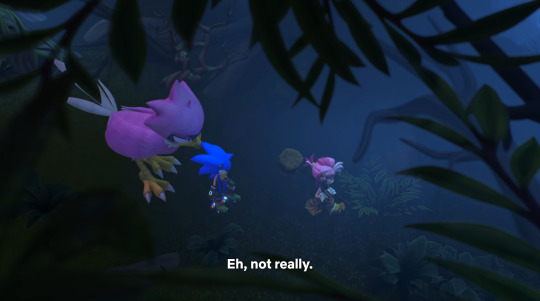
He could have easily said it in a more jokey way, but his tone (and the wide camera shot) gives me the impression that this isn't a trait of his that he feels especially positive about.
It's not cool or funny to him, at least not in this instance; it's just something he does, which further proves to me that it's more of an unconscious stim than anything else.
On the topic of the jungle world though, it also shows us a couple instances of him not being able to read others' intentions very well. Prim lies to him about knowing what the Prism shard is, and Thorn uses him to get to said shard - and despite how hostile they are, he takes both of them at their word.
He only realizes Thorn's intentions after she hits him across the clearing - not for the first time that day, mind you - and Sonic berates himself a little for not seeing this coming.
But it's not like this is the only time he has difficulty understanding intent; just look at his interactions with Shadow.

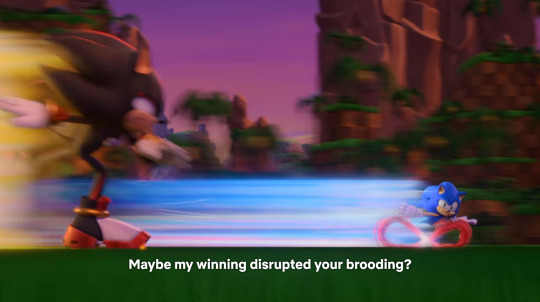
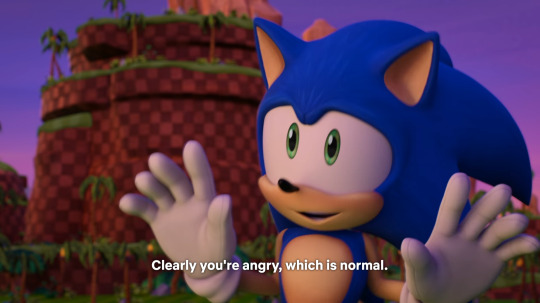
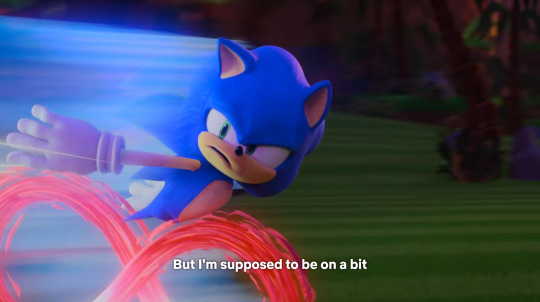

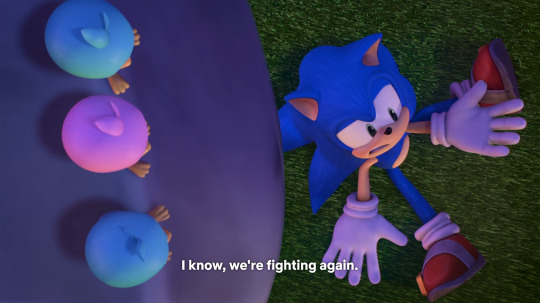
This is not the behavior of someone who understands why Shadow's picking a fight with him. He doesn't understand the implications of "you literally shook the world" because he doesn't know about the Weirder aspects of the explosion. In his mind, he just messed up a mountain.
Though I think his attitude implies another thing about his dynamic with Shadow that might explain why he was so quick to dismiss what he was talking about, which is. I don't think Sonic usually understands why they fight??
Shadow is a person of few words and Sonic has a hard time picking up on subtleties, that's a recipe for miscommunication already. And if Sonic's already predisposed to thinking that Shadow fights him Just Because, then of course he didn't take this particular instance seriously.
Though going back to "he only registered the physical effect of the explosion," Sonic is actually pretty consistent with understanding things that are tangible a lot better than anything else. Case in point: that One Palm Tree
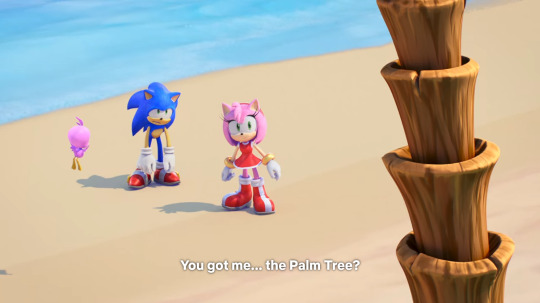

His first reaction to seeing it presented as a gift is that it must be a trick. because he doesn't see the tangible point of the tree, and isn't enough of a symbolism guy to see the sentimental point of it, either.
Don't get me wrong, he is being insensitive here, but I don't think it's on purpose in any way. Look at his body language and expressions:
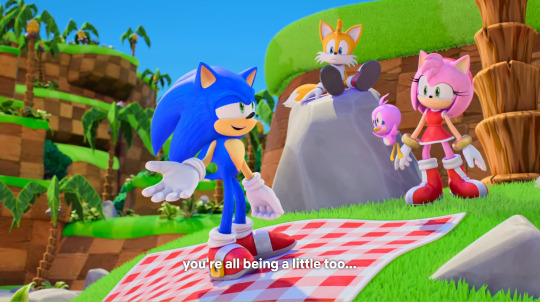
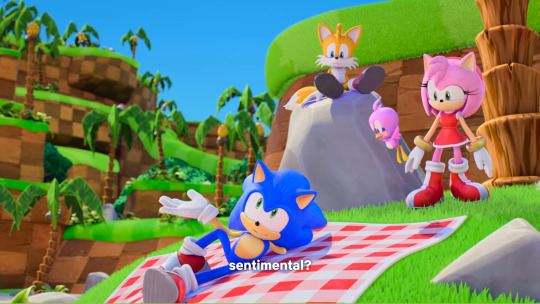
Even as he's getting on their case for being too sentimental, he's not unhappy or uncomfortable with them. He's just completely failing to recognize that this was supposed to be a big deal for them, so he's treating it way more casually than is appropriate.
Which is like. a classic social flub for neurodivergent folks
(Quick side note - this specific "huh" that he makes as Tails is flying away before Sonic realizes he's upset is a whole mood. I don't know how to explain it but this is Exactly what it feels like when you can sorta tell something's not clicking but you don't know what yet)
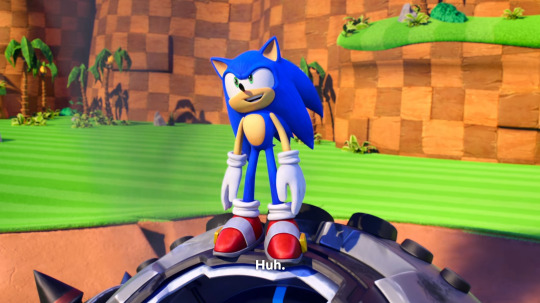
(Look at him. brain static)
I could go on with the detailed explanations but some of that would just be me repeating past posts I've made, so I'll leave it at "he is clearly not handling change well either" and link back to an example.
So anyway, this is what I meant when I said that so much of the show is impacted by Sonic being neurodivergent. It affects how we hear his thoughts as viewers, it affects his ability to understand and connect with his friends, it's why he dismisses Shadow, it's why he impulsively smashes the Paradox Prism, the list goes on.
And he's not stupid because of any of these traits, either. None of what I've described has to do with intelligence, but I've seen "Sonic is too dumb" as a reason to criticize the show, and that's just not what's happening here.
If anything, I'm actually really impressed with how well the writers have managed to portray a more nuanced take on what a character with ADHD would look like. Because he's not just being hyperactive and chatty, you can tell it affects how he perceives things too.
Which is a much bigger part of the overall experience, and it's really cool to see in a cartoon like this - and in the lovable main character, to boot! Who cherishes his friends despite his struggles to understand them! Why is it so good!
In conclusion Sonic is the ADHD king we both needed and deserved, thanks for coming to my TED talk
#This still holds true now that Sonic Prime is over#I didn't realize why on my first watch but Prime Sonic felt shockingly relatable to me#This post just made it click#Prime Sonic is definitely neurodivergent and GREAT representation#I can't tell whether it was intentional or not on the writers' part but I deeply appreciate the result either way#sonic prime#sonic the hedgehog#analysis#adhd representation#neurodiversity#analysis reblog
7K notes
·
View notes
Text

2022 cartoons that take inspiration from the early 2000s and subvert expectations by serving legendary overconfident characters a huge slice of humble pie, my beloved.
#In Sonic’s defense he did this plenty of times in the games he knew he would survive the cannon#Puss on the other hand had no excuse for how stupid that was#But it was hilarious#I love these reckless fluffy goofballs so much#sonic prime#puss in boots the last wish#sonic the hedgehog#puss in boots#2 nickels#tumblr memes
14 notes
·
View notes